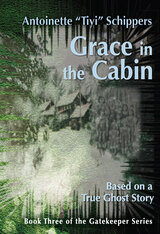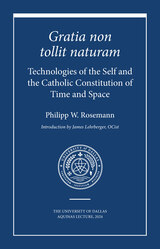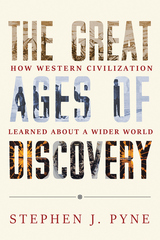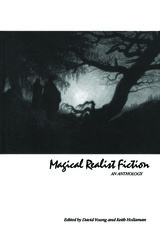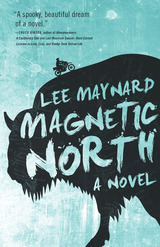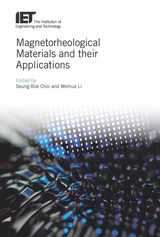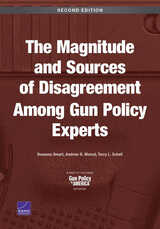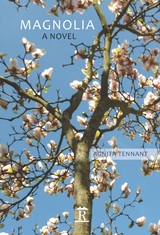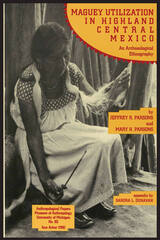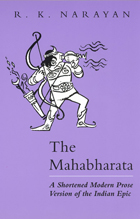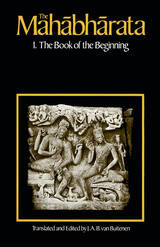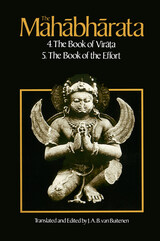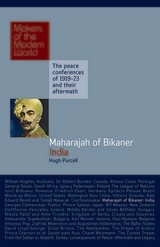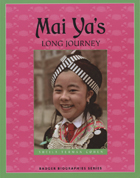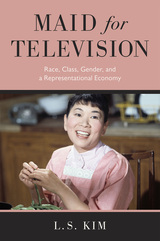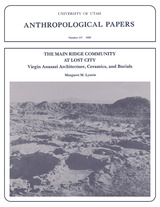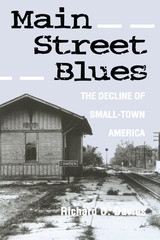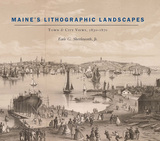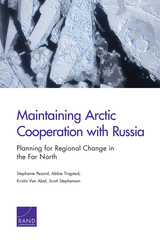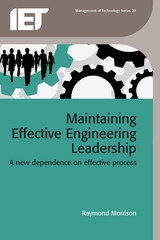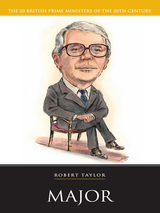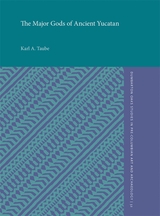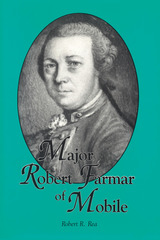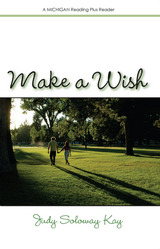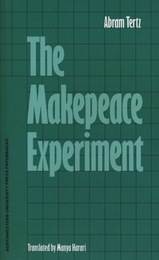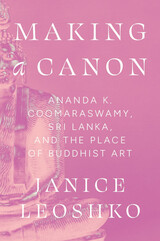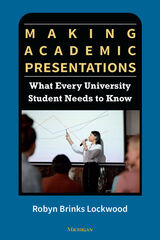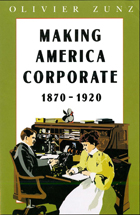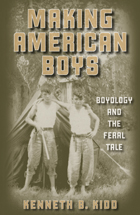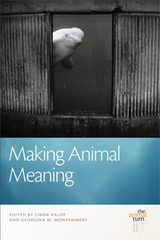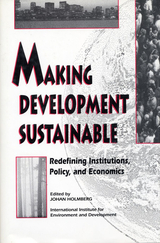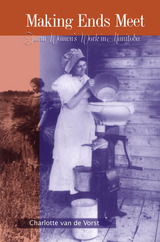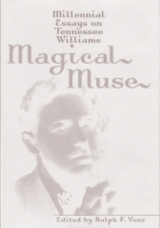 Magical Muse: Millennial Essays on Tennessee Williams
Edited by Ralph F. Voss
University of Alabama Press, 2002 In this unique and engaging collection, twelve essays celebrate the legacy of one of America's most important playwrights and investigate Williams's enduring effect on America's cultural, theatrical, and literary heritage.
Like Faulkner before him, Tennessee Williams gave universal appeal to southern characters and settings. His major plays, from Cat on a Hot Tin Roof and The Glass Menagerie to A Streetcar Named Desire and Night of the Iguana, continue to capture America's popular imagination, a significant legacy. Though he died in 1983, only recently have Williams's papers become available to the public, bringing to light a number of intriguing discoveries—letters, drafts, and several unpublished and unproduced plays. These recent developments make a reassessment of Williams's life and work both timely and needed.
The essays in this collection originated as presentations at the 27th annual Alabama Symposium on English and American Literature at The University of Alabama in 1999. The book addresses a wide range of topics, among them the influence of popular culture on Williams's plays, and, in turn, his influence on popular culture; his relationship to Hollywood and his struggles with censorship, Hollywood standards, and the competing vision of directors such as Elia Kazan; his depictions of gender and sexuality; and issues raised by recently discovered plays.
Anyone interested in American literature and drama will find this collection of fresh, accessible essays a rewarding perspective on the life, work, and legacy of one of the bright stars of American theatre.
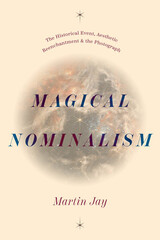 Magical Nominalism: The Historical Event, Aesthetic Reenchantment, and the Photograph
Martin Jay
University of Chicago Press, 2025 A bold and wide-ranging study across centuries, examining the conflict between “conventional” and “magical” nominalism in philosophy, history, aesthetics, political theory, and photography.
In this magisterial new book, intellectual historian Martin Jay traces the long-standing competition between two versions of nominalism—the “conventional” and the “magical.” Since at least William of Ockham, according to Jay, the conventional form of nominalism has contributed to the disenchantment of the world, by viewing general terms as nothing more than mere names we use to group particular objects together, rejecting the idea that they refer to a further, “higher” reality. Magical nominalism, instead, performs a reenchanting function, by investing proper names, disruptive events, and singular objects with an auratic power of their own. Drawing in part on Jewish theology, it challenges the elevation of the constitutive subject resulting from Ockham’s reliance on divine will in his critique of real universals.
Starting with the fourteenth-century revolution of nominalism against Scholastic realism, Jay unpacks various “counterrevolutions” against nominalism itself, including a magical alternative to its conventional form. Focusing on fundamental debates over the relationship between language, thought, and reality, Jay illuminates connections across thinkers, disciplines, and vast realms of human experience. Ranging from theology and philosophy of history to aesthetics and political theory, this book engages with a range of artists and thinkers, including Adorno, Ankersmit, Badiou, Barthes, Bataille, Benjamin, Blumenberg, Derrida, Duchamp, Foucault, Kracauer, Kripke, and Lyotard. Ultimately, Magical Nominalism offers a strikingly original way to understand humanity’s intellectual path to modernity.
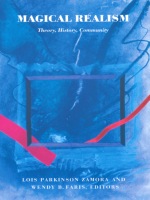 Magical Realism: Theory, History, Community
Lois Parkinson Zamora and Wendy B. Faris, eds.
Duke University Press, 1995 Magical realism is often regarded as a regional trend, restricted to the Latin American writers who popularized it as a literary form. In this critical anthology, the first of its kind, editors Lois Parkinson Zamora and Wendy B. Faris show magical realism to be an international movement with a wide-ranging history and a significant influence among the literatures of the world. In essays on texts by writers as diverse as Toni Morrison, Günter Grass, Salman Rushdie, Derek Walcott, Abe Kobo, Gabriel García Márquez, and many others, magical realism is examined as a worldwide phenomenon.
Presenting the first English translation of Franz Roh’s 1925 essay in which the term magical realism was coined, as well as Alejo Carpentier’s classic 1949 essay that introduced the concept of lo real maravilloso to the Americas, this anthology begins by tracing the foundations of magical realism from its origins in the art world to its current literary contexts. It offers a broad range of critical perspectives and theoretical approaches to this movement, as well as intensive analyses of various cultural traditions and individual texts from Eastern Europe, Asia, North America, Africa, the Caribbean, and Australia, in addition to those from Latin America. In situating magical realism within the expanse of literary and cultural history, this collection describes a mode of writing that has been a catalyst in the development of new regional literatures and a revitalizing force for more established narrative traditions—writing particularly alive in postcolonial contexts and a major component of postmodernist fiction.
Magical Realist Fiction: An Anthology
Edited by David Young and Keith Hollaman
Oberlin College Press, 1984 This capacious anthology has selections from the authors you would expect to find, from others you may be less familiar with, and from writers you might not expect to show up in this company. The result is a treasure trove of unusual fiction, one of the most exciting anthologies to appear in the last decade. This is a poet's companion, a student's delight, great bedside reading: the kind of book you'd take to a desert island!
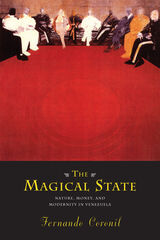 The Magical State: Nature, Money, and Modernity in Venezuela
Fernando Coronil
University of Chicago Press, 1997 In 1935, after the death of dictator General Juan Vicente Gómez, Venezuela consolidated its position as the world's major oil exporter and began to establish what today is South America's longest-lasting democratic regime. Endowed with the power of state oil wealth, successive presidents appeared as transcendent figures who could magically transform Venezuela into a modern nation. During the 1974-78 oil boom, dazzling development projects promised finally to effect this transformation. Yet now the state must struggle to appease its foreign creditors, counter a declining economy, and contain a discontented citizenry. In critical dialogue with contemporary social theory, Fernando Coronil examines key transformations in Venezuela's polity, culture, and economy, recasting theories of development and highlighting the relevance of these processes for other postcolonial nations. The result is a timely and compelling historical ethnography of political power at the cutting edge of interdisciplinary reflections on modernity and the state.
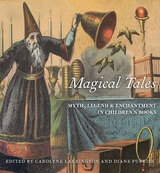 Magical Tales: Myth, Legend, and Enchantment in Children's Books
Edited by Carolyne Larrington and Diane Purkiss
Bodleian Library Publishing, 2013 A faun carrying an umbrella. A hobbit who makes his home in a hole in the ground. An ill-treated schoolboy with a secret and a scar. Fantasy is among the most beloved genres in children’s literature— and its offerings are often just as eagerly anticipated by adults. But how is it that writers like J. K. Rowling and Philip Pullman are able to create such remarkable images?
Magical Tales traces the origin of the genre back through Norse mythology, Arthurian legend, and medieval literature. Drawing on manuscripts and rare books in the renowned collection of the Bodleian Library, the essays turn the spotlight on spell books; grimoires, or magical textbooks; and books of legend and myth whose themes writers like J. R. R. Tolkien and C. S. Lewis incorporated into their work, inspiring generations of writers that extend to the present day. In serving as a source of inspiration for later literary works, the contributors show, myths and legends have themselves been altered in interesting ways.
Richly illustrated, Magical Tales offers an enchanting take on the development of this wildly popular genre.
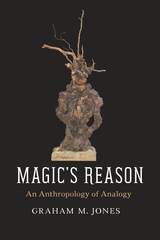 Magic's Reason: An Anthropology of Analogy
Graham M. Jones
University of Chicago Press, 2017 In Magic’s Reason, Graham M. Jones tells the entwined stories of anthropology and entertainment magic. The two pursuits are not as separate as they may seem at first. As Jones shows, they not only matured around the same time, but they also shared mutually reinforcing stances toward modernity and rationality. It is no historical accident, for example, that colonial ethnographers drew analogies between Western magicians and native ritual performers, who, in their view, hoodwinked gullible people into believing their sleight of hand was divine.
Using French magicians’ engagements with North African ritual performers as a case study, Jones shows how magic became enshrined in anthropological reasoning. Acknowledging the residue of magic’s colonial origins doesn’t require us to dispense with it. Rather, through this radical reassessment of classic anthropological ideas, Magic’s Reason develops a new perspective on the promise and peril of cross-cultural comparison.
 Magic’s Translations: Reality Politics in Colonial Indonesia
Margaret J. Wiener
Duke University Press, 2025 “Do you believe in magic?” This familiar question suggests magic is easily recognized but unreal. In Magic’s Translations, Margaret J. Wiener argues that such views are shaped by historical power struggles, especially in Europe’s relations with the wider world. Focusing on nineteenth- and twentieth-century Dutch interactions with Indonesians, Wiener reveals how colonial agents framed unfamiliar practices, practitioners, and objects as “magic,” rendering distinct phenomena fundamentally alike and advancing colonizing projects that deemed magic antithetical to reason and reality. While colonial authorities, including ethnologists, mobilized the concept of magic to differentiate Europeans from Indonesians, nature from culture, reason from superstition, and fact from fetish, their efforts produced unexpected outcomes: Some Indonesian artifacts and acts not only retained their power but invaded European experiences. As anthropologists were among the key translators of magic throughout the world, Wiener intersperses accounts of magic’s translations in the Indies with reflections on anthropology’s ongoing engagement with the concept. She demonstrates that magic became an object of expert knowledge, political control, and popular fascination, rather than a self-evident category or relic of naïve belief.
 Magna Carta: history, context and influence: Papers delivered at Peking University on the 800th anniversary of Magna Carta
Edited by Lawrence Goldman
University of London Press, 2018 This book examines the history and influence of Magna Carta in British and American history. In a series of essays written by notable British specialists, it considers the origins of the document in the political and religious contexts of the thirteenth century, the relevance of its principles to the seventeenth century disputes that led to the Civil War, the uses made of Magna Carta to justify the American Revolution, and its inspiration of the radical-democratic movement in Britain in the early nineteenth century. The introductory essay considers the celebration of Magna Carta's 800th anniversary in 2015 in relation to ceremonials and remembrance in Britain in general. Given as papers to a joint conference of British and Chinese historians in Beijing in 2015, these essays provide a clear and insightful overview of the origins and impact of a medieval document that has shaped the history of the world. The open access edition of this book can be found at http://humanities-digital-library.org/index.php/hdl/catalog/book/goldman.
 Magna Carta: Its Role in the Making of the English Constitution, 1300-1629
Faith Thompson
University of Minnesota Press, 1948 Magna Carta was first published in 1948. Minnesota Archive Editions uses digital technology to make long-unavailable books once again accessible, and are published unaltered from the original University of Minnesota Press editions.This important study in English constitutional history is the story of the Magna Carta from the end of the reign of Edward I to the dissolution of parliament and the completion of Sir Edward Coke’s Commentary (1300-1629).Miss Thompson surveys the various ways, practical and theoretical, in which the Charter was used by groups and individuals in English society. She examines the pertinent sources and finds that the Charter was never eclipsed in the later Middle Ages or even in the Tudor period and that its reinterpretation in the early Stuart period was not an abrupt and novel phenomenon. The statesmen who transformed a charter of feudal “liberties” into a charter of “liberty of the subject” were using a document with a long history and a reputation already made in plea rolls and Year Books, parliament and statute rolls, law treatises, and even chronicles.Miss Thompson provides considerable background material to support her emphasis on this process of interpretation, and she clearly interprets the character and motives of successive sponsors of the Charter.The value of Miss Thompson’s study is in the unusual thoroughness of her treatment of Magna Carta and in her corrections of misconceptions about the role the Magna Carta has played in the making of the English constitution.
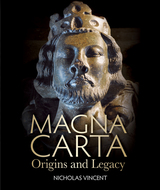 Magna Carta: Origins and Legacy
Nicholas Vincent
Bodleian Library Publishing, 2015 Magna Carta is the most famous document in English history. And yet its survival is purely accidental. King John, who negotiated the document with his rebellious barons, had no intention of honouring its contents. Annulled by the pope within weeks of being issued, it was destined to oblivion. But with the sudden death of John, all of this changed. Magna Carta was reissued by the regents of the boy King Henry III as an apology for past misrule and as a promise of future good government. It was reissued on successive occasions and repeatedly cited in legal cases in the following centuries. Later, it played a part in conflicts such as the English Civil War and the American Revolutionary War. Echoes of Magna Carta are to be found in the Declaration of Independence and the Constitution. It continues to be cited today as a touchstone of fundamental universal freedoms.
This book tells the story of the birth and development of Magna Carta from its origins to the modern day. It also reproduces and describes, for the very first time, every surviving copy of the Great Charter, as well as related charters of the period, including various new discoveries. It addresses the previously unanswered question of how the charter was published and disseminated to the shires of England and includes a chapter on the charter's scribes and sealing, supplying a truly unique insight into both the creation and afterlife of the most fundamental legal document in British history.
Magnesium and Man
Warren E. C. Wacker
Harvard University Press, 1980 Magnesium and Man provides the physician with a brief yet comprehensive overview of magnesium as a biochemical agent in human metabolism and disease. The first half of the book introduces techniques of measurement as well as the role of magnesium in normal biochemistry and physiology. The remaining chapters discuss magnesium squarely in the context of human disease: neonatal deficiency, thyroid disease, kidney disease, malignant osteolytic disease, alcoholism, and cirrhosis. Written by a clinician who is also a dominant figure in magnesium research, this book greatly advances communication between laboratory and clinic and will be essential reading for anyone involved in patient care.
Magnet Theatre: Three Decades of Making Space
Edited by Megan Lewis and Anton Krueger
Intellect Books, 2015 Cape Town’s Magnet Theatre has been a force in South African theater for three decades, a crucial space for theater, education, performance, and community throughout a turbulent period in South African history. Offering a dialogue between internal and external perspectives, as well as perspectives from performers, artists, and scholars, this book analyzes Magnet’s many productions and presents a rich compendium of the work of one of the most vital physical theater companies in Africa.
Magnetic North
LEE MAYNARD
West Virginia University Press, 2015 In Magnetic North an aging warrior and his best friend—perhaps his only friend—ride motorcycles to Alaska, with the ultimate goal of riding to the Arctic Circle. It is a ride that mirrors their lives, a ride that causes old stories, old trials, old darkness to come, once again, through the spinning wheels of the machines they are riding. Morgan is a man who can't give it up. His propensity toward violence has followed him through all the days of his life, and it follows him now. Slade has shared much of Morgan's life, and he has been the one of the rare stabilizing factors in that life. Without Slade, it is clear that Morgan has no guidance, no goals, and no potential for living much longer than his next encounter with . . . almost anything. And so the two old friends ride out from New Mexico and Colorado—heading north.
Magnetorheological Materials and their Applications
Seung-Bok Choi
The Institution of Engineering and Technology, 2019 The rheological properties of magnetorheological (MR) materials, such as their viscosity and dynamic modulus, can be tuned or controlled by changing the intensity of the magnetic field using appropriate control schemes. Thanks to their robustness, performance and smart properties, numerous studies have been undertaken on the development of new MR materials, and microscopic and macroscopic modelling approaches. Novel applications include engine mounts and clutch systems in the automotive industry, shock absorbing safety devices for cockpit seats in aerospace, and shock absorption from movement in semi-active human prosthetic legs.
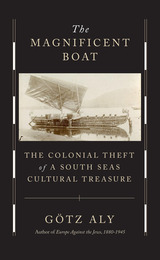 The Magnificent Boat: The Colonial Theft of a South Seas Cultural Treasure
Götz Aly
Harvard University Press, 2023 From an eminent and provocative historian, a wrenching parable of the ravages of colonialism in the South Pacific.
Countless museums in the West have been criticized for their looted treasures, but few as trenchantly as the Humboldt Forum, which displays predominantly non-Western art and artifacts in a modern reconstruction of the former Royal Palace in Berlin. The Forum’s premier attraction, an ornately decorated fifteen-meter boat from the island of Luf in modern-day Papua New Guinea, was acquired under the most dubious circumstances by Max Thiel, a German trader, in 1902 after two decades of bloody German colonial expeditions in Oceania.
Götz Aly tells the story of the German pillaging of Luf and surrounding islands, a campaign of violence in which Berlin ethnologists were brazenly complicit. In the aftermath, the majestic vessel was sold to the Ethnological Museum in the imperial capital, where it has remained ever since. In Aly’s vivid telling, the looted boat is a portal to a forgotten chapter in the history of empire—the conquest of the Bismarck Archipelago. One of these islands was even called Aly, in honor of the author’s great-granduncle, Gottlob Johannes Aly, a naval chaplain who served aboard ships that helped subjugate the South Sea islands Germany colonized.
While acknowledging the complexity of cultural ownership debates, Götz Aly boldly questions the legitimacy of allowing so many treasures from faraway, conquered places to remain located in the West. Through the story of one emblematic object, The Magnificent Boat artfully illuminates a sphere of colonial brutality of which too few are aware today.
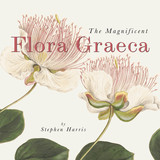 The Magnificent Flora Graeca: How the Mediterranean Came to the English Garden
Stephen Harris
Bodleian Library Publishing, 2007
The publishing of the Flora Graeca was a landmark event in 1830. Only 25 copies were published, due to the book’s size of 10 double folio volumes and its numerous illustrations, and it cost over £620, a colossal sum at the time. The Flora Graeca brought together beautiful renderings of the fruits of the travels of British scientist John Sibthorp, who made multiple trips to the eastern Mediterranean in the early nineteenth century to collect a rich array of exotic floral specimens. Now The Magnificent Flora Graeca chronicles Sibthorp’s immense undertaking, including brilliant selections from his groundbreaking volume.
The story of the expeditions of Sibthorp and his renowned illustrator Ferdinand Bauer is a tale replete with larger-than-life characters and adventures on land and sea. Harris profiles the lives of Sibthorp, Bauer, and other leading characters, and explores the Flora Graeca’s rich cultural and scientific legacy. Sibthorp’s pioneering adventures unearthed floral specimens previously unknown to science, as he collected the originals of such popular garden flowers as the Crocus flavus ssp. flavus, the parent of the Golden Yellow; and Cyprus’s Cyclamen persicum, the parent of the widely grown garden cyclamens species.
This new volume, drawn from photographs of Sibthorp’s remarkably well-preserved specimens and luminous reproductions of the original watercolors and engravings by Bauer, features more images from the Flora Graeca than have ever been published since its first printing.
A fascinating treasure of floral wonders, The Magnificent Flora Graeca is an essential addition to the bookshelf for the plant lover or anyone curious about the natural history behind their beloved garden retreats.
 A Magnificent Loneliness
Allison Benis White
Four Way Books, 2025 “I remember // once, turning to leave, a black purse over her shoulder. . .” Oneiric and surreal as always, Allison Benis White attempts to mediate, if not make sense of, inconceivable bereavement in her fifth collection of poetry. “A black purse, / over her living shoulder, Love said nothing to me.”
Ethereal, airy, and spare at once, A Magnificent Loneliness is a dialogue with ghosts. White, whose previous work won the Rilke Prize and the Four Way Books Levis Prize judged by Claudia Rankine, assembles these pages as an ekphrastic and epistolary record of her solitary journey through loss. These poems relate to artwork, the history of artistic practice, and inherited lore to broker an oblique and piecewise conversation concerning pain too vast to articulate all at once. “I don’t know how to love the world but to love / her leaving.” These lyrical iterations represent White’s attempts to comprehend the individual suffering of being alive, and to metabolize the grief of women’s epidemic disappearance, literal and spiritual, through sickness and despair. Through those efforts, she illuminates a magnificent loneliness—the privilege of being alive to our anguish, of missing someone dearly because someone dear existed—and a reason for not yet departing that struggle. “How to leave / the world but to turn to leave her— / but to turn my head back / to see her.”
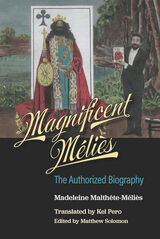 Magnificent Méliès: The Authorized Biography
Madeleine Malthête-Méliès, translated by Kel Pero, edited by Matthew Solomon
University of Michigan Press, 2022 The films of Georges Méliès (1861–1938) are landmarks in the early history of narrative filmmaking and cinematic special effects. He was a harbinger of modern aesthetics and media manipulation, and this book, written by his granddaughter, is the only one that tells his full story. Magnificent Méliès is a thoroughly researched but highly accessible book that is a crucial source for the scholar and an entertaining read for the nonspecialist. The core of the biography provides detailed accounts of Méliès’ filmmaking years (1896–1913), from his first motion pictures shortly after the public premiere of the Lumière Cinématographe through such worldwide successes as his film Voyage dans la Lune (A Trip to the Moon) and his eventual marginalization by the very industry he had helped to found. The biography also chronicles Méliès’ formative work as director of Paris’s preeminent magic theater, the Théâtre Robert-Houdin; his subsequent career staging operettas for the Théâtre des Variétés Artistiques (1917–1923) in Montreuil on the site of one of his former film studios; and his later years selling toys and candy at the Gare Montparnasse (1926–1932) before being rediscovered by journalists and the avant-garde. These and other fascinating chapters highlight the remarkable range of Méliès’ creative work while suggesting how his singular life was nevertheless shaped by the seismic historical shifts of Second Empire and Third Republic France.
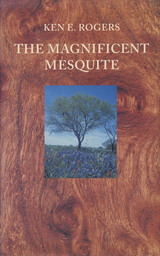 The Magnificent Mesquite
By Ken E. Rogers
University of Texas Press, 2000 "This book is one-of-a-kind. It is the only book that I'm aware of that summarizes the biology, ecology, uses, and management of mesquite.... It is the most complete book in print on mesquite." —C. Wayne Hanselka, Associate Department Head and Extension Program Leader for Rangeland Ecology and Management, Texas Agricultural Extension Service A reliable source of food and shelter even in the severest droughts, the mesquite tree sustained American Indians in the Southwest for centuries. Today, mesquite is popular for barbecuing, woodworking, furniture making, flooring, sculpture, jewelry, and food products ranging from honey to jelly and syrup. Even ranchers, who once fought to eradicate mesquite, have come to value its multiple uses on well-managed rangeland. In this book written especially for a general readership, one of the world's leading authorities on mesquite presents a wealth of information about its natural history and commercial, agricultural, and woodworking uses. Ken Rogers describes the life cycle, species, and wide distribution of the mesquite, which is native or naturalized not only in the Southwest and Mexico, but also in India, Africa, Australia, South America, and Hawaii. He discusses the many consumer and woodworker uses of mesquite at length-even giving instructions for laying a mesquite wood floor and making mesquite bean jelly. He also looks into the ways that people are using mesquite in nature, from rangeland management in the Southwest to desertification prevention in arid countries.
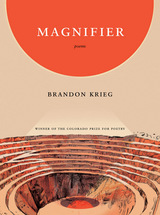 Magnifier
Brandon Krieg
University Press of Colorado, 2019 A magnifier praises what’s larger and a magnifier concentrates poisons. Brandon Krieg’s Magnifier is a book of spirits invoked by destroyers. It trains its gaze on the deep dependencies we are urged daily to hide from ourselves and interrogates the ways we insulate ourselves from the environmental and social degradations we perpetrate, often at many removes. Magnifier is a book of systems of our collective making that have taken on a life of their own, which we pretend to control. It is a book mourning Romanticism’s naiveté, even as it cannot help but engage in a search for meanings not commercial or ideological in the more-than-human world. And yet, the poems in Magnifier refuse to let slip from their focus the human everywhere, or to retreat into a mystifying “wilderness.” If a maple seed is to astonish, it must do so in the neighborhood of a reactor. Formally various, balanced on the edge of order and chaos, the poems in Magnifier cry out for “something more” from the “nothing but” even as they zero in on the damage we have done.
The Magnitude and Sources of Disagreement Among Gun Policy Experts, Second Edition
Rosanna Smart
RAND Corporation, 2021 This report describes combined results from two fieldings of a survey of gun policy experts. In particular, respondents estimated the likely effects of 19 gun policies on ten outcomes, such as firearm homicides and the right to bear arms. Researchers use the results to identify where experts agree and disagree the most and whether disagreements stem from assumptions about the effects of gun policies or from differences in policy objectives.
Magnolia: A Novel
Agnita Tennant
Amsterdam University Press, 2015 South Korea 1957. Sukey, an intelligent graduate with much promise, falls in love with a man, Kwon, who confesses to her that he has been a North Korean spy. It is four years since the Korean War ended in a cease-fire (having started on 25 June 1950). Even though fighting is suspended, hostility and enmity towards the North is the social norm. With anti-spy campaigns, street and hotel searches, and arrests of any suspect, citizens are urged to be vigilant and to report on any suspicious goings-on. When Sukey takes on Kwon as her lover, she has little idea of what it will be like to keep an ex-spy hidden away from society, her family and friends. Her world changes overnight, and within a few months she is reduced to a nervous wreck…
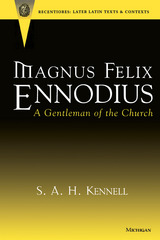 Magnus Felix Ennodius: A Gentleman of the Church
S. A. H. Kennell
University of Michigan Press, 2000 Magnus Felix Ennodius (474-521), deacon of Milan and bishop of Pavia in the turbulent years after the fall of the Roman Empire in the West, was a prolific writer of letters, poetry, speeches, and pamphlets on the controversies that beset the church in his day. In the Middle Ages, he was read as a model of style and source of canon law. More recently, however, Ennodius' writings have been denigrated as the vapid product of a frivolous mind more concerned with form than content. Magnus Felix Ennodius: A Gentleman of the Church sets the record straight by restoring Ennodius to his social and literary context. Ennodius stands revealed as a man on the cusp of the ancient and medieval worlds, his thought still shaped according to classical norms, but his writings informed with a sensibility that prefigures that of the Christian Middle Ages. As the only book-length study of Ennodius, here the author explores all aspects of Ennodius' life and literary production to augment the collective understanding of him on two major fronts, rhetoric and meaning, so that he can take his place as an important author and historical figure. Deeply insightful, and refreshingly original, the author breaks new ground in studying this period of history, so often overshadowed by the classical and middle ages that immediately precede and succeed it.
S. A. H. Kennell is Adjunct Professor of Classics, Memorial University of Newfoundland.
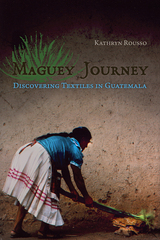 Maguey Journey: Discovering Textiles in Guatemala
Kathryn Rousso
University of Arizona Press, 2010 The name "maguey" refers to various forms of the agave and furcraea genus, also sometimes called the century plant. The fibers extracted from the leaves of these plants are spun into fine cordage and worked with a variety of tools and techniques to create textiles, from net bags and hammocks to equestrian gear.
In this fascinating book, Kathryn Rousso, an accomplished textile artist, takes a detailed look at the state of maguey culture, use, and trade in Guatemala. She has spent years traveling in Guatemala, highlighting maguey workers’ interactions in many locations and blending historical and current facts to describe their environments. Along the way, Rousso has learned the process of turning a raw leaf into beautiful and useful textile products and how globalization and modernization are transforming the maguey trade in Guatemala.
Featuring a section of full-color illustrations that follow the process from plant to weaving to product, Maguey Journey presents the story of this fiber over recent decades through the travels of an impassioned artist. Useful to cultural anthropologists, ethnobotanists, fiber artists, and interested travelers alike, this book offers a snapshot of how the industry stands now and seeks to honor those who keep the art alive in Guatemala.
Maguey Utilization in Highland Central Mexico: An Archaeological Ethnography
Jeffrey R. Parsons and Mary H. Parsons
University of Michigan Press, 1990 The maguey plant plays a central role in cultural adaptation and cultural change in highland Mesoamerica. This book is a comprehensive study of the plant and its use. Includes chapters on maguey cultivation and pulque production, maguey fiber processing and spinning, and the archaeological implications of the available ethnographic and historic information about maguey utilization.
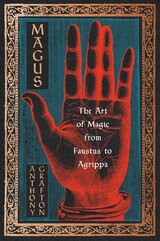 Magus: The Art of Magic from Faustus to Agrippa
Anthony Grafton
Harvard University Press, 2023 A revelatory new account of the magus—the learned magician—and his place in the intellectual, social, and cultural world of Renaissance Europe.
In literary legend, Faustus is the quintessential occult personality of early modern Europe. The historical Faustus, however, was something quite different: a magus—a learned magician fully embedded in the scholarly currents and public life of the Renaissance. And he was hardly the only one. Anthony Grafton argues that the magus in sixteenth-century Europe was a distinctive intellectual type, both different from and indebted to medieval counterparts as well as contemporaries like the engineer, the artist, the Christian humanist, and the religious reformer. Alongside these better-known figures, the magus had a transformative impact on his social world.
Magus details the arts and experiences of learned magicians including Marsilio Ficino, Pico della Mirandola, Johannes Trithemius, and Heinrich Cornelius Agrippa. Grafton explores their methods, the knowledge they produced, the services they provided, and the overlapping political and social milieus to which they aspired—often, the circles of kings and princes. During the late fifteenth and early sixteenth centuries, these erudite men anchored debates about licit and illicit magic, the divine and the diabolical, and the nature of “good” and “bad” magicians. Over time, they turned magic into a complex art, which drew on contemporary engineering as well as classical astrology, probed the limits of what was acceptable in a changing society, and promised new ways to explore the self and exploit the cosmos.
Resituating the magus in the social, cultural, and intellectual order of Renaissance Europe, Grafton sheds new light on both the recesses of the learned magician’s mind and the many worlds he inhabited.
 Magus: The Art of Magic from Faustus to Agrippa
Anthony Grafton
Harvard University Press A Seminary Co-op Notable Book
PROSE Award in European History
“Marvellously readable . . . Not for nothing is Grafton renowned as today’s leading historian of Renaissance intellectual culture . . . as erudite as it is enchanting.” —Literary Review
“A brilliantly vivid exercise in intellectual history, as told through the biographies of the early modern magi, which will stir the thoughts of everyone who reads it. —New Statesman
“Magus offers a rich set of observations on an oft-neglected intellectual tradition during a turning point in Western thought . . . Magic is once again beginning to merit serious study in the academy. —Chronicle of Higher Education
In literary legend, Faustus is the quintessential occult personality. The historical Faustus, however, was something quite different: a magus—a learned magician fully embedded in the scholarly currents and public life of his time. And he was hardly the only one. Anthony Grafton argues that the magus in Renaissance Europe was a distinctive intellectual type, indebted to medieval counterparts as well as contemporaries like the engineer, artist, Christian humanist, and religious reformer. Alongside these better-known figures, the magus had a transformative impact on his social world.
Magus details the arts and experiences of learned magicians including Marsilio Ficino, Pico della Mirandola, Johannes Trithemius, and Heinrich Cornelius Agrippa. These erudite men were at the center of debates concerning licit and illicit magic, the divine and the diabolical. Over time, they turned magic into a complex art, which drew on contemporary engineering as well as classical astrology, probed the limits of what was acceptable in a changing society, and promised new ways to explore the self and the cosmos.
Resituating the magus in the cultural and intellectual order of Renaissance Europe, Grafton sheds new light on both the recesses of the learned magician’s mind and the world he helped to build.
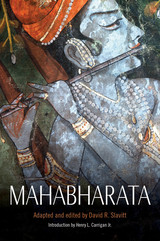 Mahabharata
Adapted and edited by David R. Slavitt
Northwestern University Press, 2015 Within its 200,000 verse lines in Sanskrit the Mahabharata takes on many roles: epic poem, foundational text of Hinduism, and, more broadly, the engaging story of a dynastic struggle and the passing of an age when man and gods intermingled. David R. Slavitt’s sparkling new edition condenses the epic for the general reader. At its core, the Mahabharata is the story of the rivalry between the Pandavas and the Kauravas, two related noble families who are struggling for control of a kingdom in ancient northern India. Slavitt’s readable, plot-driven, single-volume account describes an arc from the conception and birth of Bhishma to that hero's death, while also introducing the four goals of life at the center of Hinduism: dharma (righteousness, morality, duty), artha (purpose), kāma (pleasure), and moksa (spiritual liberation). The Mahabharata is engaging, thrilling, funny, charming, and finally awesome, with a range in timbre from the impish naivete of fairy tales to the solemnity of our greatest epics, and this single-volume edition is the best introduction available.
The Mahabharata: A Shortened Modern Prose Version of the Indian Epic
R. K. Narayan
University of Chicago Press, 2000 Growing from an oral tradition of ballads based on historic events in India, the Mahabharata was passed down and extended through the centuries, becoming the longest poem ever written. R. K. Narayan provides a superb rendition in an abbreviated and elegant retelling of this great epic.
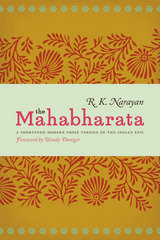 The Mahabharata: A Shortened Modern Prose Version of the Indian Epic
R. K. Narayan
University of Chicago Press, 2013 The Mahabharata tells a story of such violence and tragedy that many people in India refuse to keep the full text in their homes, fearing that if they do, they will invite a disastrous fate upon their house. Covering everything from creation to destruction, this ancient poem remains an indelible part of Hindu culture and a landmark in ancient literature.
Centuries of listeners and readers have been drawn to The Mahabharata, which began as disparate oral ballads and grew into a sprawling epic. The modern version is famously long, and at more than 1.8 million words—seven times the combined lengths of the Iliad and Odyssey—it can be incredibly daunting.
Contemporary readers have a much more accessible entry point to this important work, thanks to R. K. Narayan’s masterful translation and abridgement of the poem. Now with a new foreword by Wendy Doniger, as well as a concise character and place guide and a family tree, The Mahabharata is ready for a new generation of readers. As Wendy Doniger explains in the foreword, “Narayan tells the stories so well because they’re all his stories.” He grew up hearing them, internalizing their mythology, which gave him an innate ability to choose the right passages and their best translations.
In this elegant translation, Narayan ably distills a tale that is both traditional and constantly changing. He draws from both scholarly analysis and creative interpretation and vividly fuses the spiritual with the secular. Through this balance he has produced a translation that is not only clear, but graceful, one that stands as its own story as much as an adaptation of a larger work.
The Mahabharata, Volume 1: Book 1: The Book of the Beginning
Edited by J. A. B. van Buitenen
University of Chicago Press, 1974 The Mahabharata, an ancient and vast Sanskrit poem, is a remarkable collection of epics, legends, romances, theology, and ethical and metaphysical doctrine. The core of this great work is the epic struggle between five heroic brothers, the Pandavas, and their one hundred contentious cousins for rule of the land. This is the first volume in what will ultimately become a multi volume edition encompassing all eighteen books.
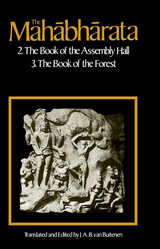 The Mahabharata, Volume 2: Book 2: The Book of Assembly; Book 3: The Book of the Forest
Edited by J. A. B. van Buitenen
University of Chicago Press, 1975 The Mahabharata, an ancient and vast Sanskrit poem, is a remarkable collection of epics, legends, romances, theology, and ethical and metaphysical doctrine. The core of this great work is the epic struggle between five heroic brothers, the Pandavas, and their one hundred contentious cousins for rule of the land. This is the second volume of van Buitenen's acclaimed translation of the definitive Poona edition of the text. Book two, The Book of the Assembly Hall, is an epic dramatization of the Vedic ritual of consecration that is central to the book. Book three, The Book of the Forest, traces the further episodes of the heroes during their years in exile. Also included are the famous story of Nala, dealing with the theme of love in separation, and the story of Rama, the subject of the other great Sanskrit epic, the Ramayana, as well as other colorful tales.
The Mahabharata, Volume 3: Book 4: The Book of the Virata; Book 5: The Book of the Effort
Edited by J. A. B. van Buitenen
University of Chicago Press, 1978 The Mahabharata, an ancient and vast Sanskrit poem, is a remarkable collection of epics, legends, romances, theology, and ethical and metaphysical doctrine. The core of this great work is the epic struggle between five heroic brothers, the Pandavas, and their one hundred contentious cousins for rule of the land. This is the third volume of van Buitenen's acclaimed translation of the definitive Poona edition of the text. Book 4, The Book of Virata, begins as a burlesque, but the mood soon darkens amid molestation, raids, and Arjuna's battle with the principal heroes of the enemy. Book 5, The Book of the Effort, relates the attempts of the Pandavas to negotiate the return of their patrimony. They are refused so much as a "pinprick of land," and both parties finally march to battle.
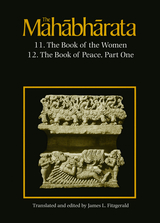 The Mahabharata, Volume 7: Book 11: The Book of the Women Book 12: The Book of Peace, Part 1
Edited by James L. Fitzgerald
University of Chicago Press, 2004 What is found in this epic may be elsewhere;
What is not in this epic is nowhere else.
—from The Mahabharata
The second longest poem in world literature, The Mahabharata is an epic tale, replete with legends, romances, theology, and metaphysical doctrine written in Sanskrit. One of the foundational elements in Hindu culture, this great work consists of nearly 75,000 stanzas in eighteen books, and this volume marks the much anticipated resumption of its first complete modern English translation. With the first three volumes, the late J. A. B. van Buitenen had taken his translation up to the threshold of the great war that is central to the epic. Now James Fitzgerald resumes this work with translations of the books that chronicle the wars aftermath: The Book of Women and part one of The Book of Peace. These books constitute volume 7 of the projected ten-volume edition. Volumes 4, 5, 6, 8, 9, and 10 of the series will be published over the next several years.
In his introductions to these books, Fitzgerald examines the rhetoric of The Mahabharatas representations of the wars aftermath. Indeed, the theme of The Book of Women is the grief of the women left by warriors slain in battle. The book details the keening of palace ladies as they see their dead husbands and sons, and it culminates in a mass cremation where the womens tears turn into soothing libations that help wash the deaths away. Fitzgerald shows that the portrayal of the womens grief is much more than a sympathetic portrait of the sufferings of war. The scenes of mourning in The Book of Women lead into a crisis of conscience that is central to The Book of Peace and, Fitzgerald argues, the entire Mahabharata. In this book, the man who has won power in the great war is torn between his own sense of guilt and remorse and the obligation to rule which ultimately he is persuaded to embrace.
The Mahabharata is a powerful work that has inspired awe and wonder for centuries. With a penetrating glimpse into the trauma of war, this volume offers two of its most timely and unforgettable chapters.
 The Mahabharata, Volume 8: Book 12, The Book of Peace, Part 2
Translated and Edited by James L. Fitzgerald
University of Chicago Press, 2026 A translation of the twelfth book of The Mahābhārata, an epic tale of history and kingship, reinforced with legends, romances, and metaphysical, theological, and ethical teachings written in Sanskrit 1700 or more years ago.
A remarkable composition of 100,000 couplets, The Mahābhārata is the second-longest poem in world literature. In this volume, James L. Fitzgerald completes his translation of the twelfth of The Mahābhārata’s eighteen books, the vast Shanti Parvan, or The Book of Peace. Covering a wide range of ancient Indian intellectual history, The Book of Peace was intended to serve as a comprehensive, brahmin-inspired basis for living a Good Life in a Good Society in a Good Polity and is one of the most important and complex books of the poem.
Fitzgerald’s previous contribution to the Chicago edition of The Mahābhārata, volume 7, opened with Book 11, The Book of the Women, which movingly portrayed the grief of the wives, mothers, and sisters of the many warriors slain in the epic’s central war narrative. The crises of grief presented in The Book of the Women give particular poignancy and depth to the shanti, or pacification, that is the theme of Book 12, The Book of Peace. Volume 7 included the first half of The Book of Peace, and volume 8 now completes it with the second half, which is focused particularly on the ways people can escape the cycle of rebirth and realize sublime beatitude by way of saving knowledge or yoga meditation or devotion to God Viṣṇu-Nārāyaṇa. Supported by an extensive introduction and notes, this publication will be greeted as a major event in Sanskrit studies.
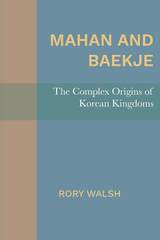 Mahan and Baekje: The Complex Origins of Korean Kingdoms
Rory Walsh
Michigan Publishing, 2020 Mahan and Baekje is a pioneering study of the Korean past from the perspective of everyday objects: ceramics made, used, and left behind by ancient Koreans themselves. Focusing on the third to fifth centuries CE in southwestern Korea, this book reexamines the social, political, and economic construction of the interconnected societies known as Mahan and the kingdom of Baekje. Pottery, which played central roles in Mahan’s and Baekje’s culinary practices, community gatherings, trade, and ritual, now sheds new light on the origins of Korean civilization. Using advanced archaeological and geochemical techniques, this book traces the production, exchange, and use of pottery from Mahan and Baekje. The patterns reveal the shared underpinnings of Mahan and Baekje political economy, showing that the Baekje kingdom developed locally and not as the result of outside forces. Long-distance trade in Mahan and Baekje suggest a cosmopolitan ethos with roots in the deep past, while smaller scale exchanges hint at the complex web of social interactions that typified early Korean societies. Mahan and Baekje provides exciting new details of life at an epochal moment in ancient Korea.
Maharajah of Bikaner: India
Hugh Purcell
Haus Publishing, 2010 The story of the Indian soldiery in the Great War needs a new telling and one important chapter of it will be about the Maharajah of Bikaner: Dashing, autocratic and a formidable public speaker, Ganga Singh commanded his own camel corps called the Ganga Risala, fought on the Western Front and in Egypt, became the first Indian general in the British Indian army and persuaded the maharajas to unite into the Chamber of Princes. As a result of this and his war record he was invited by Lloyd George to attend the Imperial War Conference in 1917 and then the Versailles Peace Conference two years later, where he persuaded the other delegates to include India in the new League of Nations, quite an achievement as it was not an independent nation. Less successfully he tried to prevent the dismemberment of Turkey.
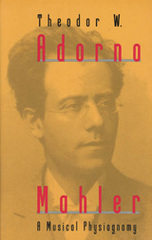 Mahler: A Musical Physiognomy
Theodor W. Adorno
University of Chicago Press, 1992 Theodor W. Adorno goes beyond conventional thematic analysis to gain a more complete understanding of Mahler's music through his character, his social and philosophical background, and his moment in musical history. Adorno examines the composer's works as a continuous and unified development that began with his childhood response to the marches and folk tunes of his native Bohemia.
Since its appearance in 1960 in German, Mahler has established itself as a classic of musical interpretation. Now available in English, the work is presented here in a translation that captures the stylistic brilliance of the original.
Theodor W. Adorno (1903-69), one of the foremost members of the Frankfurt school of critical theory, studied with Alban Berg in Vienna during the late twenties, and was later the director of the Institute of Social Research at the University of Frankfurt from 1956 until his death. His works include Aesthectic Theory, Introduction to the Sociology of Music, The Jargon of Authenticity, Prism, and Philosophy of Modern Music.
 Mahler's Symphonic World: Music for the Age of Uncertainty
Karol Berger
University of Chicago Press, 2025 A new analysis of Mahler’s symphonies, placing each within the context of his musical way of being in and experiencing the world.
Between 1888 and 1909 Gustav Mahler completed nine symphonies and the orchestral song cycle Das Lied von der Erde; his tenth symphony was left incomplete at his death in 1911. Mahler’s Symphonic World provocatively suggests that over his lifetime, the composer pursued a single vision and a single, ideal symphony that strived to capture his personal outlook on human existence. Writing at the turn of the twentieth century, when all trust in firm philosophical and spiritual foundations had evaporated, Mahler’s music reflected a deep preoccupation with human suffering and transience and a search for sources of possible consolation.
In Karol Berger’s reading, each of the symphonies follows a similar trajectory, with an opening quest leading to the final unveiling of a transcendent, consolatory vision. By juxtaposing single movements—the opening Allegros, the middle movements, the Finales—across different works, Berger traces recurring plotlines and imagery and discloses the works’ multiple interrelationships as well as their cohesiveness around a central idea. Ultimately, Mahler’s Symphonic World locates Mahler’s music within the matrix of intellectual currents that defined his epoch and offers a revelatory picture of his musical way of being in the world.
 Mahogany: The Costs of Luxury in Early America
Jennifer L. Anderson
Harvard University Press, 2012 In the mid-eighteenth century, colonial Americans became enamored with the rich colors and silky surface of mahogany. This exotic wood, imported from the West Indies and Central America, quickly displaced local furniture woods as the height of fashion. Over the next century, consumer demand for mahogany set in motion elaborate schemes to secure the trees and transform their rough-hewn logs into exquisite objects. But beneath the polished gleam of this furniture lies a darker, hidden story of human and environmental exploitation.
Mahogany traces the path of this wood through many hands, from source to sale: from the enslaved African woodcutters, including skilled “huntsmen” who located the elusive trees amidst dense rainforest, to the ship captains, merchants, and timber dealers who scrambled after the best logs, to the skilled cabinetmakers who crafted the wood, and with it the tastes and aspirations of their diverse clientele. As the trees became scarce, however, the search for new sources led to expanded slave labor, vicious competition, and intense international conflicts over this diminishing natural resource. When nineteenth-century American furniture makers turned to other materials, surviving mahogany objects were revalued as antiques evocative of the nation's past.
Jennifer Anderson offers a dynamic portrait of the many players, locales, and motivations that drove the voracious quest for mahogany to adorn American parlors and dining rooms. This complex story reveals the cultural, economic, and environmental costs of America’s growing self-confidence and prosperity, and how desire shaped not just people’s lives but the natural world.
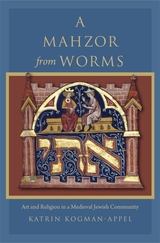 A Mahzor from Worms: Art and Religion in a Medieval Jewish Community
Katrin Kogman-Appel
Harvard University Press, 2012 The Leipzig Mahzor is one of the most lavish Hebrew illuminated manuscripts of all time. A prayer book used during Jewish holidays, it was produced in the Middle Ages for the Jewish community of Worms in the German Rhineland. Though Worms was a vibrant center of Judaism in the eleventh and twelfth centuries and drew celebrated rabbis, little is known about the city’s Jews in the later Middle Ages. In the pages of its famous book, Katrin Kogman-Appel discovers a portal into the life of this fourteenth-century community.
Medieval mahzorim were used only for special services in the synagogue and “belonged” to the whole congregation, so their visual imagery reflected the local cultural associations and beliefs. The Leipzig Mahzor pays homage to one of Worms’s most illustrious scholars, Eleazar ben Judah. Its imagery reveals how his Ashkenazi Pietist worldview and involvement in mysticism shaped the community’s religious practice. Kogman-Appel draws attention to the Mahzor’s innovations, including its strategy for avoiding visual representation of God and its depiction of customs such as the washing of dishes before Passover, something less common in other mahzorim. In addition to decoding its iconography, Kogman-Appel approaches the manuscript as a ritual object that preserved a sense of identity and cohesion within a community facing a wide range of threats to its stability and security.
This book was published with the support of the Israel Science Foundation.
Mai Ya's Long Journey
Sheila Cohen
Wisconsin Historical Society Press, 2005 The story of Mai Ya Xiong and her family and their journey from the Ban Vinai refugee camp in Thailand to a new life in Madison, Wisconsin, is extraordinary. Yet it is typical of the stories of the 200,000 Hmong people who now live in the United States and who struggle to adjust to American society while maintaining their own culture as a free people. Mai Ya's Long Journey follows Mai Ya Xiong, a young Hmong woman, from her childhood in Thailand's Ban Vinai Refugee Camp to her current home in Wisconsin. Mai Ya's parents fled Laos during the Vietnam War and were refugees in Thailand for several years before reaching the United States. But the story does not end there. Students will read the challenges Mai Ya faces in balancing her Hmong heritage and her adopted American culture as she grows into adulthood.
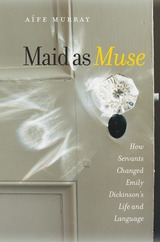 Maid as Muse: How Servants Changed Emily Dickinson’s Life and Language
Aífe Murray
University of New Hampshire Press, 2010 In Maid as Muse, Aífe Murray explodes the myth of the isolated genius and presents an intimate, densely realized story of joined lives between Emily Dickinson and her domestic servants. Part scholarly study, part detective story, part personal journey, Murray's book uncovers a world previously unknown: an influential world of Irish immigrant servants and an ethnically rich one of Yankee, English-immigrant, Native American, and African American maids and laborers, seamstresses and stablemen. Murray reveals how Margaret Maher and the other servants influenced the cultural outlook, fashion, artistic subject, and even poetic style of Emily Dickinson. Irish immigrant Maher becomes the lens to a larger story about artistic reciprocities and culture-making that has meaning way beyond Dickinson. This below-stairs, bottom-up portrait of the artist and her family not only injects themes of class and ethnic difference into the story but also imparts subtle details and intimacies that make the study of Emily Dickinson urgent once again. In the kitchen pantry where she spent a good portion of each day, the outside world came to Dickinson. The "invisible" kitchen was headquarters for people mostly lost from the public record—and it was her interactions with them that changed and helped define who Emily Dickinson was as a person and a poet.
Maid for Television: Race, Class, Gender, and a Representational Economy
L. S. Kim
Rutgers University Press, 2023 Honorable Mention -- Association for Asian American Studies Book Award in the Media, Performance, and Visual Studies category
Maid for Television examines race, class, and gender relations as embodied in a long history of television servants from 1950 to the turn of the millennium. Although they reside at the visual peripheries, these figures are integral to the idealized American family. Author L. S. Kim redirects viewers' gaze towards the usually overlooked interface between characters, which is drawn through race, class, and gender positioning. Maid for Television tells the stories of servants and the families they work for, in so doing it investigates how Americans have dealt with difference through television as a medium and a mediator.The book philosophically redirects the gaze of television and its projection of racial discourse.
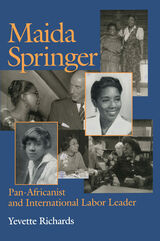 Maida Springer: Pan Africanist And International Labor Leader
Yevette Richards
University of Pittsburgh Press, 2004 Maida Springer was an active participant in shaping a history that involved powerful movements for social, political and economic equality and justice for workers women, and African Americans. Maida Springer is the first full-length biography to document and analyze the central role played by Springer in international affairs, particularly in the formation of AFL-CIO’s African policy during the Cold War and African independence movements.
Richards explores the ways in which pan-Africanism, racism, sexism and anti-Communism affected Springer’s political development, her labor activism, and her relationship with labor leaders in the AFL-CIO, the International Confederation of Free Trade Unions (ICFTU), and in African unions. Springer’s life experiences and work reveal the complex nature of black struggles for equality and justice. A strong supporter of both the AFL-CIO and the ICFTU, Springer nonetheless recognized that both organizations were fraught with racism, sexism, and ethnocentrism. She also understood that charges of Communism were often used as a way to thwart African American demands for social justice. As an African-American, she found herself in the unenviable position of promoting to Africans the ideals of American democracy from which she was excluded from fully enjoying.
Richards’s biography of Maida Springer uniquely connects pan-Africanism, national and international labor relations, the Cold War, and African American, labor, women’s, and civil rights histories. In addition to documenting Springer’s role in international labor relations, the biography provides a larger view of a whole range of political leaders and social movements. Maida Springer is a stirring biography that spans the fields of women studies, African American studies, and labor history.
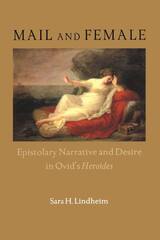 Mail and Female: Epistolary Narrative and Desire in Ovid's Heroides
Sara H. Lindheim
University of Wisconsin Press, 2003 In the Heroides, the Roman poet Ovid wittily plucks fifteen abandoned heroines from ancient myth and literature and creates the fiction that each woman writes a letter to the hero who left her behind. But in giving voice to these heroines, is Ovid writing like a woman, or writing "Woman" like a man?
Using feminist and psychoanalytic approaches to examine the "female voice" in the Heroides, Sara H. Lindheim closely reads these fictive letters in which the women seemingly tell their own stories. She points out that in Ovid’s verse epistles all the women represent themselves in a strikingly similar and disjointed fashion. Lindheim turns to Lacanian theory of desire to explain these curious and hauntingly repetitive representations of the heroines in the "female voice." Lindheim’s approach illuminates what these poems reveal about both masculine and feminine constructions of the feminine
 Maimonides: A Collection of Critical Essays
Joseph A. Buijs
University of Notre Dame Press, 1988 “Buijs is to be congratulated for gathering into one volume essays of such a scope and quality, as well as for confronting the challenging issues of interpretation raised so acutely by Leo Strauss. This combination of factors makes this work immensely useful to students of philosophy and theology who may have been misled by their earlier studies into thinking that one can understand the medieval intellectual explosion without attending to its sources in the Arabic culture--of which Maimonides is a particularly lucid witness.”—David B. Burrell, C.S.C.
“This is a splendid project filling a long-standing need and carried to fulfillment in handsome fashion. Maimonides--Moses ben Maimon--is a thinker one does not read long before becoming aware of a probing and informed intelligence. . . . His voice belongs prominently in the dialogue of the great spirits of our civilization. This volume of critical essays should help to put him there.” —Harold J. Johnson, University of Western Ontario
“Professor Buijis’ Maimonides is a very fine anthology of contemporary Maimonidean studies. . . . [the essays] cover a rich variety of topics in Maimonides’ philosophy and represent widely different approaches among Maimonidean scholars.” —Aviezer Ravitzky, The Hebrew University of Jerusalem
 Maimonides after 800 Years: Essays on Maimonides and His Influence
Jay M. Harris
Harvard University Press, 2007 Moses Maimonides was the most significant Jewish thinker, jurist, and doctor of the Middle Ages. Author of both a monumental code of Jewish law and the most influential and controversial work of Jewish philosophy, Maimonides looms larger than any other figure in the Jewish Middle Ages.
The essays in this volume were written to mark the 800th anniversary of Maimonides’s death in 1204. Written by the leading scholars in the field, they cover all aspects of Maimonides’s work and infuence. From his work on Jewish law to his unique understanding of God; from his view of the soul to his understanding of other religions; from his influence on Jewish scholars in the eastern Mediterranean to his impact on the emergence of modern Judaism—the essays in this volume cover all this and more. It is an indispensable collection for all those interested in the history of Judaism over the last 800 years.
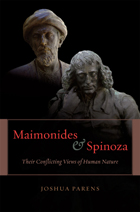 Maimonides and Spinoza: Their Conflicting Views of Human Nature
Joshua Parens
University of Chicago Press, 2012 Until the last century, it was generally agreed that Maimonides was a great defender of Judaism, and Spinoza—as an Enlightenment advocate for secularization—among its key opponents. However, a new scholarly consensus has recently emerged that the teachings of the two philosophers were in fact much closer than was previously thought. In his perceptive new book, Joshua Parens sets out to challenge the now predominant view of Maimonides as a protomodern forerunner to Spinoza—and to show that a chief reason to read Maimonides is in fact to gain distance from our progressively secularized worldview. Turning the focus from Spinoza’s oft-analyzed Theologico-Political Treatise, this book has at its heart a nuanced analysis of his theory of human nature in the Ethics. Viewing this work in contrast to Maimonides’s Guide of the Perplexed, it makes clear that Spinoza can no longer be thought of as the founder of modern Jewish identity, nor should Maimonides be thought of as having paved the way for a modern secular worldview. Maimonides and Spinoza dramatically revises our understanding of both philosophers.
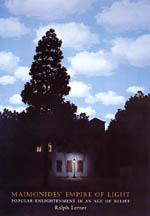 Maimonides' Empire of Light: Popular Enlightenment in an Age of Belief
Ralph Lerner
University of Chicago Press, 2000 Much of the writing of and about the twelfth-century rabbi, philosopher, and theologian Moses Maimonides is addressed to an elite audience of philosophers and intellectuals. Here, Ralph Lerner's exploration of Maimonides' popular writings reveals that the education of the common man was one of the great teacher's chief concerns.
Lerner describes the brilliant and sometimes wily ways in which Maimonides sought to break through the despair and superstition that gripped the Jewish people's minds, without sacrificing the dignity and core of his message. These writings—presented here in uncommonly accurate, mostly new translations—also reveal that Maimonides was willing to risk the scorn of his contemporaries to enlighten both his own and future generations. By addressing the writings of Maimonides' disciples, including Shem Tov ben Joseph Ibn Falaquera in the mid-thirteenth century and Joseph Albo in the fifteenth century, Lerner shows how this technique was passed on.
In striking contrast to the Enlightenment of the eighteenth century, Maimonides' enlightenment is premised on the inequality of understandings and other differences between the elite and the common people. Instead of scorning the past, Lerner shows, Maimonides' enlightenment invests it with a new and ennobling dignity. A valuable reference for students of political philosophy and Jewish studies, Lerner's elegantly written book also brings to life the richness and relevance of medieval Jewish thought for all those interested in the Jewish tradition.
 Maimonides' Ethics: The Encounter of Philosophic and Religious Morality
Raymond L. Weiss
University of Chicago Press, 1991 In this book Raymond L. Weiss examines how a seminal Jewish thinker negotiates the philosophical conflict between Athens and Jerusalem in the crucial area of ethics. Maimonides, a master of both the classical and the biblical-rabbinic traditions, reconciled their differing views of morality primarily in the context of Jewish jurisprudence. Taking into consideration the entire corpus of Maimonides' writings, Weiss focuses on the ethical sections of the Commentary on the Mishnah and the Mishneh Torah, but also discusses the Guide of the Perplexed, the letters of Maimonides, and his medical works.
The gulf between classical philosophy and the Torah made the task of Maimonides extraordinarily difficult. Weiss shows that Maimonides subtly preserves the tension between those traditions while producing a practical accommodation between them. To explain how Maimonides was able to accomplish this twofold goal, Weiss takes seriously the multilevel character of Maimonides' works. Weiss interprets Maimonides as a heterodox thinker who, with utter integrity, faces the Law's encounter with philosophy and gives both the Torah and philosophy their due.
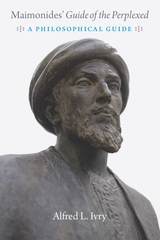 Maimonides' "Guide of the Perplexed": A Philosophical Guide
Alfred L. Ivry
University of Chicago Press, 2016 A classic of medieval Jewish philosophy, Maimonides’s Guide of the Perplexed is as influential as it is difficult and demanding. Not only does the work contain contrary—even contradictory—statements, but Maimonides deliberately wrote in a guarded and dissembling manner in order to convey different meanings to different readers, with the knowledge that many would resist his bold reformulations of God and his relation to mankind. As a result, for all the acclaim the Guide has received, comprehension of it has been unattainable to all but a few in every generation.
Drawing on a lifetime of study, Alfred L. Ivry has written the definitive guide to the Guide—one that makes it comprehensible and exciting to even those relatively unacquainted with Maimonides’ thought, while also offering an original and provocative interpretation that will command the interest of scholars. Ivry offers a chapter-by-chapter exposition of the widely accepted Shlomo Pines translation of the text along with a clear paraphrase that clarifies the key terms and concepts. Corresponding analyses take readers more deeply into the text, exploring the philosophical issues it raises, many dealing with metaphysics in both its ontological and epistemic aspects.
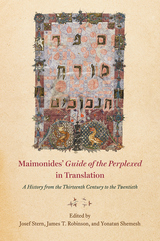 Maimonides' "Guide of the Perplexed" in Translation: A History from the Thirteenth Century to the Twentieth
Edited by Josef Stern, James T. Robinson, and Yonatan Shemesh
University of Chicago Press, 2019 Moses Maimonides’s Guide of the Perplexed is the greatest philosophical text in the history of Jewish thought and a major work of the Middle Ages. For almost all of its history, however, the Guide has been read and commented upon in translation—in Hebrew, Latin, Spanish, French, English, and other modern languages—rather than in its original Judeo-Arabic. This volume is the first to tell the story of the translations and translators of Maimonides’ Guide and its impact in translation on philosophy from the Middle Ages to the present day.
A collection of essays by scholars from a range of disciplines, the book unfolds in two parts. The first traces the history of the translations of the Guide, from medieval to modern renditions. The second surveys its influence in translation on Latin scholastic, early modern, and contemporary Anglo-American philosophy, as well as its impact in translation on current scholarship. Interdisciplinary in approach, this book will be essential reading for philosophers, historians, and religious studies scholars alike.
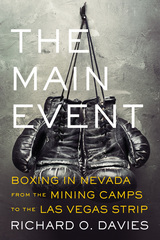 The Main Event: Boxing in Nevada from the Mining Camps to the Las Vegas Strip
Richard O. Davies
University of Nevada Press, 2014 Richard O. Davies won Foreword Reviews' INDIEFAB Book of the Year Bronze Medal in Sports for The Main Event: Boxing in Nevada from the Mining Camps to the Las Vegas Strip. Davies' book was chosen as one of the best indie books of 2014.
As the twentieth century dawned, bare-knuckle prizefighting was transforming into the popular sport of boxing, yet simultaneously it was banned as immoral in many locales. Nevada was the first state to legalize it, in 1897, solely to stage the Corbett-Fitzsimmons world heavyweight championship in Carson City. Davies shows that the history of boxing in Nevada is integral to the growth of the sport in America. Promoters such as Tex Rickard brought in fighters like Jack Dempsey to the mining towns of Goldfield and Tonopah and presented the Johnson-Jeffries “Fight of the Century” in Reno in 1910. Prizefights sold tickets, hotel rooms, drinks, meals, and bets on the outcomes. It was boxing\--before gambling, prostitution, and easy divorce\--that first got Nevada called “America’s Disgrace” and the “Sin State.” The Main Event explores how boxing’s growth in Nevada relates to the state’s role as a social and cultural outlier. Starting in the Rat Pack era, organized gambling’s moguls built arenas outside the Vegas casinos to stage championships\--more than two hundred from 1960 to the present. Tourists and players came to see and bet on historic bouts featuring Sonny Liston, Muhammad Ali, George Foreman, Sugar Ray Leonard, Mike Tyson, and other legends of the ring.
From the celebrated referee Mills Lane to the challenge posed by mixed martial arts in contemporary Las Vegas, the story of boxing in Nevada is a prism for viewing the sport. Davies utilizes primary and secondary sources to analyze how boxing in the Silver State intersects with its tourist economy and libertarian values, paying special attention to issues of race, class, and gender. Written in an engaging style that shifts easily between narrative and analysis, The Main Event will be essential reading for sports fans and historians everywhere.
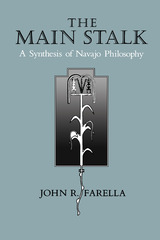 The Main Stalk: A Synthesis of Navajo Philosophy
John R. Farella
University of Arizona Press, 1984 "Although they are among the most studied people on earth, the Navajo possess a complex philosophy. . . . A valuable source for those deeply interested in the structure of the Navajo universe, its mythology, and its central concept of long life and happiness." —Masterkey
"This is a stimulating book. Essentially, it criticizes previous discussions of Navajo religion and philosophy for greatly underestimating their complexity and sophistication. . . . What the author discovers in Navajo thought is that the key concepts are interrelated in a grand, moral, ethical, philosophic, and cosmic unity." —American Anthropologist
"Discredits dualists, both non-Indian and Indian, who see simplistic oppositions of Good and Evil in Navajo culture and philosophy. The concept of walking in beauty, as related to the proper growth of the corn plant, unifies the book, and Farella does some impressive cross-cultural linguistic analysis to derive practical and ceremonial applications of these central Navajo metaphors. . . . This is one of the better books on Indian religion." —Choice
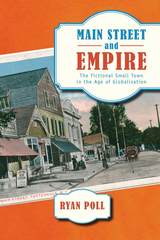 Main Street and Empire: The Fictional Small Town in the Age of Globalization
Poll, Ryan
Rutgers University Press, 2012 The small town has become a national icon that circulates widely in literature, culture, and politics as an authentic American space and community. Yet there are surprisingly few critical studies that analyze the small town’s centrality to the United States’ identity and imagination. In Main Street and Empire, Ryan Poll addresses this need, arguing that the small town, as evoked by the image of “Main Street,” is not a relic of the past but rather a metaphorical screen upon which America’s “everyday” stories and subjects are projected on both a national and global scale. Bringing together a broad selection of texts—from Thornton Wilder’s Our Town, Grace Metalious’s Peyton Place, and Peter Weir’s The Truman Show to the speeches of William McKinley, Ronald Reagan, Sarah Palin, and Barack Obama—Poll examines how the small town is used to imagine and reproduce the nation throughout the twentieth- and into the twenty-first century. He contends that the dominant small town, despite its innocent, nostalgic appearance, is central to the development of the U.S. empire and global capitalism.
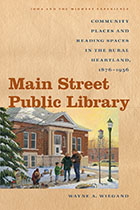 Main Street Public Library: Community Places and Reading Spaces in the Rural Heartland, 1876-956
Wayne A. Wiegand
University of Iowa Press, 2011 The United States has more public libraries than it has McDonald’s restaurants. By any measure, the American public library is a heavily used and ubiquitous institution. Popular thinking identifies the public library as a neutral agency that protects democratic ideals by guarding against censorship as it makes information available to people from all walks of life. Among librarians this idea is known as the “library faith.” But is the American public library as democratic as it appears to be? In Main Street Public Library, eminent library historian Wayne Wiegand studies four emblematic small-town libraries in the Midwest from the late nineteenth century through the federal Library Service Act of 1956, and shows that these institutions served a much different purpose than is so often perceived. Rather than acting as neutral institutions that are vital to democracy, the libraries of Sauk Centre, Minnesota; Osage, Iowa; Rhinelander, Wisconsin; and Lexington, Michigan, were actually mediating community literary values and providing a public space for the construction of social harmony. These libraries, and the librarians who ran them, were often just as susceptible to the political and social pressures of their time as any other public institution. By analyzing the collections of all four libraries and revealing what was being read and why certain acquisitions were passed over, Wiegand challenges both traditional perceptions and professional rhetoric about the role of libraries in our small-town communities. While the American public library has become essential to its local community, it is for reasons significantly different than those articulated by the “library faith.”
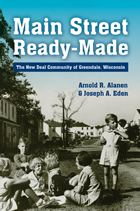 Main Street Ready-Made: The New Deal Community of Greendale, Wisconsin
Arnold R. Alanen
Wisconsin Historical Society Press, 2012
The dream of the suburb is an old one in America. For more than a century, city dwellers have sought to escape the crowding and pollution of industrial centers for the quiet streets and green spaces on their fringes. In the 1930s, that dream inspired the largest migration of Americans in the twentieth century and led to the creation of Greendale, Wisconsin, one of three planned communities initially begun to resettle the rural poor hit hard by the Great Depression. This idea, though, quickly developed into a plan to revitalize cities and stabilize farming communities around the nation. The result was three “greenbelt towns” built from scratch, expressly for working-class families and within easy commuting distance of urban employment. Greendale, completed in 1938, was consciously designed as a midwestern town in both its physical character and social organization, where ordinary citizens could live in a safe, attractive, economical community that was in harmony with the surrounding farmland.
“Main Street Ready-Made” examines Greendale as an outgrowth of public policy, an experiment in social engineering, and an organic community that eventually evolved to embrace a huge shopping mall, condominiums, and expensive homes while still preserving much of the architecture and ambiance of the original village. A snapshot of 1930s idealism and ingenuity, “Main Street Ready-Made” makes a significant contribution to the history of cities, suburbs, and social planning in mid-century America.
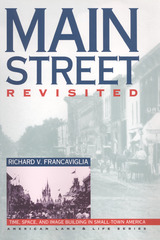 Main Street Revisited: Time, Space, and Image Building in Small-Town America
Richard V. Francaviglia
University of Iowa Press, 1996 As an archetype for an entire class of places, Main Street has become one of America's most popular and idealized images. In Main Street Revisited, the first book to place the design of small downtowns in spatial and chronological context, Richard Francaviglia finds the sources of romanticized images of this archetype, including Walt Disney's Main Street USA, in towns as diverse as Marceline, Missouri, and Fort Collins, Colorado. Francaviglia interprets Main Street both as a real place and as an expression of collective assumptions, designs, and myths; his Main Streets are treasure troves of historic patterns. Using many historical and contemporary photographs and maps for his extensive fieldwork and research, he reveals a rich regional pattern of small-town development that serves as the basis for American community design. He underscores the significance of time in the development of Main Street's distinctive personality, focuses on the importance of space in the creation of place, and concentrates on popular images that have enshrined Main Street in the collective American consciousness.
Maine’s Lithographic Landscapes: Town and City Views, 1830-1870
Earle G. Shettleworth Jr.
Brandeis University Press, 2020 During the nineteenth century, Americans celebrated their towns and cities through printed landscapes. In Maine, lithographs were commissioned from such leading artists as Fitz Henry Lane and talented, lesser known local artists, such as Esteria Butler. This book reproduces many of these works and provides insights into how these growing centers of commerce and industry viewed themselves and wished to be viewed by others. It’s the perfect book for those who love Maine, both full-time residents and those who make it a beloved summer destination. Published in association with the Bowdoin College Museum of Art on the occasion of the bicentennial of Maine statehood.
 Mainsprings of Indian and Pakistani Foreign Policies
S.M. Burke
University of Minnesota Press, 1974 Mainsprings of Indian and Pakistani Foreign Policies was first published in 1974. Minnesota Archive Editions uses digital technology to make long-unavailable books once again accessible, and are published unaltered from the original University of Minnesota Press editions. This study by a South Asian specialist illuminates a vast and complex field. For the first time Indian and Pakistani foreign policies have been paralleled within the covers of a single volume. Also for the first time the author has not chosen as his starting point the year 1947, when these ancient lands reemerged as sovereign states, but has adopted it as the middle point, devoting equal attention to the pre-independence period. Part I provides a cogent answer to the query, often raised but seldom answered to the satisfaction of outsiders, why the Hindus and the Muslims, nourished by the same soil for hundreds of years, were unable to form a single united and strong nation after releasing themselves from foreign domination. And it highlights the surprising extent to which the foreign policies of India and Pakistan have been motivated by impulses inherited from their long past. Part II evaluates the actual performance of independent India and Pakistan on the world stage; reviews the rivalry between the United States, the Soviet Union, and China to gain influence in South Asia; and probes the vital question why India and Pakistan have belied the original expectation that they would rapidly become prosperous and powerful members of the international community. Domestic pressures bearing on the foreign policies of both countries, including circumstances culminating in the emergence of Bangladesh, are explained.
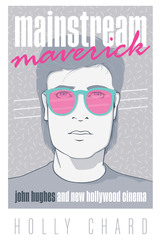 Mainstream Maverick: John Hughes and New Hollywood Cinema
By Holly Chard
University of Texas Press, 2020 Winner, Best First Monograph, British Association of Film, Television and Screen Studies The first scholarly book on John Hughes examines Hollywood's complex relationship with genre, the role of the auteur in commercial cinema, and the legacy of favorites such as Sixteen Candles and Ferris Bueller's Day Off. In the 1980s and 1990s, John Hughes was one of Hollywood's most reliable hitmakers, churning out beloved teen comedies and family films such as The Breakfast Club and Home Alone, respectively. But was he an artist? Hughes, an adamantly commercial filmmaker who was dismissed by critics, might have laughed at the question. Since his death in 2009, though, he has been memorialized on Oscar night as a key voice of his time. Now the critics lionize him as a stylistic original. Holly Chard traces Hughes's evolution from entertainer to auteur. Studios recognized Hughes's distinctiveness and responded by nurturing his brand. He is therefore a case study in Hollywood's production not only of movies but also of genre and of authorship itself. The films of John Hughes, Chard shows, also owed their success to the marketers who sold them and the audiences who watched. Careful readings of Hughes's cinema reveal both the sources of his iconic status and the imprint on his films of the social, political, economic, and media contexts in which he operated. The first serious treatment of Hughes, Mainstream Maverick elucidates the priorities of the American movie industry in the New Hollywood era and explores how artists not only create but are themselves created.
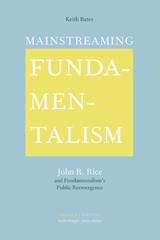 Mainstreaming Fundamentalism: John R. Rice and Fundamentalism's Public Reemergence
Keith Bates
University of Tennessee Press, 2021 In Mainstreaming Fundamentalism: John R. Rice and Fundamentalism’s Public Reemergence, Keith Bates embarks on a thematic and chronological exploration of twentieth-century Baptist fundamentalism in postwar America, sharing the story of a man whose career intersected with many other leading fundamentalists of the twentieth century, such as J. Frank Norris, Bob Jones Sr., Bob Jones Jr., and Jerry Falwell.
Unique among histories of American fundamentalism, this book explores the theme of Southern fundamentalism’s reemergence through a biographical lens. John R. Rice’s mission to inspire a broad cultural activism within fundamentalism—particularly by opposing those who fostered an isolationist climate—would give direction and impetus to the movement for the rest of the twentieth century. To support this claim, Bates presents chapters on Rice’s background and education, personal and ecclesiastical separatism, and fundamentalism and political action, tracing his rise to leadership during a critical phase of fundamentalism’s development until his death in 1980.
Bates draws heavily upon primary source texts that include writings from Rice’s fundamentalist contemporaries, his own The Sword of the Lord articles, and his private papers—particularly correspondence with many nationally known preachers, local pastors, and laypeople over more than fifty years of Rice’s ministry. The incorporation of these writings, combined with Bates’s own conversations with Rice’s family, facilitate a deeply detailed, engaging examination that fills a significant gap in fundamentalist history studies.
Mainstreaming Fundamentalism: John R. Rice and Fundamentalism’s Public Reemergence provides a nuanced and insightful study that will serve as a helpful resource to scholars and students of postwar American fundamentalism, Southern fundamentalism, and Rice’s contemporaries.
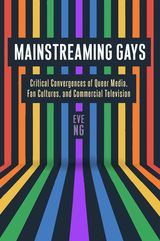 Mainstreaming Gays: Critical Convergences of Queer Media, Fan Cultures, and Commercial Television
Eve Ng
Rutgers University Press, 2023 Mainstreaming Gays discusses a key transitional period linking the eras of legacy and streaming, analyzing how queer production and interaction that had earlier occurred outside the mainstream was transformed by multiple converging trends: the emergence of digital media, the rising influence of fan cultures, and increasing interest in LGBTQ content within commercial media. The U.S. networks Bravo and Logo broke new ground in the early 2000s and 2010s with their channel programming, as well as bringing in a new cohort of LGBTQ digital content creators, providing unprecedented opportunities for independent queer producers, and hosting distinctive spaces for queer interaction online centered on pop culture and politics rather than dating. These developments constituted the ground from which recent developments for LGBTQ content and queer sociality online have emerged. Mainstreaming Gays is critical reading for those interested in media production, fandom, subcultures, and LGBTQ digital media.
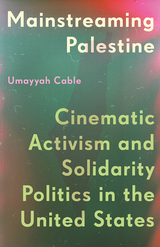 Mainstreaming Palestine: Cinematic Activism and Solidarity Politics in the United States
Umayyah Cable
University of Minnesota Press, 2025 A history of cinema’s role in popularizing the politics of Palestinian liberation For decades, Arab American activists and allies have used film, video, and multimedia to mobilize support for the Palestinian cause in the United States. In this detailed history of cinema’s role within the broader solidarity movement, Umayyah Cable analyzes the various strands of cinematic activism that have helped move Palestinian liberation politics from the periphery and into the mainstream. Cable charts the shifting discourse around Palestine as it has been shaped by grassroots film production and alternative media distribution networks as well as more conventional outlets. Ranging from the circulation of educational filmstrips by the Association of Arab American University Graduates in the 1970s to the treatment of Palestinian solidarity at contemporary Hollywood awards ceremonies and film festivals, Mainstreaming Palestine tells the story of how cinema has promoted Palestinian liberation and solidarity politics. While highlighting various public controversies and struggles against censorship, Cable also acknowledges the drawbacks of the Palestinian cause being subsumed by the mainstream, discussing how activism risks becoming fashionable, undermining the radical potential of the very tools that helped bring it there. Combining archival research, ethnographic observation and interviews, text analysis, and visual analysis of film, video, and multimedia, Mainstreaming Palestine encourages readers to critically assess the relationship between the politics of liberation and the all-consuming engine of contemporary capitalism. By underscoring the impact of visual media on the evolution of the Palestinian solidarity discourse, this book offers both a treatise on the practical power of cinema and a necessary historicization of an urgent issue in American politics. Retail e-book files for this title are screen-reader friendly with images accompanied by short alt text and/or extended descriptions.
Maintaining Arctic Cooperation with Russia: Planning for Regional Change in the Far North
Stephanie Pezard
RAND Corporation, 2017 This report examines potential transformations that could alter Russia’s current cooperative stance in the Arctic. It analyzes current security challenges related to climate and geography, economy, territorial claims, and military power, suggests some ways in which these could undermine Arctic cooperation, and offers recommendations for the U.S. government to manage the risks to cooperation.
Maintaining Effective Engineering Leadership: A new dependence on effective process
Raymond Morrison
The Institution of Engineering and Technology, 2013 Maintaining Effective Engineering Leadership explores process as a means of maintaining leadership development. The author argues that engineering leadership is the result of the development of four fundamental concepts: personal managerial skills, self-leadership skills, operational leadership skills, and organizational leadership skills. Each is explored in turn, and examples are taken from the space shuttle Columbia disaster to show the importance of these processes and skills, and what can happen when they are ignored. The book introduces the Capability Maturity Model which provides organizations with appropriate processes and knowledge guidelines to ensure effective leadership to avoid such disasters. Topics covered include:
 The Maintenance Crew for the Human Machinery
Ligteringen
Amsterdam University Press, 2013 The book, written as a doctoral thesis, examines the development of the personnel function in labour organisations. Starting from a history of personnel management in the Netherlands during the second half of the 20th century, it analyses the structural transformation in the societal-economic environment from which originate far-reaching changes in employee relations.
The transformation from the post-war model of guided capitalism towards its neo-liberal variety has serious consequences for intra-organisational power relations which result in a one-sided articulation of interests. This erodes the moral fabric of the labour organisation as a social institution. In this context special attention is paid to the wide-spread erosion of corporate ethics in the 21st century.
The intensification of the labour process - a consistent phenomenon in industrial capitalism has got a new impulse, due to the lack of countervailing power within an eroding system of labour relations as well as to superior production techniques and technologies.
These tendencies have a deteriorating effect on the substance of the personnel discipline, ending up in a loss of function.
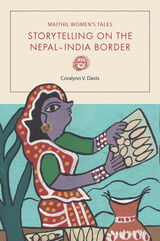 Maithil Women's Tales: Storytelling on the Nepal-India Border
Coralynn V. Davis
University of Illinois Press, 2014 Constrained by traditions restricting their movements and speech, the Maithil women of Nepal and India have long explored individual and collective life experiences by sharing stories with one another. Sometimes fantastical, sometimes including a kind of magical realism, these tales allow women to build community through a deeply personal and always evolving storytelling form.
In Maithil Women’s Tales, Coralynn V. Davis examines how these storytellers weave together their own life experiences--the hardships and the pleasures--with age-old themes. In so doing, Davis demonstrates, they harness folk traditions to grapple personally as well as collectively with social values, behavioral mores, relationships, and cosmological questions.
Each chapter includes stories and excerpts that reveal Maithil women’s gift for rich language, layered plots, and stunning allegory. In addition, Davis provides ethnographic and personal information that reveal the complexity of women’s own lives, and includes works painted by Maithil storytellers to illustrate their tales. The result is a fascinating study of being and becoming that will resonate for readers in women’s and Hindu studies, folklore, and anthropology.
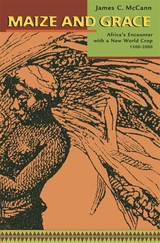 Maize and Grace: Africa’s Encounter with a New World Crop, 1500–2000
James C. McCann
Harvard University Press, 2007 Sometime around 1500 AD, an African farmer planted a maize seed imported from the New World. That act set in motion the remarkable saga of one of the world’s most influential crops—one that would transform the future of Africa and of the Atlantic world. Africa’s experience with maize is distinctive but also instructive from a global perspective: experts predict that by 2020 maize will become the world’s most cultivated crop.
James C. McCann moves easily from the village level to the continental scale, from the medieval to the modern, as he explains the science of maize production and explores how the crop has imprinted itself on Africa’s agrarian and urban landscapes. Today, maize accounts for more than half the calories people consume in many African countries. During the twentieth century, a tidal wave of maize engulfed the continent, and supplanted Africa’s own historical grain crops—sorghum, millet, and rice. In the metamorphosis of maize from an exotic visitor into a quintessentially African crop, in its transformation from vegetable to grain, and from curiosity to staple, lies a revealing story of cultural adaptation. As it unfolds, we see how this sixteenth-century stranger has become indispensable to Africa’s fields, storehouses, and diets, and has embedded itself in Africa’s political, economic, and social relations.
The recent spread of maize has been alarmingly fast, with implications largely overlooked by the media and policymakers. McCann’s compelling history offers insight into the profound influence of a single crop on African culture, health, technological innovation, and the future of the world’s food supply.
Major
Robert Taylor
Haus Publishing, 2006 British Prime Minister who worked with Clinton to bring peace to Northern Ireland
 The Major Declamations, Volume I
Quintilian
Harvard University Press, 2021 Mock trial—Roman style.
The Major Declamations stand out for their unique contribution to our understanding of the final stage in Greco-Roman rhetorical training. These exercises, in which students learned how to compose and deliver speeches on behalf of either the prosecution or the defense at imaginary trials, demonstrate how standard themes, recurring situations and arguments, and technical rules were to be handled by the aspiring orator. And what is more, they lay bare the mistakes that students often made in this process.
Declamation was practiced in the ancient world from as early as the fifth century BC, but most of its vast tradition has disappeared. The surviving material is mainly in Greek, from the second century AD onward. In Latin the nineteen declamations in the present anthology are by far the most important evidence. In antiquity they were attributed to Quintilian, but they are now thought to be the work of several authors and to date from around AD 100 to the mid- or late third century.
A wide variety of fascinating ethical, social, and legal details animates the fictional world conjured up by these oratorical exercises, and although the themes of declamation can be unrealistic and even absurd (often reminiscent of ancient novel and tragedy), they seem to provide a safe space in which a student could confront a range of complex issues, so as to attain both the technical knowledge necessary to speak persuasively and the soft skills needed to manage the challenges of adult life under the Roman empire.
 The Major Declamations, Volume II
Quintilian
Harvard University Press, 2021 Mock trial—Roman style.
The Major Declamations stand out for their unique contribution to our understanding of the final stage in Greco-Roman rhetorical training. These exercises, in which students learned how to compose and deliver speeches on behalf of either the prosecution or the defense at imaginary trials, demonstrate how standard themes, recurring situations and arguments, and technical rules were to be handled by the aspiring orator. And what is more, they lay bare the mistakes that students often made in this process.
Declamation was practiced in the ancient world from as early as the fifth century BC, but most of its vast tradition has disappeared. The surviving material is mainly in Greek, from the second century AD onward. In Latin the nineteen declamations in the present anthology are by far the most important evidence. In antiquity they were attributed to Quintilian, but they are now thought to be the work of several authors and to date from around AD 100 to the mid- or late third century.
A wide variety of fascinating ethical, social, and legal details animates the fictional world conjured up by these oratorical exercises, and although the themes of declamation can be unrealistic and even absurd (often reminiscent of ancient novel and tragedy), they seem to provide a safe space in which a student could confront a range of complex issues, so as to attain both the technical knowledge necessary to speak persuasively and the soft skills needed to manage the challenges of adult life under the Roman empire.
 The Major Declamations, Volume III
Quintilian
Harvard University Press, 2021 Mock trial—Roman style.
The Major Declamations stand out for their unique contribution to our understanding of the final stage in Greco-Roman rhetorical training. These exercises, in which students learned how to compose and deliver speeches on behalf of either the prosecution or the defense at imaginary trials, demonstrate how standard themes, recurring situations and arguments, and technical rules were to be handled by the aspiring orator. And what is more, they lay bare the mistakes that students often made in this process.
Declamation was practiced in the ancient world from as early as the fifth century BC, but most of its vast tradition has disappeared. The surviving material is mainly in Greek, from the second century AD onward. In Latin the nineteen declamations in the present anthology are by far the most important evidence. In antiquity they were attributed to Quintilian, but they are now thought to be the work of several authors and to date from around AD 100 to the mid- or late third century.
A wide variety of fascinating ethical, social, and legal details animates the fictional world conjured up by these oratorical exercises, and although the themes of declamation can be unrealistic and even absurd (often reminiscent of ancient novel and tragedy), they seem to provide a safe space in which a student could confront a range of complex issues, so as to attain both the technical knowledge necessary to speak persuasively and the soft skills needed to manage the challenges of adult life under the Roman empire.
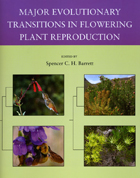 Major Evolutionary Transitions in Flowering Plant Reproduction
Edited Spencer C. H. Barrett
University of Chicago Press, 2008 The first volume to address the study of evolutionary transitions in plants, Major Evolutionary Transitions in Flowering Plant Reproduction brings together compelling work from the three areas of significant innovation in plant biology: evolution and adaptation in flowers and pollination, mating patterns and gender strategies, and asexual reproduction and polyploidy. Spencer C. H. Barrett assembles here a distinguished group of authors who address evolutionary transitions using comparative and phylogenetic approaches, the tools of genomics, population genetics, and theoretical modeling, and through studies in development and field experiments in ecology. With special focus on evolutionary transitions and shifts in reproductive characters—key elements of biological diversification and research in evolutionary biology—Major Evolutionary Transitions in Flowering Plant Reproduction is the most up-to-date treatment of a fast-moving area of evolutionary biology and ecology.
 Major Infrastructure Planning and Delivery: Exploring Nationally Significant Infrastructure Projects (NSIPs) in England and Wales
Ben Clifford and Janice Morphet
University College London, 2023 Introduces the system for planning and consenting Nationally Significant Infrastructure Projects in England.
Nationally Significant Infrastructure Projects (NSIPs) are the major UK projects involving power stations and large renewable energy schemes, motorways, railways, and a range of other high profile, high impact, and sometimes controversial development schemes, including some closely linked to the United Kingdom’s transition to Net Zero. This book explains where the separate system for governing major infrastructure came from and how it operates in practice, with a particular focus on the relationship between planning, consent, and delivery of these infrastructure projects.
Detailed case studies of the A14 highway, Thames Tideway super sewer, Galloper offshore windfarm, and Progress Power station, drawing on research by the authors, illustrate issues of the often-overlooked continuing role of local government, the engagement of local communities and stakeholders, and the modification of schemes between consent and construction.
Confronting ongoing government planning reform, increased concern about climate change, and still unresolved consequences of Brexit, as well as timeless debates like over national need versus local impact, this timely book offers rich detail on the particular approach to major infrastructure planning in England but also speaks to wider issues around the governance of development and implementation of government policy under late capitalism.
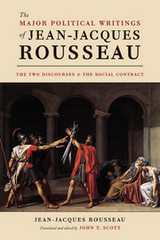 The Major Political Writings of Jean-Jacques Rousseau: The Two "Discourses" and the "Social Contract"
Jean-Jacques Rousseau
University of Chicago Press, 2012 Individualist and communitarian. Anarchist and totalitarian. Classicist and romanticist. Progressive and reactionary. Since the eighteenth century, Jean-Jacques Rousseau has been said to be all of these things. Few philosophers have been the subject of as much or as intense debate, yet almost everyone agrees that Rousseau is among the most important and influential thinkers in the history of political philosophy. This new edition of his major political writings, published in the year of the three-hundredth anniversary of his birth, renews attention to the perennial importance of Rousseau’s work. The book brings together superb new translations by renowned Rousseau scholar John T. Scott of three of Rousseau’s works: the Discourse on the Sciences and Arts, the Discourse on the Origin and Foundations of Inequality Among Men, and On the Social Contract. The two Discourses show Rousseau developing his well-known conception of the natural goodness of man and the problems posed by life in society. With the Social Contract, Rousseau became the first major thinker to argue that democracy is the only legitimate form of political organization. Scott’s extensive introduction enhances our understanding of these foundational writings, providing background information, social and historical context, and guidance for interpreting the works. Throughout, translation and editorial notes clarify ideas and terms that might not be immediately familiar to most readers. The three works collected in The Major Political Writings of Jean-Jacques Rousseau represent an important contribution to eighteenth-century political theory that has exerted an extensive influence on generations of thinkers, beginning with the leaders of the French Revolution and continuing to the present day. The new translations on offer here will be welcomed by a wide readership of both Rousseau scholars and readers with a general interest in political thought.
Major Robert Farmar of Mobile
Robert R. Rea
University of Alabama Press, 1990 The flamboyant military career of a colonist loyal to the British crown before the Revolution. "An engaging biography [and] a colorful tale. . . . Robert Farmar, a son of New Jersey, used his position among that colony's elite to secure a commission as a captain in the British Army during the War of Jenkins' Ear and King George's War, serving in the unsuccessful assaults at Cartegena, Cuba, and Panama and then in the disaster at Fontenoy in Flanders and in the reversals at Rocoux and Laffeldt. . . . During the Seven Years' War he participated in the capture of Havana.
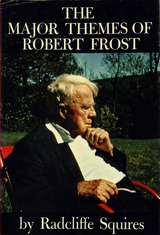 Major Themes of Robert Frost
Radcliffe Squires
University of Michigan Press, 1963 Poet, philosopher, and ambassador of culture Robert Frost has achieved a unique position in the history of American literature. His life has spanned the violent and war-torn years of the 20th century, yet his poetry is dominated by a belief in man’s sacred duty to endure. Like Emerson, Thoreau, and Dickinson, he has transcended regionalism to become a major American writer. Frost's passion for individuality has marked all great poets from Shakespeare and Keats to Dylan Thomas. He has refused to be seduced by passing literary fashions. In an age of literary dogmas, he stands alone, and his integrity is reflected again and again by his poetry. Today, recognition of Frost's work is worldwide. He is the first poet ever to have participated in the inauguration of an American president, and he toured Russia as a guest of the Soviet government. His volume of poems, In The Clearing, published during his eighty-eighth year, immediately became a best seller. But few people are aware that Frost was also once a playwright. In The Major Themes of Robert Frost, Radcliffe Squires examines the relatively unknown drama, A Way Out—a work deeply committed to a psychological view of good and evil. He also examines Frost’s important dramatic poem “West-Running Brook,” comparing its theme with philosophical ideas expressed by William James. In these as well as in other works Squires finds those qualities—the keen intelligence, the compassion, the honesty — which make Frost one of the most widely read poets in the world.
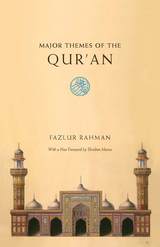 Major Themes of the Qur'an: Second Edition
Fazlur Rahman
University of Chicago Press, 2009 Major Themes of the Qur’an is Fazlur Rahman’s introduction to one of the richest texts in the history of religious thought. In this classic work, Rahman unravels the Qur’an’s complexities on themes such as God, society, revelation, and prophecy with the deep attachment of a Muslim educated in Islamic schools and the clarity of a scholar who taught for decades in the West. “Generations of scholars have profited from [Rahman’s] pioneering scholarly work by taking the questions he raised and the directions he outlined to new destinations.”--Ebrahim Moosa, from his new foreword “The religious future of Islam and the future of interfaith relationship . . . will be livelier and saner for the sort of Quranic centrality which Major Themes of the Qur’an exemplifies and serves.”--Kenneth Cragg, Middle East Journal “There shines through [a] rare combination of balanced scholarly judgment and profound personal commitment. . . . [Rahman is] eager to open up the mysteries of the Qur’an to a shrinking world sorely in need of both moral regeneration and better mutual understanding.”--Patrick D. Gaffney, Journal of Religion “I can’t think of any book more important, still, than Major Themes of the Qur’an.”--Michael Sells, author of Approaching the Qur’an
 Major Trade-Offs: The Surprising Truths about College Majors and Entry-Level Jobs
Corey Moss-Pech
University of Chicago Press, 2025 An eye-opening look at the relationship between students’ majors and their entry-level jobs.
Humanities majors are used to answering the question, “So, what are you going to do with that degree?” The common misconception is that students in humanities programs don’t learn any useful skills for the real world. In Major Trade-Offs, sociologist Corey Moss-Pech argues that not only do humanities majors learn real-world skills, but they actually use them when they graduate. Despite this discrepancy, graduates with so-called practical degrees like business and engineering are much more likely to find employment, and they earn higher salaries. Why do we belittle a liberal arts education despite the valuable skills that students acquire during their studies?
Major Trade-Offs addresses this question by following students from different majors as they enter the workforce. To understand the relationship between majors and entry-level jobs, Moss-Pech conducted nearly 200 interviews with roughly ninety students from four majors at a large Midwestern university: engineering, business, English, and communications. He follows these students through their senior years, chronicling their internships and the support their universities provide in helping them pursue their career paths. He found that graduates from practical majors entered the labor market successfully, typically through structured internship programs. However, many ended up in entry-level jobs that, while well-paid, were largely clerical and didn’t necessarily require a degree to perform. On the other hand, liberal arts majors rarely accessed structured internships and were largely left to carve out their own paths, but did use their degree skills once they secured a job. These results challenge popular myths about the “marketability” of these different majors and offer a new vision for the future of higher education. Liberal arts skills are essential in the labor market, and yet educators and policymakers still push resources into the practical arts, perpetuating the myth that those majors are more valuable while depriving students of a well-rounded education and leaving them no better prepared for the workforce than liberal arts students.
Of interest to students, educators, and employers, Major Trade-Offs calls on colleges and universities to advocate for liberal arts majors, leveling the playing field for students as they plan for entry-level work.
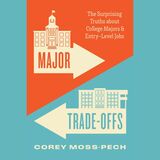 Major Trade-Offs: The Surprising Truths about College Majors and Entry-Level Jobs
Corey Moss-Pech
University of Chicago Press, 2025 This is an auto-narrated audiobook version of this book. An eye-opening look at the relationship between students’ majors and their entry-level jobs.
Humanities majors are used to answering the question, “So, what are you going to do with that degree?” The common misconception is that students in humanities programs don’t learn any useful skills for the real world. In Major Trade-Offs, sociologist Corey Moss-Pech argues that not only do humanities majors learn real-world skills, but they actually use them when they graduate. Despite this discrepancy, graduates with so-called practical degrees like business and engineering are much more likely to find employment, and they earn higher salaries. Why do we belittle a liberal arts education despite the valuable skills that students acquire during their studies?
Major Trade-Offs addresses this question by following students from different majors as they enter the workforce. To understand the relationship between majors and entry-level jobs, Moss-Pech conducted nearly 200 interviews with roughly ninety students from four majors at a large Midwestern university: engineering, business, English, and communications. He follows these students through their senior years, chronicling their internships and the support their universities provide in helping them pursue their career paths. He found that graduates from practical majors entered the labor market successfully, typically through structured internship programs. However, many ended up in entry-level jobs that, while well-paid, were largely clerical and didn’t necessarily require a degree to perform. On the other hand, liberal arts majors rarely accessed structured internships and were largely left to carve out their own paths, but did use their degree skills once they secured a job. These results challenge popular myths about the “marketability” of these different majors and offer a new vision for the future of higher education. Liberal arts skills are essential in the labor market, and yet educators and policymakers still push resources into the practical arts, perpetuating the myth that those majors are more valuable while depriving students of a well-rounded education and leaving them no better prepared for the workforce than liberal arts students.
Of interest to students, educators, and employers, Major Trade-Offs calls on colleges and universities to advocate for liberal arts majors, leveling the playing field for students as they plan for entry-level work.
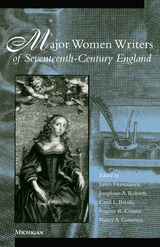 Major Women Writers of Seventeenth-Century England
James Fitzmaurice, Josephine A. Roberts, Carol L. Barash, Eugene R. Cunnar, and Nancy A. Gutierrez, Editors
University of Michigan Press, 1997 Many would find it difficult to name a woman writer in England before Jane Austen, even though women were writing as early as the time of Chaucer. It was during the seventeenth century, however, that women writers ceased to be viewed as odd or remarkable and became accepted as regular and often respected members of the literary world. The enormous commercial and artistic success of Aphra Behn's plays on the London stage of the 1670s and '80s marked the end of the time where only men were literary luminaries. Major Women Writers of Seventeenth-Century England brings together in one volume a rich assortment of writing by the women Behn influenced, as well as those who preceded her. Collected are works by Aphra Behn, Elizabeth Cary, Margaret Cavendish, Anne Finch, Aemelia Lanyer, Katherine Philips, Ester Sowernam, Rachel Speght, and Mary Wroth. The texts included are newly edited and rely on the best manuscripts and editions of the time. They are accompanied by clear introductions, helpful explanatory notes, and a range of illustrations from the period. Major Women Writers not only brings together the most significant women writers but also clearly shows the connections that exist between those who wrote without recognition in the earlier portions of this period and those who went on to celebrity status and sometimes financial success.
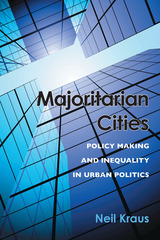 Majoritarian Cities: Policy Making and Inequality in Urban Politics
Neil Kraus
University of Michigan Press, 2013 Neil Kraus evaluates both the influence of public opinion on local policy-making and the extent to which public policy addresses economic and social inequalities. Drawing on several years of fieldwork and multiple sources of data, including surveys and polls; initiatives, referenda, and election results; government documents; focus groups; interviews; and a wide assortment of secondary sources, Kraus presents case studies of two Midwestern cities, Minneapolis, Minnesota, and Gary, Indiana. Specifically, he focuses on several major policy decisions in recent decades concerning education, law enforcement, and affordable housing in Minneapolis; and education and riverboat casino development in Gary. Kraus finds that, on these issues, local officials frequently take action that reflects public opinion, yet the resulting policies often fail to meet the needs of the disadvantaged or ameliorate the effects of concentrated poverty. In light of citizens’ current attitudes, he concludes that if patterns of inequality are to be more effectively addressed, scholars and policymakers must transform the debate about the causes and effects of inequality in urban and metropolitan settings.
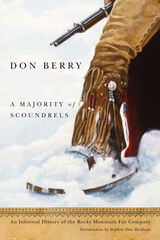 Majority of Scoundrels, A: An Informal History of the Rocky Mountain Fur Company
Don Berry
Oregon State University Press, 2006 With the skill of a historian, Don Berry set his celebrated trilogy of novels—Trask, Moontrap, and To Build a Ship—in pioneer-era Oregon. In A Majority of Scoundrels, he brings the craft of a novelist to his captivating history of the American fur trade.
Berry’s fresh and invigorating narrative captures the peak years (1822-1834) of the fur trade in the Mountain West, the period in which the Rocky Mountain Fur Company grew to be “the greatest name in the mountains.” These were heady times in which trappers and traders explored the far corners of the western country, disputed territory with Native American tribes and the Hudson’s Bay Company, learned the lore of the land, and perfected their drinking, brawling, yarn-spinning, and boasting at the annual rendezvous.
With lively prose and an ear for a good yarn, Berry brings to life the principal trappers—colorful figures including Jim Bridger, Hugh Glass (who miraculously survived the mauling of a bear and came back from death to haunt his fellows), champion liar James P. Beckwourth, Joe Meek, Jedediah Smith, Jim Clyman, and many more. Using their journals, business records, and other sources, Berry laces his back-country narrative with an analysis of the power struggle between the St. Louis businessmen who controlled the trade and the trappers.
A new introduction by historian Stephen Dow Beckham looks beyond the romantic legends of the mountain men to set A Majority of Scoundrels in the context of recent scholarship on the American West. While Beckham demonstrates just how much our sense of history has changed in the almost fifty years since Berry’s work was first published, he also helps readers understand the continuing appeal of the mythology of the fur trade era and the lasting importance of A Majority of Scoundrels.
 The Makah Indians: A Study of an Indian Tribe in Modern American Society
Elizabeth Colson
University of Minnesota Press, 1953 The Makah Indians was first published in 1953. Minnesota Archive Editions uses digital technology to make long-unavailable books once again accessible, and are published unaltered from the original University of Minnesota Press editions. Elizabeth Colson lived for a year among the Makah Indians at their reservation at Neah Bay, Washington, while engaged in the field work for this fascinating anthropological study. During that time she made friends with many of the tribe. She shared in their daily living and in their festivities. She listened with an understanding ear to their problems, to their rambling conversations, as well as to their replies in formal interviews. The result is a richly detailed description of how an American Indian group lives in modern society and an acute analysis of their social problems and adjustments. The author describes the land of the Makah, explains the origin of the tribe, and portrays their characteristic traits. In sections on the Makah and the Whites and the Makah and the Outer World, she analyzes group relationships. In another section, she describes the internal tribal rivalries that stem from the Makah tradition. Finally, she discusses the religious concepts and practices. Anthropologists will find the study of primary importance. It is significant to social scientists in other fields as well and to all readers who are concerned about race relations and the special problems of the American Indian. In chronicling the effects of the U.S. Indian Service on one tribe, the book treats an important aspect of American social history.
Make a Wish
Judy Soloway Kay
University of Michigan Press, 2005 It was love at first sight when aspiring actors Abby Nicholson and Lucas Miller met at an audition in NewYork City. After just a few months, their romance seemed destined for marriage. But will their love survive when the demands of their careers and families get in the way?
Genre: Romance
Length: about 15,000 words
Level: 4th grade
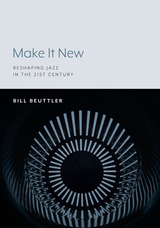 Make It New: Reshaping Jazz in the 21st Century
Bill Beuttler
Lever Press, 2019 As jazz enters its second century it is reasserting itself as dynamic and relevant. Boston Globe jazz writer and Emerson College professor Bill Beuttler reveals new ways in which jazz is engaging with society through the vivid biographies and music of Jason Moran, Vijay Iyer, Rudresh Mahanthappa, The Bad Plus, Miguel Zenón, Anat Cohen, Robert Glasper, and Esperanza Spalding. These musicians are freely incorporating other genres of music into jazz—from classical (both western and Indian) to popular (hip-hop, R&B, rock, bluegrass, klezmer, Brazilian choro)—and other art forms as well (literature, film, photography, and other visual arts). This new generation of jazz is increasingly more international and is becoming more open to women as instrumentalists and bandleaders. Contemporary jazz is reasserting itself as a force for social change, prompted by developments such as the Black Lives Matter, #MeToo movements, and the election of Donald Trump.
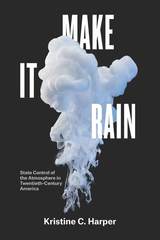 Make It Rain: State Control of the Atmosphere in Twentieth-Century America
Kristine C. Harper
University of Chicago Press, 2017 Weather control. Juxtaposing those two words is enough to raise eyebrows in a world where even the best weather models still fail to nail every forecast, and when the effects of climate change on sea level height, seasonal averages of weather phenomena, and biological behavior are being watched with interest by all, regardless of political or scientific persuasion. But between the late nineteenth century—when the United States first funded an attempt to “shock” rain out of clouds—and the late 1940s, rainmaking (as it had been known) became weather control. And then things got out of control.
In Make It Rain, Kristine C. Harper tells the long and somewhat ludicrous history of state-funded attempts to manage, manipulate, and deploy the weather in America. Harper shows that governments from the federal to the local became helplessly captivated by the idea that weather control could promote agriculture, health, industrial output, and economic growth at home, or even be used as a military weapon and diplomatic tool abroad. Clear fog for landing aircraft? There’s a project for that. Gentle rain for strawberries? Let’s do it! Enhanced snowpacks for hydroelectric utilities? Check. The heyday of these weather control programs came during the Cold War, as the atmosphere came to be seen as something to be defended, weaponized, and manipulated. Yet Harper demonstrates that today there are clear implications for our attempts to solve the problems of climate change.
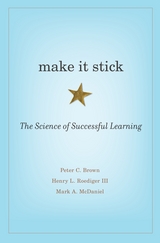 Make It Stick: The Science of Successful Learning
Peter C. Brown, Henry L. Roediger III, and Mark A. McDaniel
Harvard University Press, 2014 The international bestseller that has helped millions of students, teachers, and lifelong learners use proven approaches to learn better and remember longer.
“We have made Make It Stick a touchstone for our instructors … to gain a real advantage for our learners as they tackle some of the toughest work in the world.” —Carl Czech, former Senior Instructional Systems Specialist/Advisor, US Navy SEALs
Are you tired of forgetting what you learn? This groundbreaking book, based on the latest research in cognitive science, offers powerful strategies to boost memory and learning.
To most of us, learning something “the hard way” means wasted time and effort. Good teaching, many believe, should be tailored to the different learning styles of students and should use strategies that make learning easier. Make It Stick turns fashionable ideas like these on their head. Drawing on recent discoveries in cognitive psychology and a ten-year collaboration among some of the world’s leading experts on human learning and memory, the authors explain what really drives successful learning. With clear, real-world examples, they show how we can confidently hone our skills and learn more effectively.
Many common study habits simply don’t work. Underlining, highlighting, rereading, cramming, and single-minded repetition of new skills create the illusion of mastery, but gains fade quickly. Science shows that more durable learning comes from self-testing, introducing certain difficulties in practice, waiting to re-study new material until a little forgetting has occurred, and interleaving the practice of one skill or topic with another. Make It Stick breaks down these proven approaches in compelling ways and offers concrete techniques for becoming more productive learners.
Full of eye-opening and inspiring stories for students, educators, and parents, Make It Stick is an indispensable guide for all those interested in the challenge of lifelong learning and self-improvement.
 Make It Stick: The Science of Successful Learning
Peter C. Brown, Henry L. Roediger III, and Mark A. McDaniel
Harvard University Press A Chronicle of Higher Education “Top 10 Books on Teaching” Selection
To most of us, learning something “the hard way” implies wasted time and effort. Good teaching, we believe, should be creatively tailored to the different learning styles of students and should use strategies that make learning easier. Make It Stick turns fashionable ideas like these on their head. Drawing on recent discoveries in cognitive psychology and other disciplines, the authors offer concrete techniques for becoming more productive learners.
“If you want to read a lively and engaging book on the science of learning, this is a must.”
—Hazel Christie, Times Higher Education
“Many educators are interested in making use of recent findings about the human brain and how we learn…Make It Stick [is] the single best work I have encountered on the subject. Anyone with an interest in teaching or learning will benefit from reading this book.”
—James M. Lang, Chronicle of Higher Education
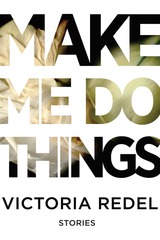 Make Me Do Things
Victoria Redel
Four Way Books, 2013 In eleven original, surprising and deliciously dark stories, Victoria Redel moves effortlessly between men’s and women’s perspectives in stories that explore marriage, divorce and parenthood. A newly divorced mother stumbles her way back into single life. A young man and his girlfriend clean out his dead mother’s overstuffed home. A woman struggles to hide her affair from a doting husband and inquisitive daughter. A man descends into a drug-fueled dream as he imagines losing his pregnant wife to a historical, nineteenth century figure. Redel indelibly captures the ways we love, the ways we yearn and the ways we sabotage each. Throughout the collection, children struggle to make sense of the adult world’s uncertainties as husbands and wives, mothers and fathers, find themselves pressed up against their own limits, “the exaltations and treasons of one’s own mothy heart.” Redel has again done what Grace Paley said of Redel’s first collection, “Only a poet could have written this prose. Only a storyteller could keep a reader turning these pages so greedily.”
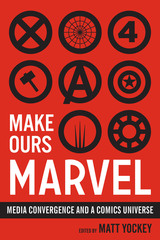 Make Ours Marvel: Media Convergence and a Comics Universe
Edited by Matt Yockey
University of Texas Press, 2017 The creation of the Fantastic Four effectively launched the Marvel Comics brand in 1961. Within ten years, the introduction (or reintroduction) of characters such as Spider-Man, the Hulk, Iron Man, Captain America, and the X-Men catapulted Marvel past its primary rival, DC Comics, for domination of the comic book market. Since the 2000s, the company’s iconic characters have leaped from page to screens with the creation of the Marvel Cinematic Universe, which includes everything from live-action film franchises of Iron Man and the Avengers to television and streaming media, including the critically acclaimed Netflix series Daredevil and Jessica Jones. Marvel, now owned by Disney, has clearly found the key to transmedia success. Make Ours Marvel traces the rise of the Marvel brand and its transformation into a transmedia empire over the past fifty years. A dozen original essays range across topics such as how Marvel expanded the notion of an all-star team book with The Avengers, which provided a roadmap for the later films, to the company’s attempts to create lasting female characters and readerships, to its regular endeavors to reinvigorate its brand while still maintaining the stability that fans crave. Demonstrating that the secret to Marvel’s success comes from adeptly crossing media boundaries while inviting its audience to participate in creating Marvel’s narrative universe, this book shows why the company and its characters will continue to influence storytelling and transmedia empire building for the foreseeable future.
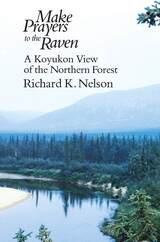 Make Prayers to the Raven: A Koyukon View of the Northern Forest
Richard K. Nelson
University of Chicago Press, 1986 "Nelson spent a year among the Koyukon people of western Alaska, studying their intimate relationship with animals and the land. His chronicle of that visit represents a thorough and elegant account of the mystical connection between Native Americans and the natural world."—Outside
"This admirable reflection on the natural history of the Koyukon River drainage in Alaska is founded on knowledge the author gained as a student of the Koyukon culture, indigenous to that region. He presents these Athapascan views of the land—principally of its animals and Koyukon relationships with those creatures—together with a measured account of his own experiences and doubts. . . . For someone in search of a native American expression of 'ecology' and natural history, I can think of no better place to begin than with this work."—Barry Lopez, Orion Nature Quarterly
"Far from being a romantic attempt to pass on the spiritual lore of Native Americans for a quick fix by others, this is a very serious ethnographic study of some Alaskan Indians in the Northern Forest area. . . . He has painstakingly regarded their views of earth, sky, water, mammals and every creeping thing that creepeth upon the earth. He does admire their love of nature and spirit. Those who see the world through his eyes using their eyes will likely come away with new respect for the boreal forest and those who live with it and in it, not against it."—The Christian Century
"In Make Prayers to the Raven Nelson reveals to us the Koyukon beliefs and attitudes toward the fauna that surround them in their forested
habitat close to the lower Yukon. . . . Nelson's presentation also gives rich insights into the Koyukon subsistence cycle through the year and into the hardships of life in this northern region. The book is written with both brain and heart. . . . This book represents a landmark: never before has the integration of American Indians with their environment been so well spelled out."—Ake Hultkrantz, Journal of Forest History
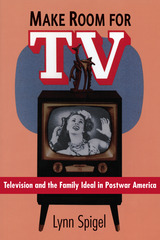 Make Room for TV: Television and the Family Ideal in Postwar America
Lynn Spigel
University of Chicago Press, 1992 Between 1948 and 1955, nearly two-thirds of all American families bought a television set—and a revolution in social life and popular culture was launched.
In this fascinating book, Lynn Spigel chronicles the enormous impact of television in the formative years of the new medium: how, over the course of a single decade, television became an intimate part of everyday life. What did Americans expect from it? What effects did the new daily ritual of watching television have on children? Was television welcomed as an unprecedented "window on the world," or as a "one-eyed monster" that would disrupt households and corrupt children?
Drawing on an ambitious array of unconventional sources, from sitcom scripts to articles and advertisements in women's magazines, Spigel offers the fullest available account of the popular response to television in the postwar years. She chronicles the role of television as a focus for evolving debates on issues ranging from the ideal of the perfect family and changes in women's role within the household to new uses of domestic space. The arrival of television did more than turn the living room into a private theater: it offered a national stage on which to play out and resolve conflicts about the way Americans should live.
Spigel chronicles this lively and contentious debate as it took place in the popular media. Of particular interest is her treatment of the way in which the phenomenon of television itself was constantly deliberated—from how programs should be watched to where the set was placed to whether Mom, Dad, or kids should control the dial.
Make Room for TV combines a powerful analysis of the growth of electronic culture with a nuanced social history of family life in postwar America, offering a provocative glimpse of the way television became the mirror of so many of America's hopes and fears and dreams.
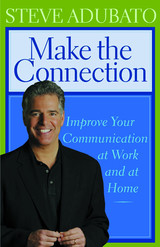 Make the Connection: Improve Your Communication at Work and at Home
Adubato, Steve
Rutgers University Press, 2006 In this collection of compelling and practical essays, Emmy Award–winning broadcaster, newspaper columnist, and motivational speaker Steve Adubato shares concrete tips and tools that will help you connect more effectively at work, at home, under pressure, in leadership roles, and in high-tech environments. From avoiding unnecessary arguments with your spouse to coaching a valuable, yet difficult employee, Adubato’s essays delve into the key factors that motivate people to act and respond the way that they do. You will find answers to some of the most common questions about public speaking as well as advice on overcoming its anxieties. Whether the forum is a PTA meeting or a large professional function, essays explore topics such as: - Why even practiced speakers sometimes experience stage fright
- How to keep your audience awake and interested in what you are saying
You will learn essential skills for interacting in the workplace, including: - How to negotiate a good deal and still be honest and straight
- How to keep team projects from falling apart
- How to conduct yourself in confrontational situations, such as receiving a public insult
Drawing on examples set by public figures, including Bill Clinton, Rudy Giuliani, Mario Cuomo, Martha Stewart, Jack Welch, Joe Torre, and many others, Adubato addresses the unique communication challenges that those in leadership positions face. Essays examine: · What ordinary people can learn from leaders in high-profile positions · Why so many leaders have difficulty taking responsibility and apologizing for their actions As technology continues to provide opportunities for quicker and more visual communication, Adubato also lets you know when hi-tech bells and whistles get in the way of making a more personal and human connection. For instance, · Why do we hide behind e-mail messages when we have something very difficult to say? · How does communication deteriorate when cell phones and e-mail are competing for our attention? Finally, Adubato reminds us that communicating at home is no less important or any less difficult than communicating in public or at work. From contemporary challenges to age-old questions, essays explore: · How you can more effectively talk with your kids about war and terrorism · What forms of persuasion are more effective than nagging Filled with timely examples and practical suggestions, Make the Connection is a must-read for everyone looking to improve their professional and personal relationships.
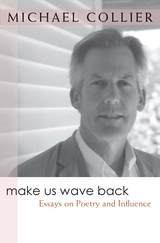 Make Us Wave Back: Essays on Poetry and Influence
Michael Collier
University of Michigan Press, 2007 “Michael Collier’s book is refreshing in its refusal to push for one particular aesthetic. He regards his own preference for realism over abstraction as more a matter of temperament than of considered judgment, and respects poets more skeptical than he is about the ability of poetry to connect with the world. The result is an engaging record of his influences and enthusiasms, which are wide enough to include both Whitman and Larkin, both Jorge Borges and William Maxwell.” —Carl Dennis, Pulitzer Prize–winning author of Unknown Friends and Practical Gods “Michael Collier combines pietas and wildness in these essays on poetry as inheritance, and poetry as struggle. One feels the young man in his ‘rampage of literature,’ and the older writer reflecting on an art that is at once personal and impersonal, deeply matured in the imagination. This is a wise and well-lived book.” —Rosanna Warren, author of Departure and Stained Glass “The essays and remembrances in Make Us Wave Back radiate Michael Collier’s characteristic insight and sagacity on every page. Clear-minded, ardent, brightly illuminating the art of poetry, this is as lucid as writing about writing gets.” —Campbell McGrath, author of Pax Atomica and Florida Poems National Book Critics Circle Award finalist Michael Collier explores the influences that have made him one of the most distinguished poets of his generation. Make Us Wave Back includes essays on an expansive list of subjects, among them the literary correspondence of William Maxwell; the meaning of the author’s own role as poet laureate of the state of Maryland; the journals of Louise Bogan and how they reveal Bogan’s struggle with her own personal fears as well as the reconstruction of herself as a writer; and many more. Michael Collier is Professor of English and Codirector of the creative writing program at the University of Maryland. He is also director of the Bread Loaf Writers’ Conference. He is the author of several books of poems, including The Clasp and Other Poems, The Folded Heart, and The Ledge.
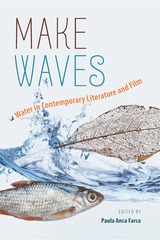 Make Waves: Water in Contemporary Literature and Film
Paula Anca Farca
University of Nevada Press, 2019 Water is a symbol of life, wisdom, fertility, purity, and death. Water also sustains and nourishes, irrigates our crops, keeps us clean and healthy, and contributes to our energy needs. But a strain has been put on our water resources as increased energy demands combine with the effects of climate change to create a treacherous environment. Individuals and communities around the globe increasingly face droughts, floods, water pollution, water scarcity, and even water wars. We tend to address and solve these concerns through scientific and technological innovations, but social and cultural analyses and solutions are needed as well.
In this edited collection, contributors tackle current water issues in the era of climate change using a wide variety of recent literature and film. At its core, this collection demonstrates that water is an immense reservoir of artistic potential and an agent of historical and cultural exchange. Creating familiar and relatable contexts for water dilemmas, authors and directors of contemporary literary texts and films present compelling stories of our relationships to water, water health, ecosystems, and conservation. They also explore how global water problems affect local communities around the world and intersect with social and cultural aspects such as health, citizenship, class, gender, race, and ethnicity.
This transformative work highlights the cultural significance of water—the source of life and a powerful symbol in numerous cultures. It also raises awareness about global water debates and crises.
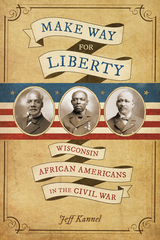 Make Way for Liberty: Wisconsin African Americans in the Civil War
Jeff Kannel
Wisconsin Historical Society Press, 2020 Hundreds of African American soldiers and regimental employees represented Wisconsin in the Civil War, and many of them lived in the state either before or after the conflict. And yet, if these individuals are mentioned at all in histories of the state, it is with a sentence or two about their small numbers, or the belief that they all were from slaveholding states and served as substitutes for Wisconsin draftees. Relative to the total number of Badgers who served in the Civil War, African Americans soldiers were few, but they constituted a significant number in at least five regiments of the United States Colored Infantry and several other companies. Their lives before and after the war in rural communities, small towns, and cities form an enlightening story of acceptance and respect for their service but rejection and discrimination based on their race. Make Way for Liberty will bring clarity to the questions of how many African Americans represented Wisconsin during the conflict, who among them lived in the state before and after the war, and their impact on their communities
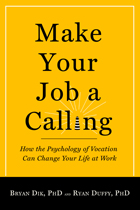 Make Your Job a Calling: How the Psychology of Vocation Can Change Your Life at Work
Bryan J. Dik
Templeton Press, 2013 Do you ever feel sick of your job? Do you ever envy those people who seem to positively love what they do? While those people head off to work with a sense of joy and purpose, for the rest of us trudging back to the office on Monday morning or to the factory for the graveyard shift or to the job site on a hundred-degree day can be an exercise in soul crushing desperation. “If only we could change jobs,” we tell ourselves, “that would make it better.” But we don’t have the right education . . . or we don’t have enough experience . . . or the economy isn’t right . . . or we can’t afford the risk right now. So we keep going back to the same old unsatisfying jobs. The wonderful truth, though, is that almost any kind of occupation can offer any one of us a sense of calling. Regardless of where we are in our careers, we can all find joy and meaning in the work we do, from the construction zone flagger who keeps his crew safe to the corporate executive who believes that her company’s products will change the world. In Make Your Job a Calling authors Bryan J. Dik and Ryan D. Duffy explore this powerful idea and help the reader navigate the many challenges—both internal and external—that may arise along the pathway to a sense of calling at work. Over the course of four sections, the authors define the idea of calling, review cutting-edge research on the subject, provide practical guidelines for discerning a calling at all stages of work and life, and explore what calling will look like as workplace norms continue to evolve. They also take pains to present a realistic view of the subject by unpacking the perils and challenges of pursuing one’s higher purpose, especially in an uncertain economy. The lessons presented will resound with anyone in any line of work and will show how the power of calling can beneficially shape individuals, organizations, and society as a whole.
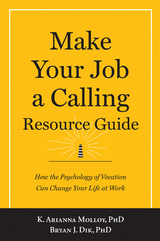 Make Your Job a Calling Resource Guide
Bryan J. Dik
Templeton Press, 2014 Whether you feel stuck or overwhelmed, hopeful or uncertain, or energized and ready to go, the Make Your Job a Calling Resourse Guide can assist you in that journey.
It is designed to assist instructors, book study leaders, career counselors, human resources professionals, and individual readers who seek to delve deeper into the book, Make Your Job a Calling. In each chapter of the guide, the reader is given (1) a chapter summary, (2) general themes, (3) discussion questions, and (4) suggested activities. The suggested activities often involve a free write where you are encouraged to write your thoughts down without editing yourself. In a free-write you are not concerned with proper grammar or punctuation. Rather, you write your immediate thoughts down in a free-flowing manner. This allows for deep exploration and can inform rich discussion of ideas in a productive learning environment.
The elements in this guide are designed to facilitate the reflection and discussion process, providing readers with useful starting points. Of course, not all group leaders will find every question or activity useful for their particular group, which is why we encourage flexible use of the material. By all means, pick, choose, add to, and adapt according to your sense of what will be most helpful for the group you are leading.
Whether you feel stuck or overwhelmed, hopeful or uncertain, or energized and ready to go, this guide can assist you in that journey.
 Make Your Own Job: How the Entrepreneurial Work Ethic Exhausted America
Erik Baker
Harvard University Press, 2025 A sweeping new history of the changing meaning of work in the United States, from Horatio Alger to Instagram influencers.
How Americans think about work changed profoundly over the course of the twentieth century. Thrift and persistence came to seem old-fashioned. Successful workers were increasingly expected to show initiative and enthusiasm for change—not just to do their jobs reliably but to create new opportunities for themselves and for others. Our culture of work today is more demanding than ever, even though workers haven't seen commensurate rewards.
Make Your Own Job explains how this entrepreneurial work ethic took hold, from its origins in late nineteenth-century success literature to the gig economy of today, sweeping in strange bedfellows: Marcus Garvey and Henry Ford, Avon ladies and New Age hippies. Business schools and consultants exhorted managers to cultivate the entrepreneurial spirit in their subordinates, while an industry of self-help authors synthesized new ideas from psychology into a vision of work as “self-realization.” Policy experts embraced the new ethic as a remedy for urban and Third World poverty. Every social group and political tendency, it seems, has had its own exemplary entrepreneurs.
Historian Erik Baker argues that the entrepreneurial work ethic has given meaning to work in a world where employment is ever more precarious––and in doing so, has helped legitimize a society of mounting economic insecurity and inequality. From the advent of corporate capitalism in the Gilded Age to the economic stagnation of recent decades, Americans have become accustomed to the reality that today’s job may be gone tomorrow. Where work is hard to find and older nostrums about diligent effort fall flat, the advice to “make your own job” keeps hope alive.
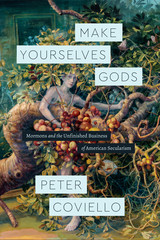 Make Yourselves Gods: Mormons and the Unfinished Business of American Secularism
Peter Coviello
University of Chicago Press, 2019 From the perspective of Protestant America, nineteenth-century Mormons were the victims of a peculiar zealotry, a population deranged––socially, sexually, even racially––by the extravagances of belief they called “religion.” Make Yourselves Gods offers a counter-history of early Mormon theology and practice, tracking the Saints from their emergence as a dissident sect to their renunciation of polygamy at century’s end.
Over these turbulent decades, Mormons would appear by turns as heretics, sex-radicals, refugees, anti-imperialists, colonizers, and, eventually, reluctant monogamists and enfranchised citizens. Reading Mormonism through a synthesis of religious history, political theology, native studies, and queer theory, Peter Coviello deftly crafts a new framework for imagining orthodoxy, citizenship, and the fate of the flesh in nineteenth-century America. What emerges is a story about the violence, wild beauty, and extravagant imaginative power of this era of Mormonism—an impassioned book with a keen interest in the racial history of sexuality and the unfinished business of American secularism.
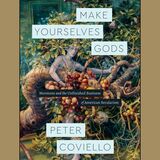 Make Yourselves Gods: Mormons and the Unfinished Business of American Secularism
Peter Coviello
University of Chicago Press, 2019 This is an auto-narrated audiobook edition of this book.
From the perspective of Protestant America, nineteenth-century Mormons were the victims of a peculiar zealotry, a population deranged––socially, sexually, even racially––by the extravagances of belief they called “religion.” Make Yourselves Gods offers a counter-history of early Mormon theology and practice, tracking the Saints from their emergence as a dissident sect to their renunciation of polygamy at century’s end.
Over these turbulent decades, Mormons would appear by turns as heretics, sex-radicals, refugees, anti-imperialists, colonizers, and, eventually, reluctant monogamists and enfranchised citizens. Reading Mormonism through a synthesis of religious history, political theology, native studies, and queer theory, Peter Coviello deftly crafts a new framework for imagining orthodoxy, citizenship, and the fate of the flesh in nineteenth-century America. What emerges is a story about the violence, wild beauty, and extravagant imaginative power of this era of Mormonism—an impassioned book with a keen interest in the racial history of sexuality and the unfinished business of American secularism.
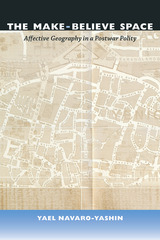 The Make-Believe Space: Affective Geography in a Postwar Polity
Yael Navaro-Yashin
Duke University Press, 2012 The Make-Believe Space is a book of ethnographic and theoretical meditation on the phantasmatic entanglement of materialities in the aftermath of war, displacement, and expropriation. "Northern Cyprus," carved out as a separate space and defined as a distinct (de facto) polity since its invasion by Turkey in 1974, is the subject of this ethnography about postwar politics and social relations. Turkish-Cypriots' sociality in a reforged geography, rid of its former Greek-Cypriot inhabitants after the partition of Cyprus, forms the centerpiece of Yael Navaro-Yashin's conceptual exploration of subjectivity in the context of "ruination" and "abjection." The unrecognized state in Northern Cyprus unfolds through the analytical devices that she develops as she explores this polity's administration and raison d'être via affect theory. Challenging the boundaries between competing theoretical orientations, Navaro-Yashin crafts a methodology for the study of subjectivity and affect, and materiality and the phantasmatic, in tandem. In the process, she creates a subtle and nuanced ethnography of life in the long-term aftermath of war.
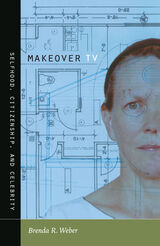 Makeover TV: Selfhood, Citizenship, and Celebrity
Brenda R. Weber
Duke University Press, 2009 In 2004, roughly 25 makeover-themed reality shows aired on U.S. television. By 2009, there were more than 250, from What Not to Wear and The Biggest Loser to Dog Whisperer and Pimp My Ride. In Makeover TV, Brenda R. Weber argues that whether depicting transformations of bodies, trucks, finances, relationships, kids, or homes, makeover shows posit a self achievable only in the transition from the “Before-body”—the overweight figure, the decrepit jalopy, the cluttered home—to the “After-body,” one filled with confidence, coded with celebrity, and imbued with a renewed faith in the powers of meritocracy. The rationales and tactics invoked to achieve the After-body vary widely, from the patriotic to the market-based, and from talk therapy to feminist empowerment. The genre is unified by its contradictions: to uncover your “true self,” you must be reinvented; to be empowered, you must surrender to experts; to be special, you must look and act like everyone else. Based on her analysis of more than 2,500 hours of makeover TV, Weber argues that the much-desired After-body speaks to and makes legible broader cultural narratives about selfhood, citizenship, celebrity, and Americanness. Although makeovers are directed at both male and female viewers, their gendered logic requires that feminized subjects submit to the controlling expertise wielded by authorities. The genre does not tolerate ambiguity. Conventional (middle-class, white, ethnically anonymous, heterosexual) femininity is the goal of makeovers for women. When subjects are male, makeovers often compensate for perceived challenges to masculine independence by offering men narrative options for resistance or control. Foregoing a binary model of power and subjugation, Weber provides an account of makeover television that is as appreciative as it is critical. She reveals the makeover show as a rich and complicated text that expresses cultural desires and fears through narratives of selfhood.
The Makepeace Experiment
Abram Tertz
Northwestern University Press, 1989 Lenny Makepeace uses magic and propaganda to lead Russia to a Marxist utopia.
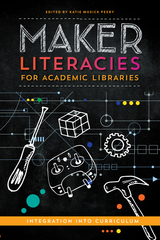 Maker Literacies for Academic Libraries: Integration into Curriculum
Edited by Katie Musick Peery
American Library Association, 2020 Melding universities’ strategic goals with libraries’ teaching and learning mission, the academic library makerspace can be a powerful catalyst for information literacy, offering faculty partners a place for interdisciplinary, experiential learning. If you’re pondering what it takes to get your makerspace into the curriculum, this volume’s relatable, first-hand accounts from librarians, makerspace staff, and faculty partners will give you the confidence to make the leap. Contributors, drawn from the IMLS-funded Maker Literacies project, describe pilots and assessment for a variety of demographics, course subjects, and makerspace equipment. Guided by their experiences, you’ll be ready to fully partner with faculty through the course integration and assessment process. Inside, you’ll learn - why academic librarians are uniquely situated to be leaders in the realm of makerspaces and makerspace literacy;
- how the ACRL Framework informs maker competencies;
- methods for using competencies and assessment in designing course assignments;
- 5 steps for guiding faculty in creating assignments for makerspaces;
- advice on developing a new staffing and service model to handle course-wide use of the makerspace;
- steps for taking students through concept, design, prototype, and final product in a project management course;
- how an ethical perspective engaged a women’s history course toward the “In Her Shoes” project;
- pedagogical strategies for integrating the makerspace into fine arts classes; and
- ways to showcase makerspace outputs to generate excitement around campus.
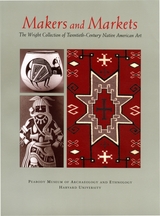 Makers and Markets: The Wright Collection of Twentieth-Century Native American Art
Penelope Ballard Drooker
Harvard University Press, 1998 The decades of the 1960s, ’70s, and ’80s were a time of growth and change in producing, marketing, and collecting Native American artwork and craftwork. During this time William R. Wright amassed a collection notable for its broad representation of twentieth-century Native American products. Focusing on the Southwest, he included contemporary Pueblo ceramics, Navajo and Hopi textiles, Navajo, Hopi, and Zuni jewelry, and baskets from some forty different Native American groups. The objects Wright gathered, which are now part of the collections of the Peabody Museum of Archaeology and Ethnology, reflect developments in the intersecting worlds of makers, markets, and collectors, including the challenges faced by makers to successfully balance tradition and innovation in their work and their lives.
This volume examines selected objects from the Wright collection to explore the market-influenced environment of modern Native American makers and their work, from what some consider the low end of tourist art multiples to the high end of unique, signed fine art objects.
 Makers of Democracy: A Transnational History of the Middle Classes in Colombia
A. Ricardo López-Pedreros
Duke University Press, 2019 In Makers of Democracy A. Ricardo López-Pedreros traces the ways in which a thriving middle class was understood to be a foundational marker of democracy in Colombia during the second half of the twentieth century. Drawing on a wide array of sources ranging from training manuals and oral histories to school and business archives, López-Pedreros shows how the Colombian middle class created a model of democracy based on free-market ideologies, private property rights, material inequality, and an emphasis on a masculine work culture. This model, which naturalized class and gender hierarchies, provided the groundwork for Colombia's later adoption of neoliberalism and inspired the emergence of alternate models of democracy and social hierarchies in the 1960s and 1970s that helped foment political radicalization. By highlighting the contested relationships between class, gender, economics, and politics, López-Pedreros theorizes democracy as a historically unstable practice that exacerbated multiple forms of domination, thereby prompting a rethinking of the formation of democracies throughout the Americas.
The Makers of Europe
Robert Seymour Conway
Harvard University Press The four “makers” considered in this volume are Julius Caesar, Cicero, Horace, and Virgil. Professor Conway studies the personalities of these ancient Romans primarily to make clear how the course of history was changed by them and especially by their more personal characteristics. Once more he has brought close home to the sympathies of the modern man, all the warm humanity of the people of ancient times. He treats his men not as cold marble images of perfection, but as human beings of like passions with ourselves. Whether he points out weaknesses or elements of nobility, he interprets the past with sympathy and insight. It is a book for all lovers of letters, and can be especially recommended for the use of those young people in our schools and colleges who are reading the classic authors or studying the course of Roman history.
 Makers of Modern Asia
Ramachandra Guha
Harvard University Press, 2014 Hardly more than a decade old, the twenty-first century has already been dubbed the Asian Century in recognition of China and India’s increasing importance in world affairs. Yet discussions of Asia seem fixated on economic indicators—gross national product, per capita income, share of global trade. Makers of Modern Asia reorients our understanding of contemporary Asia by highlighting the political leaders, not billionaire businessmen, who helped launch the Asian Century.
The nationalists who crafted modern Asia were as much thinkers as activists, men and women who theorized and organized anticolonial movements, strategized and directed military campaigns, and designed and implemented political systems. The eleven thinker-politicians whose portraits are presented here were a mix of communists, capitalists, liberals, authoritarians, and proto-theocrats—a group as diverse as the countries they represent.
From China, the world’s most populous country, come four: Mao Zedong, leader of the Communist Revolution; Zhou Enlai, his close confidant; Deng Xiaoping, purged by Mao but rehabilitated to play a critical role in Chinese politics in later years; and Chiang Kai-shek, whose Kuomintang party formed the basis of modern Taiwan. From India, the world’s largest democracy, come three: Mohandas Gandhi, Jawaharlal Nehru, and Indira Gandhi, all of whom played crucial roles in guiding India toward independence and prosperity. Other exemplary nationalists include Vietnam’s Ho Chi Minh, Indonesia’s Sukarno, Singapore’s Lee Kuan Yew, and Pakistan’s Zulfiqar Ali Bhutto. With contributions from leading scholars, Makers of Modern Asia illuminates the intellectual and ideological foundations of Asia’s spectacular rise to global prominence.
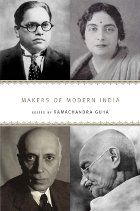 Makers of Modern India
Ramachandra Guha
Harvard University Press, 2013 Modern India is the world's largest democracy, a sprawling, polyglot nation containing one-sixth of all humankind. The existence of such a complex and distinctive democratic regime qualifies as one of the world's bona fide political miracles. Furthermore, India's leading political thinkers have often served as its most influential political actors—think of Gandhi, whose collected works run to more than ninety volumes, or Ambedkar, or Nehru, who recorded their most eloquent theoretical reflections at the same time as they strove to set the delicate machinery of Indian democracy on a coherent and just path.
Out of the speeches and writings of these thinker-activists, Ramachandra Guha has built the first major anthology of Indian social and political thought. Makers of Modern India collects the work of nineteen of India's foremost generators of political sentiment, from those whose names command instant global recognition to pioneering subaltern and feminist thinkers whose works have until now remained obscure and inaccessible. Ranging across manifold languages and cultures, and addressing every crucial theme of modern Indian history—race, religion, language, caste, gender, colonialism, nationalism, economic development, violence, and nonviolence—Makers of Modern India provides an invaluable roadmap to Indian political debate.
An extensive introduction, biographical sketches of each figure, and guides to further reading make this work a rich resource for anyone interested in India and the ways its leading political minds have grappled with the problems that have increasingly come to define the modern world.
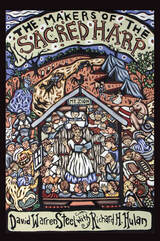 The Makers of the Sacred Harp
David Warren Steel with Richard H. Hulan
University of Illinois Press, 2010 This authoritative reference work investigates the roots of the Sacred Harp, the central collection of the deeply influential and long-lived southern tradition of shape-note singing. Where other studies of the Sacred Harp have focused on the sociology of present-day singers and their activities, David Warren Steel and Richard H. Hulan concentrate on the regional culture that produced the Sacred Harp in the nineteenth century and delve deeply into history of its authors and composers. They trace the sources of every tune and text in the Sacred Harp, from the work of B. F. White, E. J. King, and their west Georgia contemporaries who helped compile the original collection in 1844 to the contributions by various composers to the 1936 to 1991 editions. The Makers of the Sacred Harp also includes analyses of the textual influences on the music--including metrical psalmody, English evangelical poets, American frontier preachers, camp meeting hymnody, and revival choruses--and essays placing the Sacred Harp as a product of the antebellum period with roots in religious revivalism. Drawing on census reports, local histories, family Bibles and other records, rich oral interviews with descendants, and Sacred Harp Publishing Company records, this volume reveals new details and insights about the history of this enduring American musical tradition.
Makerspaces
Caitlin A. Bagley
American Library Association, 2014
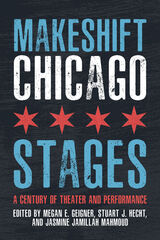 Makeshift Chicago Stages: A Century of Theater and Performance
Edited by Megan E. Geigner, Stuart J. Hecht, and Jasmine Jamillah Mahmoud
Northwestern University Press, 2021 Since Chicago’s founding, theater has blossomed in the city’s makeshift spaces, from taverns to parks, living rooms to storefronts. Makeshift Chicago Stages brings together leading historians to share the history of theater and performance in the Second City. The essays collected here theorize a regional theater history and aesthetic that are inherently improvisational, rough-and-tumble, and marginal, reflecting the realities of a hypersegregated city and its neighborhoods. Space and place have contributed to Chicago’s reputation for gritty, ensemble-led work, part of a makeshift ethos that exposes the policies of the city and the transgressive possibilities of performance.
This book examines the rise and proliferation of Chicago’s performance spaces, which have rooted the city’s dynamic, thriving theater community. Chapters cover well‑known, groundbreaking, and understudied theatrical sites, ensembles, and artists, including the 1893 Columbian Exposition Midway Plaisance, the 57th Street Artist Colony, the Fine Arts Building, the Goodman Theatre, the Federal Theatre Project, the Kingston Mines and Body Politic Theaters, ImprovOlympics (later iO), Teatro Vista, Theaster Gates, and the Chicago Home Theater Festival. By putting space at the center of the city’s theater history, the authors in Makeshift Chicago Stages spotlight the roles of neighborhoods, racial dynamics, atypical venues, and borders as integral to understanding the work and aesthetics of Chicago’s artists, ensembles, and repertoires, which have influenced theater practices worldwide. Featuring rich archival work and oral histories, this anthology will prove a valuable resource for theater historians, as well as anyone interested in Chicago’s cultural heritage.
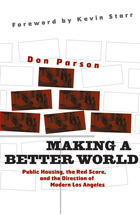 Making a Better World: Public Housing, the Red Scare, and the Direction of Modern Los Angeles
Don Parson
University of Minnesota Press, 2005 During the 1990s, Los Angeles - like many other cities across America - began demolishing public housing projects that had come to symbolize decades of failed urban policies. But public housing was not always regarded with such disdain. In the years surrounding World War II, it had been a popular New Deal program, viewed as a force for positive social change and supported by a broad coalition of civic, labor, religious, and community organizations. Socially conscious architects and planners developed innovative and livable projects that embodied the latest theories in urban design. With sharp historical perspective, Making a Better World traces the rise and fall of a public housing ethic in Los Angeles and its impact on the city's built environment. In the caustic political atmosphere of Joseph McCarthy's America, public housing opponents accused the city's housing authority of communist infiltration, effectively eliminating the left from debates over the city's development. In place of public housing, conservative forces promoted a pro-private growth agenda that redefined urban renewal and reshaped modern Los Angeles. No conventional public housing projects have been constructed in Los Angeles since 1955. In this era of skyrocketing housing prices, especially in urban areas, Don Parson's examination not only gives us the recent history of a city, but also opens up a new debate on a current national crisis in providing shelter for low-income Americans.
Making a Canon: Ananda K. Coomaraswamy, Sri Lanka, and the Place of Buddhist Art
Janice Leoshko
University of Chicago Press, 2024 The story of how one scholar’s experiences in Sri Lanka shaped the contours of the Buddhist visual canon.
An early interpreter of Buddhist art to the West, Ananda Kentish Coomaraswamy laid the foundation of what would become the South Asian visual canon, particularly through his efforts to understand how Buddhist art emerged and developed. In Making a Canon, Janice Leoshko examines how Coomaraswamy’s experience as the director of a mineralogical survey in Sri Lanka shaped his understanding of South Asian art and religion. Along the way, she reveals how Coomaraswamy’s distinctive repetition of Sri Lankan visual images in his work influenced the direction of South Asia’s canon formation and left a lasting impression on our understanding of Buddhist art.
 Making a Christian Landscape: The countryside in early-medieval Cornwall, Devon and Wessex
Sam Turner
University of Exeter Press, 2006
Sam Turner’s important new interpretation of early medieval patterns of landscape development traces landscape change in the South West from the introduction of Christianity to the Norman Conquest (AD c. 450–1070).
It stresses the significance of political and religious ideology in both the ‘Celtic’ west (especially Cornwall) and the ‘Anglo-Saxon’ east (especially the Wessex counties of Devon, Somerset, Wiltshire and Dorset). Using innovative new research methods, and making use of archaeology, place-name evidence, historical sources and land-use patterns, it challenges previous work on the subject by suggesting that the two regions have much in common.
Using modern mapping techniques to explore land-use trends, Turner advances a new model for the evolution of ecclesiastical institutions in south-west England. He shows that the early development of Christianity had an impact on the countryside that remains visible in the landscape we see today. Accessibly written with a glossary of terms and a comprehensive bibliography, the book will appeal to both veterans and newcomers to landscape archaeology.
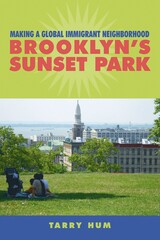 Making a Global Immigrant Neighborhood: Brooklyn's Sunset Park
Tarry Hum
Temple University Press, 2014 Based on more than a decade of research, Making a Global Immigrant Neighborhood charts the evolution of Sunset Park--with a densely concentrated working-poor and racially diverse immigrant population--from the late 1960s to its current status as one of New York City's most vibrant neighborhoods. Tarry Hum shows how processes of globalization, such as shifts in low-wage labor markets and immigration patterns, shaped the neighborhood. She explains why Sunset Park's future now depends on Asian and Latino immigrant collaborations in advancing common interests in community building, civic engagement, entrepreneurialism, and sustainability planning. She shows, too, how residents' responses to urban development policies and projects and the capital represented by local institutions and banks foster community activism. Hum pays close attention to the complex social, political, and spatial dynamics that forge a community and create new models of leadership as well as coalitions. The evolution of Sunset Park so astutely depicted in this book suggests new avenues for studying urban change and community development.
Making a Great Ruler: Grand Duke Vytautas of Lithuania
Giedre Mickunaite
Central European University Press, 2006 Investigating the propaganda surrounding the grand duke, this study reveals that, in fact, there were two opposite images: that of a good ruler and that of a tyrant. The paradox is that frequently these opposites were based on the same features of the grand duke's character or episodes from his biography. The research is based on a wide array of written and visual sources as well as on records of oral tradition. Rich and diverse primary materials are analysed from the perspectives of political and social history, memorial culture, as well as iconography and rhetoric.
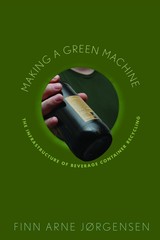 Making a Green Machine: The Infrastructure of Beverage Container Recycling
Jørgensen, Finn Arne
Rutgers University Press, 2011 Consider an empty bottle or can, one of the hundreds of billions of beverage containers that are discarded worldwide every year. Empty containers have been at the center of intense political controversies, technological innovation processes, and the modern environmental movement. Making a Green Machine examines the development of the Scandinavian beverage container deposit-refund system, which has the highest return rates in the world, from 1970 to present. Finn Arne Jørgensen investigates the challenges the system faced when exported internationally and explores the critical role of technological infrastructures and consumer convenience in modern recycling. His comparative framework charts the complex network of business and political actors involved in the development of the reverse vending machine (RVM) and bottle deposit legislation to better understand the different historical trajectories empty beverage containers have taken across markets, including the U.S. The RVM has served as more than a hole in the wall--it began simply as a tool for grocers who had to handle empty refillable glass bottles, but has become a green machine to redeem the empty beverage container, helping both business and consumers participate in environmental actions.
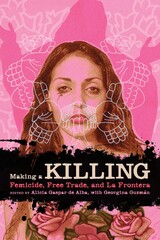 Making a Killing: Femicide, Free Trade, and La Frontera
Edited by Alicia Gaspar de Alba, with Georgina Guzmán
University of Texas Press, 2010 Since 1993, more than five hundred women and girls have been murdered in Ciudad Juárez across the border from El Paso, Texas. At least a third have been sexually violated and mutilated as well. Thousands more have been reported missing and remain unaccounted for. The crimes have been poorly investigated and have gone unpunished and unresolved by Mexican authorities, thus creating an epidemic of misogynist violence on an increasingly globalized U.S.-Mexico border. This book, the first anthology to focus exclusively on the Juárez femicides, as the crimes have come to be known, compiles several different scholarly "interventions" from diverse perspectives, including feminism, Marxism, critical race theory, semiotics, and textual analysis. Editor Alicia Gaspar de Alba shapes a multidisciplinary analytical framework for considering the interconnections between gender, violence, and the U.S.-Mexico border. The essays examine the social and cultural conditions that have led to the heinous victimization of women on the border—from globalization, free trade agreements, exploitative maquiladora working conditions, and border politics, to the sexist attitudes that pervade the social discourse about the victims. The book also explores the evolving social movement that has been created by NGOs, mothers' organizing efforts, and other grassroots forms of activism related to the crimes. Contributors include U.S. and Mexican scholars and activists, as well as personal testimonies of two mothers of femicide victims.
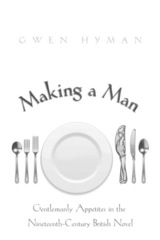 Making a Man: Gentlemanly Appetites in the Nineteenth Century British Novel
Gwen Hyman
Ohio University Press, 2009 Gruel and truffles, wine and gin, opium and cocaine. Making a Man: Gentlemanly Appetites in the Nineteenth-Century British Novel addresses consumption of food, drink, and drugs in the conspicuously consuming nineteenth century in order to explore the question of what, in fact, makes a man in novels of the period. Gwen Hyman analyzes the rituals of dining room, drawing room, opium den, and cocaine lab, and the ways in which these alimentary behaviors make, unmake, and remake the gentlemanly body.
The gentleman, Making a Man argues, is a dangerous alimental force. Threatened with placelessness, he seeks to locate and mark himself through his feasting and fasting. But in doing so, he inevitably threatens to starve, to subsume, to swallow the community around him. The gentleman is at once fundamental and fundamentally threatening to the health of the nation: his alimental monstrousness constitutes the nightmare of the period’s striving, anxious, alimentally fraught middle class.
Making a Man makes use of food history and theory, literary criticism, anthropology, gender theory, economics, and social criticism to read gentlemanly consumers from Mr. Woodhouse, the gruel-eater in Jane Austen’s Emma, through the vampire and the men who hunt him in Bram Stoker’s Dracula. Hyman argues that appetite is a crucial means of casting light on the elusive identity of the gentleman, a figure who is the embodiment of power and yet is hardly embodied in Victorian literature.
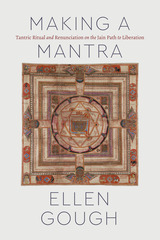 Making a Mantra: Tantric Ritual and Renunciation on the Jain Path to Liberation
Ellen Gough
University of Chicago Press, 2021 Jainism originated in India and shares some features with Buddhism and Hinduism, but it is a distinct tradition with its own key texts, art, rituals, beliefs, and history. One important way it has often been distinguished from Buddhism and Hinduism is through the highly contested category of Tantra: Jainism, unlike the others, does not contain a tantric path to liberation. But in Making a Mantra, historian of religions Ellen Gough refines and challenges our understanding of Tantra by looking at the development over two millennia of a Jain incantation, or mantra, that evolved from an auspicious invocation in a second-century text into a key component of mendicant initiations and meditations that continue to this day.
Typically, Jainism is characterized as a celibate, ascetic path to liberation in which one destroys karma through austerities, while the tantric path to liberation is characterized as embracing the pleasures of the material world, requiring the ritual use of mantras to destroy karma. Gough, however, argues that asceticism and Tantra should not be viewed in opposition to one another. She does so by showing that Jains perform “tantric” rituals of initiation and meditation on mantras and maṇḍalas. Jainism includes kinds of tantric practices, Gough provocatively argues, because tantric practices are a logical extension of the ascetic path to liberation.
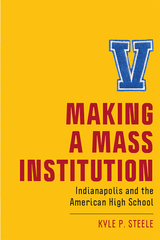 Making a Mass Institution: Indianapolis and the American High School
Kyle P. Steele
Rutgers University Press, 2020 Making a Mass Institution describes how Indianapolis, Indiana created a divided and unjust system of high schools over the course of the twentieth century, one that effectively sorted students geographically, economically, and racially. Like most U.S. cities, Indianapolis began its secondary system with a singular, decidedly academic high school, but ended the 1960s with multiple high schools with numerous paths to graduation. Some of the schools were academic, others vocational, and others still for what was eventually called “life adjustment.” This system mirrored the multiple forces of mass society that surrounded it, as it became more bureaucratic, more focused on identifying and organizing students based on perceived abilities, and more anxious about teaching conformity to middle-class values. By highlighting the experiences of the students themselves and the formation of a distinct, school-centered youth culture, Kyle P. Steele argues that high school, as it evolved into a mass institution, was never fully the domain of policy elites, school boards and administrators, or students, but a complicated and ever-changing contested meeting place of all three.
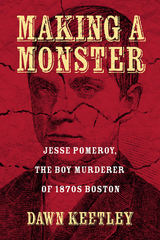 Making a Monster: Jesse Pomeroy, the Boy Murderer of 1870s Boston
Dawn Keetley
University of Massachusetts Press, 2017 When twelve-year-old Jesse Pomeroy tortured seven small boys in the Boston area and then went on to brutally murder two other children, one of the most striking aspects of his case was his inability ever to answer the question of why he did what he did. Whether in court or in the newspapers, many experts tried to explain his horrible acts—and distance the rest of society from them. Despite those efforts, and attempts since, the mystery remains.
In this book, Dawn Keetley details the story of Pomeroy's crimes and the intense public outcry. She explores the two reigning theories at the time—that he was shaped before birth when his pregnant mother visited a slaughterhouse and that he imitated brutal acts found in popular dime novels. Keetley then thoughtfully offers a new theory: that Pomeroy suffered a devastating reaction to a smallpox vaccination which altered his brain, creating a psychopath who revealed the human potential for brutality. The reaction to Pomeroy's acts, then and now, demonstrates the struggle to account for exactly those aspects of human nature that remain beyond our ability to understand.
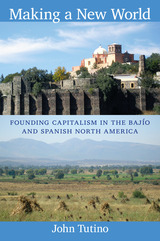 Making a New World: Founding Capitalism in the Bajío and Spanish North America
John Tutino
Duke University Press, 2011 Making a New World is a major rethinking of the role of the Americas in early world trade, the rise of capitalism, and the conflicts that reconfigured global power around 1800. At its center is the Bajío, a fertile basin extending across the modern-day Mexican states of Guanajuato and Querétaro, northwest of Mexico City. The Bajío became part of a new world in the 1530s, when Mesoamerican Otomís and Franciscan friars built Querétaro, a town that quickly thrived on agriculture and trade. Settlement accelerated as regional silver mines began to flourish in the 1550s. Silver tied the Bajío to Europe and China; it stimulated the development of an unprecedented commercial, patriarchal, Catholic society. A frontier extended north across vast expanses settled by people of European, Amerindian, and African ancestry. As mining, cloth making, and irrigated cultivation increased, inequities deepened and religious debates escalated. Analyzing the political economy, social relations, and cultural conflicts that animated the Bajío and Spanish North America from 1500 to 1800, John Tutino depicts an engine of global capitalism and the tensions that would lead to its collapse into revolution in 1810.
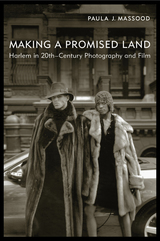 Making a Promised Land: Harlem in Twentieth-Century Photography and Film
Massood, Paula J.
Rutgers University Press, 2013 Making a Promised Land examines the interconnected histories of African American representation, urban life, and citizenship as documented in still and moving images of Harlem over the last century. Paula J. Massood analyzes how photography and film have been used over time to make African American culture visible to itself and to a wider audience and charts the ways in which the “Mecca of the New Negro” became a battleground in the struggle to define American politics, aesthetics, and citizenship. Visual media were first used as tools for uplift and education. With Harlem’s downturn in fortunes through the 1930s, narratives of black urban criminality became common in sociological tracts, photojournalism, and film. These narratives were particularly embodied in the gangster film, which was adapted to include stories of achievement, economic success, and, later in the century, a nostalgic return to the past. Among the films discussed are Fights of Nations (1907), Dark Manhattan (1937), The Cool World (1963), Black Caesar (1974), Malcolm X (1992), and American Gangster (2007). Massood asserts that the history of photography and film in Harlem provides the keys to understanding the neighborhood’s symbolic resonance in African American and American life, especially in light of recent urban redevelopment that has redefined many of its physical and demographic contours.
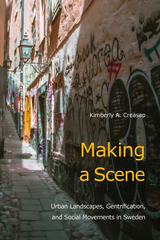 Making a Scene: Urban Landscapes, Gentrification, and Social Movements in Sweden
Kimberly A. Creasap
Temple University Press, 2022 In the three largest cities in Sweden, social movement “scenes”—networks of social movement actors and the places they inhabit—challenge threats such as gentrification. The geography of the built environment influences their ability to lay claim to urban space and to local political processes. In Making a Scene, Kimberly Creasap emphasizes that it is the centrality, concentration, and visibility of these scenes that make them most effective. Whereas some scenes become embedded as part of everyday life—as in Malmö—in contrast, scenes in Göteborg and Stockholm often fail to become part of the fabric of urban neighborhoods. Creasap investigates key spaces for scenes, from abandoned industrial areas and punk clubs to street festivals, bookstores, and social centers, to show how activists create sites and develop structures of resistance that are anti-capitalist, anti-fascist, anti-gentrification, queer, and feminist. She also charts the relationship between scenes and city spaces to show these autonomous social movements create their own cultural landscapes. Making a Scene encourages critical thinking about spatiality and place in the sociology of social movements and the role of social movements as important actors in urban development.
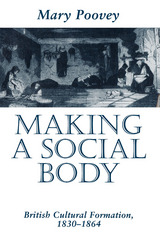 Making a Social Body: British Cultural Formation, 1830-1864
Mary Poovey
University of Chicago Press, 1995 With much recent work in Victorian studies focused on gender and class differences, the homogenizing features of 19th-century culture have received relatively little attention. In Making a Social Body, Mary Poovey examines one of the conditions that made the development of a mass culture in Victorian Britain possible: the representation of the population as an aggregate—a social body. Drawing on both literature and social reform texts, she analyzes the organization of knowledge during this period and explores its role in the emergence of the idea of the social body.
Poovey illuminates the ways literary genres, such as the novel, and innovations in social thought, such as statistical thinking and anatomical realism, helped separate social concerns from the political and economic domains. She then discusses the influence of the social body concept on Victorian ideas about the role of the state, examining writings by James Phillips Kay, Thomas Chalmers, and Edwin Chadwick on regulating the poor. Analyzing the conflict between Kay's idea of the social body and Babbage's image of the social machine, she considers the implications of both models for the place of Victorian women. Poovey's provocative readings of Disraeli's Coningsby, Gaskell's Mary Barton, and Dickens's Our Mutual Friend show that the novel as a genre exposed the role gender played in contemporary discussions of poverty and wealth.
Making a Social Body argues that gender, race, and class should be considered in the context of broader concerns such as how social authority is distributed, how institutions formalize knowledge, and how truth is defined.
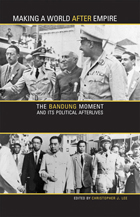 Making a World after Empire: The Bandung Moment and Its Political Afterlives
Christopher J. Lee
Ohio University Press, 2010 In April 1955, twenty-nine countries from Africa, Asia, and the Middle East came together for a diplomatic conference in Bandung, Indonesia, intending to define the direction of the postcolonial world. Representing approximately two-thirds of the world’s population, the Bandung conference occurred during a key moment of transition in the mid-twentieth century—amid the global wave of decolonization that took place after the Second World War and the nascent establishment of a new cold war world order in its wake. Participants such as Jawaharlal Nehru of India, Gamal Abdel Nasser of Egypt, Zhou Enlai of China, and Ahmed Sukarno of Indonesia seized this occasion to attempt the creation of a political alternative to the dual threats of Western neocolonialism and the cold war interventionism of the United States and the Soviet Union. The essays in this volume explore the diverse repercussions of this event, tracing the diplomatic, intellectual, and sociocultural histories that have emanated from it. Making a World after Empire consequently addresses the complex intersection of postcolonial history and cold war history and speaks to contemporary discussions of Afro-Asianism, empire, and decolonization, thus reestablishing the conference’s importance in twentieth-century global history. Contributors: Michael Adas, Laura Bier, James R. Brennan, G. Thomas Burgess, Antoinette Burton, Dipesh Chakrabarty, Julian Go, Christopher J. Lee, Jamie Monson, Jeremy Prestholdt, Denis M. Tull
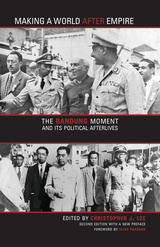 Making a World after Empire: The Bandung Moment and Its Political Afterlives
Christopher J. Lee
Ohio University Press, 2019 With a new foreword by Vijay Prashad In April 1955, twenty-nine countries from Africa, Asia, and the Middle East came together for a diplomatic conference in Bandung, Indonesia, intending to define the direction of the postcolonial world. Ostensibly representing two-thirds of the world’s population, the Bandung conference occurred during a key moment of transition in the mid-twentieth century—amid the global wave of decolonization that took place after the Second World War and the nascent establishment of a new Cold War world order in its wake. Participants such as Jawaharlal Nehru of India, Gamal Abdel Nasser of Egypt, Zhou Enlai of China, and Sukarno of Indonesia seized this occasion to attempt the creation of a political alternative to the dual threats of Western neocolonialism and the Cold War interventionism of the United States and the Soviet Union. The essays collected here explore the diverse repercussions of this event, tracing diplomatic, intellectual, and sociocultural histories that ensued as well as addressing the broader intersection of postcolonial and Cold War history. With a new foreword by Vijay Prashad and a new preface by the editor, Making a World after Empire speaks to contemporary discussions of decolonization, Third Worldism, and the emergence of the Global South, thus reestablishing the conference’s importance in twentieth-century global history. Contributors: Michael Adas, Laura Bier, James R. Brennan, G. Thomas Burgess, Antoinette Burton, Dipesh Chakrabarty, Julian Go, Christopher J. Lee, Jamie Monson, Jeremy Prestholdt, and Denis M. Tull.
Making Academic Presentations: What Every University Student Needs to Know
Robyn Brinks Lockwood
University of Michigan Press, 2023 The ability to give a successful presentation in an academic setting is critical to success both on and off campus. Making Academic Presentations describes the five moves, or parts, of a typical presentation and provides examples of language that can be used to successfully accomplish these moves. Although language is vital to giving a good presentation, the book also addresses other factors that influence the success of a presentation, such as overcoming nervousness, nonverbal communication, and pronunciation and paralinguistics.
The book includes a variety of tasks that will help students practice developing and analyzing presentations as well as practice projects for applying these lessons. In addition, rubrics and evaluation forms are included for instructors to adapt and use for evaluation purposes.
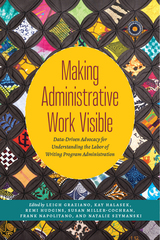 Making Administrative Work Visible: Data-Driven Advocacy for Understanding the Labor of Writing Program Administration
Leigh Graziano
Utah State University Press, 2023 Making Administrative Work Visible brings together voices from graduate students, associated faculty, administrative staff, and tenured and tenure-track faculty at community colleges, regional state universities, liberal arts colleges, private colleges, and research-intensive institutions across the country to speak to the challenges, both named and unnamed, faced by those who do writing program administration work. These authors call explicit attention to this work and examine WPAs’ lived labor experiences and research methodologies to truly understand the scope of lived WPA labor.
The collection has three parts, each of which focuses on the most confounding challenges facing WPAs as well as the most compelling sites of their contributions to administration, labor in higher education, and the discipline’s collective obligation to forwarding the goals of social justice and advocacy: Advocating through Representations of WPA Labor, Advocating by Accounting for Time and Labor, and Advocating in and through Complex Institutional Contexts. The chapters use data to share and track the work functions, job titles, grand narratives, program assessments, tenure and promotion, email practices, and more undertaken by WPAs in their administrative capacities. Chapters also surface narratives for future data and studies to be done by other scholars.
By taking up and answering questions about the range of WPA work—and the invisibility of much of that work—Making Administrative Work Visible creates avenues toward accounting for and acknowledging the complex activity systems in which WPAs lead the work of the university and advocate for data-driven strategies needed to sustain this foundational area of higher education.
Contributors: Kamila Albert, Brooke Anderson, Sheila Carter-Tod, Amy Cicchino, Ana Cortés Lagos, Kristi Murray Costello, Jennifer Cunningham, Ryan Dippre, Kimberly Emmons, Genevieve García de Müeller, Jill Gladstein, Caleb González, Michael Healy, Lyra Hilliard, Kristine Johnson, Seth Kahn, Rita Malenczyk, Troy Mikanovich, Lilian Mina, Angela Mitchell, Greer Murphy, Kate Navickas, Michael Neal, Patti Poblete, Jan Rieman, Heather Robinson, Katelyn Stark, Mary Stewart, Natalie Stillman-Webb, Lizbett Tinoco, Lisa Tremain, Martha Wilson Schaffer
Making American Boys: Boyology and the Feral Tale
Kenneth B. Kidd
University of Minnesota Press, 2005 Will boys be boys? What are little boys made of? Kenneth B. Kidd responds to these familiar questions with a thorough review of boy culture in America since the late nineteenth century. From the "boy work" promoted by character-building organizations such as Scouting and 4-H to current therapeutic and pop psychological obsessions with children's self-esteem, Kidd presents the great variety of cultural influences on the changing notion of boyhood. Analyzing icons of boyhood and maleness from Huck Finn and The Jungle Book's Mowgli to Father Flanagan's Boys Town and even Michael Jackson, Kidd surveys films, psychoanalytic case studies, parenting manuals, historical accounts of the discoveries of "wolf-boys," and self-help books to provide a rigorous history of what it has meant to be an all-American boy.
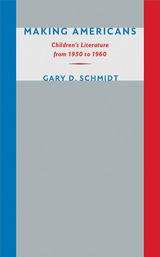 Making Americans: Children's Literature from 1930 to 1960
Gary D. Schmidt
University of Iowa Press, 2013 American children need books that draw on their own history and circumstances, not just the classic European fairy tales. They need books that enlist them in the great democratic experiment that is the United States. These were the beliefs of many of the authors, illustrators, editors, librarians, and teachers who expanded and transformed children’s book publishing between the 1930s and the 1960s.
Although some later critics have argued that the books published in this era offered a vision of a safe, secure, simple world without injustice or unhappy endings, Gary D. Schmidt shows that the progressive political agenda shared by many Americans who wrote, illustrated, published, and taught children’s books had a powerful effect. Authors like James Daugherty, Laura Ingalls Wilder, Lois Lenski, Ingri and Edgar Parin D’Aulaire, Virginia Lee Burton, Robert McCloskey, and many others addressed directly and indirectly the major social issues of a turbulent time: racism, immigration and assimilation, sexism, poverty, the Great Depression, World War II, the atomic bomb, and the threat of a global cold war.
The central concern that many children’s book authors and illustrators wrestled with was the meaning of America and democracy itself, especially the tension between individual freedoms and community ties. That process produced a flood of books focused on the American experience and intent on defining it in terms of progress toward inclusivity and social justice. Again and again, children’s books addressed racial discrimination and segregation, gender roles, class differences, the fate of Native Americans, immigration and assimilation, war, and the role of the United States in the world. Fiction and nonfiction for children urged them to see these issues as theirs to understand, and in some ways, theirs to resolve. Making Americans is a study of a time when the authors and illustrators of children’s books consciously set their eyes on national and international sights, with the hope of bringing the next generation into a sense of full citizenship.
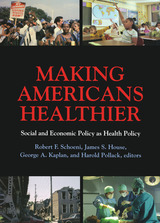 Making Americans Healthier: Social and Economic Policy as Health Policy
Robert F. Schoeni
Russell Sage Foundation, 2008 The United States spends billions of dollars annually on social and economic policies aimed at improving the lives of its citizens, but the health consequences associated with these policies are rarely considered. In Making Americans Healthier, a group of multidisciplinary experts shows how social and economic policies seemingly unrelated to medical well-being have dramatic consequences for the health of the American people. Most previous research concerning problems with health and healthcare in the United States has focused narrowly on issues of medical care and insurance coverage, but Making Americans Healthier demonstrates the important health consequences that policymakers overlook in traditional cost-benefit evaluations of social policy. The contributors examine six critical policy areas: civil rights, education, income support, employment, welfare, and neighborhood and housing. Among the important findings in this book, David Cutler and Adriana Lleras-Muney document the robust relationship between educational attainment and health, and estimate that the health benefits of education may exceed even the well-documented financial returns of education. Pamela Herd, James House, and Robert Schoeni discover notable health benefits associated with the Supplemental Security Income Program, which provides financial support for elderly and disabled Americans. George Kaplan, Nalini Ranjit, and Sarah Burgard document a large and unanticipated improvement in the health of African-American women following the enactment of civil rights legislation in the 1960s. Making Americans Healthier presents ground-breaking evidence that the health impact of many social policies is substantial. The important findings in this book pave the way for promising new avenues for intervention and convincingly demonstrate that ultimately social and economic policy is health policy. A Volume in the National Poverty Center Series on Poverty and Public Policy
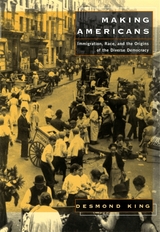 Making Americans: Immigration, Race, and the Origins of the Diverse Democracy
Desmond King
Harvard University Press, 2002 In the nineteenth century, virtually anyone could get into the United States. But by the 1920s, U.S. immigration policy had become a finely filtered regime of selection. Desmond King looks at this dramatic shift, and the debates behind it, for what they reveal about the construction of an "American" identity.
Specifically, the debates in the three decades leading up to 1929 were conceived in terms of desirable versus undesirable immigrants. This not only cemented judgments about specific European groups but reinforced prevailing biases against groups already present in the United States, particularly African Americans, whose inferior status and second-class citizenship--enshrined in Jim Crow laws and embedded in pseudo-scientific arguments about racial classifications--appear to have been consolidated in these decades. Although the values of different groups have always been recognized in the United States, King gives the most thorough account yet of how eugenic arguments were used to establish barriers and to favor an Anglo-Saxon conception of American identity, rejecting claims of other traditions. Thus the immigration controversy emerges here as a significant precursor to recent multicultural debates.
Making Americans shows how the choices made about immigration policy in the 1920s played a fundamental role in shaping democracy and ideas about group rights in America.
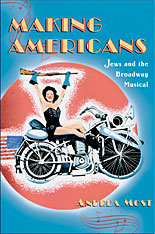 Making Americans: Jews and the Broadway Musical
Andrea Most
Harvard University Press, 2004 From 1925 to 1951--three chaotic decades of depression, war, and social upheaval--Jewish writers brought to the musical stage a powerfully appealing vision of America fashioned through song and dance. It was an optimistic, meritocratic, selectively inclusive America in which Jews could at once lose and find themselves--assimilation enacted onstage and off, as Andrea Most shows. This book examines two interwoven narratives crucial to an understanding of twentieth-century American culture: the stories of Jewish acculturation and of the development of the American musical.
Here we delve into the work of the most influential artists of the genre during the years surrounding World War II--Irving Berlin, Eddie Cantor, Dorothy and Herbert Fields, George and Ira Gershwin, Oscar Hammerstein, Lorenz Hart, and Richard Rodgers--and encounter new interpretations of classics such as The Jazz Singer, Whoopee, Girl Crazy, Babes in Arms, Oklahoma!, Annie Get Your Gun, South Pacific, and The King and I. Most's analysis reveals how these brilliant composers, librettists, and performers transformed the experience of New York Jews into the grand, even sacred acts of being American. Read in the context of memoirs, correspondence, production designs, photographs, and newspaper clippings, the Broadway musical clearly emerges as a form by which Jewish artists negotiated their entrance into secular American society. In this book we see how the communities these musicals invented and the anthems they popularized constructed a vision of America that fostered self-understanding as the nation became a global power.
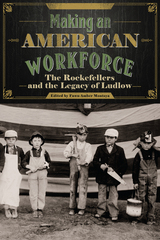 Making an American Workforce: The Rockefellers and the Legacy of Ludlow
Fawn-Amber Montoya
University Press of Colorado, 2014 Taking an interdisciplinary approach to the policies of the early years of the Colorado Fuel and Iron Company, Making an American Workforce explores John D. Rockefeller Jr.'s welfare capitalist programs and their effects on the company's diverse workforce. Focusing on the workers themselves—men, women, and children representative of a variety of immigrant and ethnic groups—contributors trace the emergence of the Employee Representation Plan, the work of the company's Sociology Department, and CF&I's interactions with the YMCA in the early twentieth century. They examine CF&I's early commitment to Americanize its immigrant employees and shape worker behavior, the development of policies that constructed the workforce it envisioned while simultaneously laying the groundwork for the strike that eventually led to the Ludlow Massacre, and the impact of the massacre on the employees, the company, and beyond. Making an American Workforce provides greater insight into the repercussions of the Industrial Representation Plan and the Ludlow Massacre, revealing the long-term consequences of Colorado Fuel and Iron Company policies on the American worker, the state of Colorado, and the creation of corporate culture. Making an American Workforce will be of interest to Western, labor, and business historians.
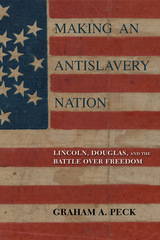 Making an Antislavery Nation: Lincoln, Douglas, and the Battle over Freedom
Graham A. Peck
University of Illinois Press, 2020 Winner of the Russell P. Strange Memorial Book Award This sweeping narrative presents an original and compelling explanation for the triumph of the antislavery movement in the United States prior to the Civil War. Abraham Lincoln's election as the first antislavery president was hardly preordained. From the country's inception, Americans had struggled to define slavery's relationship to freedom. Most Northerners supported abolition in the North but condoned slavery in the South, while most Southerners denounced abolition and asserted slavery's compatibility with whites' freedom. On this massive political fault line hinged the fate of the nation. Graham A. Peck meticulously traces the conflict over slavery in Illinois from the Northwest Ordinance in 1787 to Lincoln's defeat of his archrival Stephen A. Douglas in the 1860 election. Douglas's attempt in 1854 to persuade Northerners that slavery and freedom had equal national standing stirred a political earthquake that brought Lincoln to the White House. Yet Lincoln's framing of the antislavery movement as a conservative return to the country's founding principles masked what was in fact a radical and unprecedented antislavery nationalism. It justified slavery's destruction but triggered the Civil War. Presenting pathbreaking interpretations of Lincoln, Douglas, and the Civil War's origins, Making an Antislavery Nation shows how battles over slavery paved the way for freedom's triumph in America.
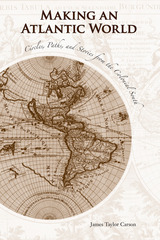 Making an Atlantic World: Circles, Paths, and Stories from the Colonial South
James Taylor Carson
University of Tennessee Press, 2007 In the South, colonialism threw together three peoples who each played important roles in the creation of a new kind of society. Making an Atlantic World explores how Native Americans, Africans, and Europeans understood the landscapes they inhabited and how, after contact, their views of the world had to accommodate and then accept the presence of the others.
Based on the notion of “founding peoples” rather than “founding fathers,” Making an Atlantic World uses an innovative, interdisciplinary approach to interpret the Colonial South. James Taylor Carson uses historical ethnogeography—a new methodology that brings together the study of history, anthropology, and geography. This method seeks to incorporate concepts of space and landscape with social perspectives to give students and scholars a better understanding of the forces that shaped the development of a synthesized southern culture.
Unlike previous studies, which considered colonization as a contest over land but rarely considered what the land was and how people understood their relationships to it, Making an Atlantic World shows how the founding peoples perceived their world before contact and how they responded to contact and colonization.
The author contends that each of the three groups involved—the first people, the invading people, and the enslaved people—possessed a particular worldview that they had to adapt to each other to face the challenges brought about by contact.
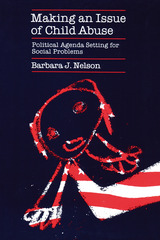 Making an Issue of Child Abuse: Political Agenda Setting for Social Problems
Barbara J. Nelson
University of Chicago Press, 1986 In this absorbing story of how child abuse grew from a small, private-sector charity concern into a multimillion-dollar social welfare issue, Barbara Nelson provides important new perspectives on the process of public agenda setting. Using extensive personal interviews and detailed archival research, she reconstructs an invaluable history of child abuse policy in America. She shows how the mass media presented child abuse to the public, how government agencies acted and interacted, and how state and national legislatures were spurred to strong action on this issue. Nelson examines prevailing theories about agenda setting and introduces a new conceptual framework for understanding how a social issue becomes part of the public agenda. This issue of child abuse, she argues, clearly reveals the scope and limitations of social change initiated through interest-group politics. Unfortunately, the process that transforms an issue into a popular cause, Nelson concludes, brings about programs that ultimately address only the symptoms and not the roots of such social problems.
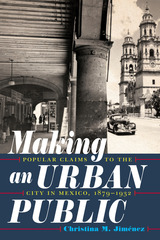 Making an Urban Public: Popular Claims to the City in Mexico, 1879-1932
Christina Jiminez
University of Pittsburgh Press, 2019 Winner, 2019 CHOICE Awards Outstanding Academic Title
Written as a social history of urbanization and popular politics, this book reinserts “the public” and “the city” into current debates about citizenship, urban development, state regulation, and modernity in the turn of the century Mexico. Rooted in thousands of pages of written correspondence between city residents and local authorities, mostly with the city council of Morelia, the rhetoric and arguments of resident and city council dialogues often highlighted a person’s or group’s contributions to the public good, effectively positioning petitioners as deserving and contributing members of the urban public. Making an Urban Publictells the story of how Morelia’s residents—particular those from popular groups and poor circumstances—claimed (and often gained) Making basic rights to the city, including the right to both participate in and benefit from the city’s public spaces; its consumer and popular cultures; its modernized infrastructure and services; its rhetorical promises around good government and effective policing; its dense networks of community; and its countless opportunities for negotiating to forward one’s agenda, and its urban promise for a better life.
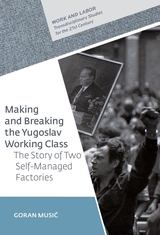 Making and Breaking the Yugoslav Working Class: The Story of Two Self-Managed Factories
Goran Music
Central European University Press, 2021 Workers' self-management was one of the unique features of communist Yugoslavia. Goran Musić has investigated the changing ways in which blue-collar workers perceived the recurring crises of the regime. Two self-managed metal enterprises, one in Serbia another in Slovenia, provide the frame of the analysis in the time span between 1945 and 1989. These two factories became famous for strikes in 1988 that evoked echoes in popular discourses in former Yugoslavia. Drawing on interviews, factory publications and other media, local archives, and secondary literature, Musić analyzes the two cases, going beyond the clichés of political manipulation from the top and workers' intrinsic attraction to nationalism.
The author explains how, in the later phase of communist Yugoslavia, growing social inequalities among the workers and undemocratic practices inside the self-managed enterprises facilitated the spread of a nationalist and pro-market ideology on the shop floors. Yet rather than being a mass taken advantage of by populist leaders, the working class Musić presents is one with agency and voice, a force that played an important role in shaping the fate of the country. The book thus seeks to open a debate on the social processes leading up to the dissolution of Yugoslavia.
Making and Effacing Art: Modern American Art in a Culture of Museums
Philip Fisher
Harvard University Press Philip Fisher charts the pivotal role the museum has played in modern culture, revealing why it has become central to industrial society and how, in turn, artists have adapted to the museum's growing power, shaping their works with the museum in mind. He explores how, over the last two centuries, museums have presented art objects outside their original context, effacing them, in order to represent them in a sequential ordering of styles. It is this sequence that artists such as Jasper Johns and Frank Stella have mirrored, even parodied. This book is an important contribution to our understanding of modern art and culture.
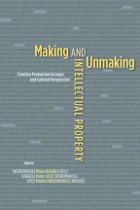 Making and Unmaking Intellectual Property: Creative Production in Legal and Cultural Perspective
Edited by Mario Biagioli, Peter Jaszi, and Martha Woodmansee
University of Chicago Press, 2011 Rules regulating access to knowledge are no longer the exclusive province of lawyers and policymakers and instead command the attention of anthropologists, economists, literary theorists, political scientists, artists, historians, and cultural critics. This burgeoning interdisciplinary interest in “intellectual property” has also expanded beyond the conventional categories of patent, copyright, and trademark to encompass a diverse array of topics ranging from traditional knowledge to international trade. Though recognition of the central role played by “knowledge economies” has increased, there is a special urgency associated with present-day inquiries into where rights to information come from, how they are justified, and the ways in which they are deployed. Making and Unmaking Intellectual Property, edited by Mario Biagioli, Peter Jaszi, and Martha Woodmansee, presents a range of diverse—and even conflicting—contemporary perspectives on intellectual property rights and the contested sources of authority associated with them. Examining fundamental concepts and challenging conventional narratives—including those centered around authorship, invention, and the public domain—this book provides a rich introduction to an important intersection of law, culture, and material production.
 Making and Unmaking Literature in the Warsaw, Lodz, and Vilna Ghettos
Sven-Erik Rose
Brandeis University Press, 2025 A study of literature written by Jewish authors while interned in Nazi ghettos emphasizes how authors processed their horrific experiences through poetry and prose. Published in Association with the United States Holocaust Memorial Museum
This is the first study devoted to how little known but essential authors grappled with the destitution of ghetto existence by writing within, at the limits of, and against an array of literary scenarios, tropes, plot lines, and generic conventions, including those of nature lyric, modernist interior monologue, the realist social novel, the detective story, and the gothic horror tale. Contending with starvation, disease, desperate housing conditions and the looming threat of being murdered, inhabitants of ghettos in Poland nonetheless made them sites of rich Jewish cultural production. Rose’s readings of these literary works reveal how authors asserted their humanity by insisting on writing works of literature. In such radically dehumanizing circumstances, however, their recourse to established literary genres was not naive. Rather, ghetto authors brilliantly meditated on the grotesque incongruities between established literary models and the extreme conditions of ghetto existence.
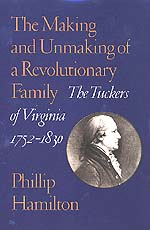 The Making and Unmaking of a Revolutionary Family: The Tuckers of Virginia, 1752-1830
Phillip Hamilton
University of Virginia Press, 2003 "The Making and Unmaking of a Revolutionary Family is an interesting and carefully crafted study of the family dynamics of the Tuckers in the Revolutionary and post-Revolutionary generations. Phillip Hamilton's questions about how families respond and shape new strategies for maintaining their economic power and social position are vitally important in any consideration of post-Revolutionary Virginia."
--Herbert E. Sloan, Barnard College, author of Principle and Interest: Thomas Jefferson and the Problem of Debt
In mid-April 1814, the Virginia congressman John Randolph of Roanoke had reason to brood over his family's decline since the American Revolution. The once-sumptuous world of the Virginia gentry was vanishing, its kinship ties crumbling along with its mansions, crushed by democratic leveling at home and a strong federal government in Washington, D.C. Looking back in an effort to grasp the changes around him, Randolph fixated on his stepfather and onetime guardian, St. George Tucker.
The son of a wealthy Bermuda merchant, Tucker had studied law at the College of William and Mary, married well, and smuggled weapons and fought in the Virginia militia during the Revolution. Quickly grasping the significant changes--political democratization, market change, and westward expansion--that the War for Independence had brought, changes that undermined the power of the gentry, Tucker took the atypical step of selling his plantations and urging his children to pursue careers in learned professions such as law. Tucker's stepson John Randolph bitterly disagreed, precipitating a painful break between the two men that illuminates the transformations that swept Virginia in the late eighteenth and early nineteenth centuries.
Drawing upon an extraordinary archive of private letters, journals, and other manuscript materials, Phillip Hamilton illustrates how two generations of a colorful and influential family adapted to social upheaval. He finds that the Tuckers eventually rejected wider family connections and turned instead to nuclear kin. They also abandoned the liberal principles and enlightened rationalism of the Revolution for a romanticism girded by deep social conservatism. The Making and Unmaking of a Revolutionary Family reveals the complex process by which the world of Washington and Jefferson evolved into the antebellum society of Edmund Ruffin and Thomas Dew.
--------------------------------------------------------------------------------
Phillip Hamilton is Associate Professor of History at Christopher Newport University.
 The Making and Unmaking of the English Catholic Intellectual Community, 1910-1950
James R. Lothian
University of Notre Dame Press, 2009
In The Making and Unmaking of the English Catholic Intellectual Community, 1910–1950, James R. Lothian examines the engagement of interwar Catholic writers and artists both with modernity in general and with the political and economic upheavals of the times in England and continental Europe. The book describes a close-knit community of Catholic intellectuals that coalesced in the aftermath of the Great War and was inspired by Hilaire Belloc's ideology. Among the more than two dozen figures considered in this volume are G. K. Chesterton, novelist Evelyn Waugh, poet and painter David Jones, sculptor Eric Gill, historian Christopher Dawson, and publishers Frank Sheed and Maisie Ward. For Catholic intellectuals who embraced Bellocianism, the response to contemporary politics was a potent combination of hostility toward parliamentary democracy, capitalism, and so-called “Protestant” Whig history. Belloc and his friends asserted a set of political, economic, and historiographical alternatives—favoring monarchy and Distributism, a social and economic system modeled on what Belloc took to be the ideals of medieval feudalism.
Lothian explores the community's development in the 1920s and 1930s, and its dissolution in the 1940s, in the aftermath of World War II. Frank Sheed and Maisie Ward, joined by Tom Burns and Christopher Dawson, promoted an aesthetic and philosophical vision very much at odds with Belloc’s political one. Weakened by internal disagreement, the community became fragmented and finally dissolved.
“James Lothian has presented in a coherent and even-handed way a vivid picture of the most important English Catholic thinkers of the twentieth century. He also deals perceptively with their excesses and defects. Hilaire Belloc is the dominant and shaping figure in this study but others play major roles, such as G. K. Chesterton, Eric Gill, and Evelyn Waugh. These intriguing figures raise questions about modern capitalism, add considerably to our understanding of modern Britain, and bring to mind as well queries about our present economic discontents.” —Peter Stansky, Stanford University
“This wide-ranging study of the flourishing English Catholic community in the first part of the twentieth century is an impressive and substantial contribution to scholarship. Lothian writes with clarity and vigor.” —Ian Ker, University of Oxford
“An astounding number of English intellectuals embraced Catholicism in the first half of the twentieth century. But they did not all share the same understanding of politics or the social order. Lothian's perceptive analysis of the important groups of thinkers and the trends within their thought sheds much light on their quarrels as well as their common sympathies, with special emphasis on the thought of Belloc, Chesterton, and Dawson. By providing such a careful account of the historical situation, it becomes far more clear why the giants of that generation took the stands they did on the important questions of the day.” —Fr. Joseph Koterski, S.J., Fordham University
“Lothian claims that Chesterton and especially Belloc created the underpinnings of a community of thinkers and writers that shaped the Catholic cultural environment of England in the years after the Great War. Their influence, however, was not only confined to Catholicism, as Lothian shows how this religious cohort also had an impact on the broader national community. This book fills a significant gap in the history of English Catholicism.” —Jay P. Corrin, Boston University
 The Making and Unmaking of the Haya Lived World: Consumption, Commoditization, and Everyday Practice
Brad Weiss
Duke University Press, 1996 At the center of this subtle ethnographic account of the Haya communities of Northwest Tanzania is the idea of a lived world as both the product and the producer of everyday practices. Drawing on his experience living with the Haya, Brad Weiss explores Haya ways of constructing and inhabiting their community, and examines the forces that shape and transform these practices over time. In particular, he shows how the Haya, a group at the fringe of the global economy, have responded to the processes and material aspects of money, markets, and commodities as they make and remake their place in a changing world.
Grounded in a richly detailed ethnography of Haya practice, Weiss’s analysis considers the symbolic qualities and values embedded in goods and transactions across a wide range of cultural activity: agricultural practice and food preparation, the body’s experience of epidemic disease from AIDS to the infant affliction of “plastic teeth,” and long-standing forms of social movement and migration. Weiss emphasizes how Haya images of consumption describe the relationship between their local community and the global economy. Throughout, he demonstrates that particular commodities and more general market processes are always material and meaningful forces with the potential for creativity as well as disruption in Haya social life. By calling attention to the productive dimensions of this spatial and temporal world, his work highlights the importance of human agency in not only the Haya but any sociocultural order.
Offering a significant contribution to the anthropological theories of practice, embodiment, and agency, and enriching our understanding of the lives of a rural African people, The Making and Unmaking of the Haya Lived World will interest historians, anthropologists, ethnographers, and scholars of cultural studies.
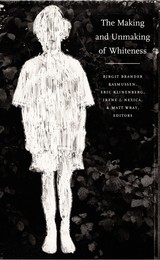 The Making and Unmaking of Whiteness
Birgit Brander Rasmussen, Eric Klinenberg, Irene J. Nexica, and Matt Wray, eds.
Duke University Press, 2001 Bringing together new articles and essays from the controversial Berkeley conference of the same name, The Making and Unmaking of Whiteness presents a fascinating range of inquiry into the nature of whiteness. Representing academics, independent scholars, community organizers, and antiracist activists, the contributors are all leaders in the “second wave” of whiteness studies who collectively aim to combat the historical legacies of white supremacy and to inform those who seek to understand the changing nature of white identity, both in the United States and abroad. With essays devoted to theories of racial domination, comparative global racisms, and transnational white identity, the geographical reach of the volume is significant and broad. Dalton Conley writes on “How I Learned to Be White.” Allan Bérubé discusses the intersection of gay identity and whiteness, and Mab Segrest describes the spiritual price white people pay for living in a system of white supremacy. Other pieces examine the utility of whiteness as a critical term for social analysis and contextualize different attempts at antiracist activism. In a razor-sharp introduction, the editors not only raise provocative questions about the intellectual, social, and political goals of those interested in the study of whiteness but assess several of the topic’s major recurrent themes: the visibility of whiteness (or the lack thereof); the “emptiness” of whiteness as a category of identification; and conceptions of whiteness as a structural privilege, a harbinger of violence, or an institutionalization of European imperialism. Contributors. William Aal, Allan Bérubé, Birgit Brander Rasmussen, Dalton Conley, Troy Duster, Ruth Frankenberg, John Hartigan Jr., Eric Klinenberg, Eric Lott, Irene J. Nexica, Michael Omi, Jasbir Kaur Puar, Mab Segrest, Vron Ware, Howard Winant, Matt Wray
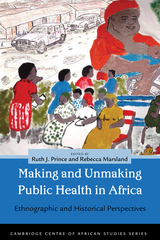 Making and Unmaking Public Health in Africa: Ethnographic and Historical Perspectives
Ruth J. Prince
Ohio University Press, 2013 “This volume contributes significantly to the rapidly developing scholarship of public health and global health in African contexts, considered either as a collection of excellent chapters or taken as the sum of its parts…” —Social History of Medicine
This volume explores how medical professionals and patients, government officials, and ordinary citizens approach questions of public health as they navigate contemporary landscapes of NGOs and transnational projects, faltering state services, and expanding privatization. Its contributors analyze the relations between the public and the private providers of public health, from the state to new global biopolitical formations of political institutions, markets, human populations, and health. Tensions and ambiguities animate these complex relationships, suggesting that the question of what public health actually is in Africa cannot be taken for granted. Offering historical and ethnographic analyses, the volume develops an anthropology of public health in Africa. Contributors: P. Wenzel Geissler; Murray Last; Rebecca Marsland; Lotte Meinert; Benson A. Mulemi; Ruth J. Prince; and Noemi Tousignant.
Making Animal Meaning
Linda Kalof
Michigan State University Press, 2012 An elucidating collection of ten original essays, Making Animal Meaning reconceptualizes methods for researching animal histories and rethinks the contingency of the human-animal relationship. The vibrant and diverse field of animal studies is detailed in these interdisciplinary discussions, which include voices from a broad range of scholars and have an extensive chronological and geographical reach. These exciting discourses capture the most compelling theoretical underpinnings of animal significance while exploring meaning-making through the study of specific spaces, species, and human-animal relations. A deeply thoughtful collection — vital to understanding central questions of agency, kinship, and animal consumption — these essays tackle the history and philosophy of constructing animal meaning.
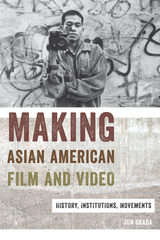 Making Asian American Film and Video: History, Institutions, Movements
Okada, Jun
Rutgers University Press, 2015 The words “Asian American film” might evoke a painfully earnest, low-budget documentary or family drama, destined to be seen only in small film festivals or on PBS (Public Broadcasting Service). In her groundbreaking study of the past fifty years of Asian American film and video, Jun Okada demonstrates that although this stereotype is not entirely unfounded, a remarkably diverse range of Asian American filmmaking has emerged. Yet Okada also reveals how the legacy of institutional funding and the “PBS style” unites these filmmakers, whether they are working within that system or setting themselves in opposition to its conventions.
Making Asian American Film and Video explores how the genre has served as a flashpoint for debates about what constitutes Asian American identity. Tracing a history of how Asian American film was initially conceived as a form of public-interest media, part of a broader effort to give voice to underrepresented American minorities, Okada shows why this seemingly well-intentioned project inspired deeply ambivalent responses. In addition, she considers a number of Asian American filmmakers who have opted out of producing state-funded films, from Wayne Wang to Gregg Araki to Justin Lin.
Okada gives us a unique behind-the-scenes look at the various institutions that have bankrolled and distributed Asian American films, revealing the dynamic interplay between commercial and state-run media. More than just a history of Asian Americans in film, Making Asian American Film and Video is an insightful meditation on both the achievements and the limitations of institutionalized multiculturalism.
 Making Babies: The Science of Pregnancy
David Bainbridge
Harvard University Press, 2001 Drawing on past speculation and present knowledge, reproductive biologist David Bainbridge conducts us through the forty weeks of a human pregnancy, from conception to breastfeeding, explaining the complex biology behind human gestation in a clear and unassuming manner.
Making Babies sets the latest findings in pregnancy biology in a challenging evolutionary, historical, and sociological context, proving that when it comes to drama, pregnancy has it all: sibling rivalry, a battle of the sexes, and a crisis of gender identity. Along the way, Bainbridge revisits some of the key puzzles about pregnancy: What's sex got to do with it? How does the fetus hijack its mother's immune system? What is the point, if any, of morning sickness? Just how does a fertilized ovum develop into eight pounds or so of baby, with ten fingers and ten toes? Does the baby or the mother control the onset of labor, and why is it such an ordeal for them both?
Entertaining and informative, Making Babies shows how the study of human pregnancy can help us understand our genesis as individuals and our evolution as a species, and provide insight into who we are and why we behave as we do.
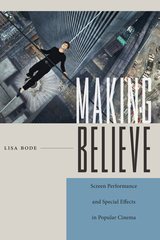 Making Believe: Screen Performance and Special Effects in Popular Cinema
Bode, Lisa
Rutgers University Press, 2017 In the past twenty years, we have seen the rise of digital effects cinema in which the human performer is entangled with animation, collaged with other performers, or inserted into perilous or fantastic situations and scenery. Making Believe sheds new light on these developments by historicizing screen performance within the context of visual and special effects cinema and technological change in Hollywood filmmaking, through the silent, early sound, and current digital eras.
Making Believe incorporates North American film reviews and editorials, actor and crew interviews, trade and fan magazine commentary, actor training manuals, and film production publicity materials to discuss the shifts in screen acting practice and philosophy around transfiguring makeup, doubles, motion capture, and acting to absent places or characters. Along the way it considers how performers and visual and special effects crew work together, and struggle with the industry, critics, and each other to define the aesthetic value of their work, in an industrial system of technological reproduction. Bode opens our eyes to the performing illusions we love and the tensions we experience in wanting to believe in spite of our knowledge that it is all make believe in the end.
 Making Black Scientists: A Call to Action
Marybeth Gasman and Thai-Huy Nguyen
Harvard University Press, 2019 Americans have access to some of the best science education in the world, but too often black students are excluded from these opportunities. This essential book by leading voices in the field of education reform offers an inspiring vision of how America’s universities can guide a new generation of African Americans to success in science.
Educators, research scientists, and college administrators have all called for a new commitment to diversity in the sciences, but most universities struggle to truly support black students in these fields. Historically black colleges and universities (HBCUs) are different, though. Marybeth Gasman, widely celebrated as an education-reform visionary, and Thai-Huy Nguyen show that many HBCUs have proven adept at helping their students achieve in the sciences. There is a lot we can learn from these exemplary schools.
Gasman and Nguyen explore ten innovative schools that have increased the number of black students studying science and improved those students’ performance. Educators on these campuses have a keen sense of their students’ backgrounds and circumstances, familiarity that helps their science departments avoid the high rates of attrition that plague departments elsewhere. The most effective science programs at HBCUs emphasize teaching when considering whom to hire and promote, encourage students to collaborate rather than compete, and offer more opportunities for black students to find role models among both professors and peers.
Making Black Scientists reveals the secrets to these institutions’ striking successes and shows how other colleges and universities can follow their lead. The result is a bold new agenda for institutions that want to better serve African American students.
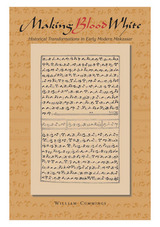 Making Blood White: Historical Transformations in Early Modern Makassar
William Cummings
University of Hawaii Press, 2002 In this study of early modern Makassar in the sixteenth and seventeenth centuries, William Cummings traces the social, cultural, and political significance of the transition from oral to literate culture in one region of Indonesia. He examines "history-making"--the ways in which the past is perceived, interpreted, and used--at a crucial moment in early modern Makassar when conceptions of history are being transformed by the advent of literacy. Central to his argument is the notion that histories are not just records or representations of the past but are themselves forces or agents capable of transforming the worlds in which humans live. Not simply structured by the prevailing social, cultural, and ideological contexts in which they are made, they also shape these contexts.
Making Blood White bears in important ways on the historiography of Southeast Asia in general and will be read by students of the region's history and anthropology as well as by those interested in the relationships of history, literacy, and politics in premodern Asia.
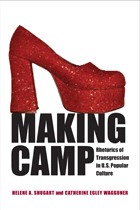 Making Camp: Rhetorics of Transgression in U.S. Popular Culture
Helene A. Shugart and Catherine Egley Waggoner
University of Alabama Press, 2008 The rhetorical power of camp in American popular culture
Making Camp examines the rhetoric and conventions of “camp” in contemporary popular culture and the ways it both subverts and is co-opted by mainstream ideology and discourse, especially as it pertains to issues of gender and sexuality. Camp has long been aligned with gay male culture and performance. Helene Shugart and Catherine Waggoner contend that camp in the popular media—whether visual, dramatic, or musical—is equally pervasive. While aesthetic and performative in nature, the authors argue that camp—female camp in particular—is also highly political and that conventions of femininity and female sexuality are negotiated, if not always resisted, in female camp performances. The authors draw on a wide range of references and figures representative of camp, both historical and contemporary, in presenting the evolution of female camp and its negotiation of gender, political, and identity issues. Antecedents such as Joan Crawford, Wonder Woman, Marilyn Monroe, and Pam Grier are discussed as archetypes for contemporary popular culture figures—Macy Gray, Gwen Stefani, and the characters of Xena from Xena: Warrior Princess and Karen Walker from Will & Grace. Shugart and Waggoner find that these and other female camp performances are liminal, occupying a space between conformity and resistance. The result is a study that demonstrates the prevalence of camp as a historical and evolving phenomenon in popular culture, its role as a site for the rupture of conventional notions of gender and sexuality, and how camp is configured in mainstream culture and in ways that resist its being reduced to merely a style.
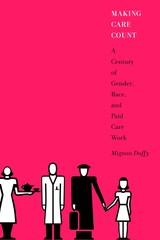 Making Care Count: A Century of Gender, Race, and Paid Care Work
Mignon Duffy
Rutgers University Press, 2011 There are fundamental tasks common to every society: children have to be raised, homes need to be cleaned, meals need to be prepared, and people who are elderly, ill, or disabled need care. Day in, day out, these responsibilities can involve both monotonous drudgery and untold rewards for those performing them, whether they are family members, friends, or paid workers. These are jobs that cannot be outsourced, because they involve the most intimate spaces of our everyday lives--our homes, our bodies, and our families. Mignon Duffy uses a historical and comparative approach to examine and critique the entire twentieth-century history of paid care work--including health care, education and child care, and social services--drawing on an in-depth analysis of U.S. Census data as well as a range of occupational histories. Making Care Count focuses on change and continuity in the social organization along with cultural construction of the labor of care and its relationship to gender, racial-ethnic, and class inequalities. Debunking popular understandings of how we came to be in a "care crisis," this book stands apart as an historical quantitative study in a literature crowded with contemporary, qualitative studies, proposing well-developed policy approaches that grow out of the theoretical and empirical arguments.
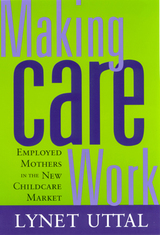 Making Care Work: Employed Mothers in the New Childcare Market
Uttal, Lynet
Rutgers University Press, 2002 As ever more women work outside the home, ever more families employ childcare workers. In the absence of government regulations or social models that clearly define the childcare provider’s role, mothers worry about the quality of care their children are getting. By connecting the personal level of mothers’ daily experiences to the larger political, economic, and ideological context of childcare, Lynet Uttal describes and explains how mothers rely on their relationship with the providers to monitor and influence the quality of care their children receive. Whereas other studies have emphasized how mothers undervalue and exploit providers, this book paints a more nuanced picture, arguing that the ties between adults who share in the care of children creates neither heroes nor victims. This ethnography reveals that mothers are often reluctant to discuss their concerns with their childcare providers. Uttal shows how mothers walk a fine line between wanting to believe in the quality of care they have chosen, and the fact that they might have made a mistake. Catalyzed by their worries about the quality of care, mothers develop complex relationships with the women—and most are women—who look after their children.
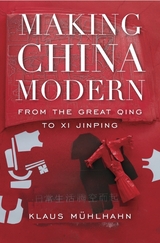 Making China Modern: From the Great Qing to Xi Jinping
Klaus Mühlhahn
Harvard University Press, 2019 “Thoughtful, probing…a worthy successor to the famous histories of Fairbank and Spence [that] will be read by all students and scholars of modern China.”
—William C. Kirby, coauthor of Can China Lead?
It is tempting to attribute the rise of China to Deng Xiaoping and to recent changes in economic policy. But China has a long history of creative adaptation. In the eighteenth century, the Qing Empire dominated a third of the world’s population. Then, as the Opium Wars and the Taiping Rebellion ripped the country apart, China found itself verging on free fall. More recently, after Mao, China managed a surprising recovery, rapidly undergoing profound economic and social change. A dynamic story of crisis and recovery, failure and triumph, Making China Modern explores the versatility and resourcefulness that guaranteed China’s survival, powered its rise, and will determine its future.
“Chronicles reforms, revolutions, and wars through the lens of institutions, often rebutting Western impressions.”
—New Yorker
“A remarkable accomplishment. Unlike an earlier generation of scholarship, Making China Modern does not treat China’s contemporary transformation as a postscript. It accepts China as a major and active player in the world, places China at the center of an interconnected and global network of engagement, links domestic politics to international dynamics, and seeks to approach China on its own terms.”
—Wen-hsin Yeh, author of Shanghai Splendor
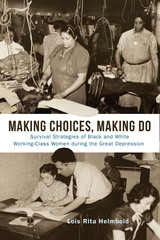 Making Choices, Making Do: Survival Strategies of Black and White Working-Class Women during the Great Depression
Lois Rita Helmbold
Rutgers University Press, 2023 Making Choices, Making Do is a comparative study of Black and white working-class women’s survival strategies during the Great Depression. Based on analysis of employment histories and Depression-era interviews of 1,340 women in Chicago, Cleveland, Philadelphia, and South Bend and letters from domestic workers, Lois Helmbold discovered that Black women lost work more rapidly and in greater proportions. The benefits that white women accrued because of structural racism meant they avoided the utter destitution that more commonly swallowed their Black peers. When let go from a job, a white woman was more successful in securing a less desirable job, while Black women, especially older Black women, were pushed out of the labor force entirely. Helmbold found that working-class women practiced the same strategies, but institutionalized racism in employment, housing, and relief assured that Black women worked harder, but fared worse. Making Choices, Making Do strives to fill the gap in the labor history of women, both Black and white. The book will challenge the limits of segregated histories and encourage more comparative analyses.
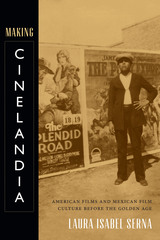 Making Cinelandia: American Films and Mexican Film Culture before the Golden Age
Laura Isabel Serna
Duke University Press, 2014 In the 1920s, as American films came to dominate Mexico's cinemas, many of its cultural and political elites feared that this "Yanqui invasion" would turn Mexico into a cultural vassal of the United States. In Making Cinelandia, Laura Isabel Serna contends that Hollywood films were not simply tools of cultural imperialism. Instead, they offered Mexicans on both sides of the border an imaginative and crucial means of participating in global modernity, even as these films and their producers and distributors frequently displayed anti-Mexican bias. Before the Golden Age of Mexican cinema, Mexican audiences used their encounters with American films to construct a national film culture. Drawing on extensive archival research, Serna explores the popular experience of cinemagoing from the perspective of exhibitors, cinema workers, journalists, censors, and fans, showing how Mexican audiences actively engaged with American films to identify more deeply with Mexico.
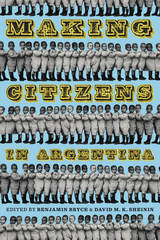 Making Citizens in Argentina
Benjamin Bryce
University of Pittsburgh Press, 2017 Making Citizens in Argentina charts the evolving meanings of citizenship in Argentina from the 1880s to the 1980s. Against the backdrop of immigration, science, race, sport, populist rule, and dictatorship, the contributors analyze the power of the Argentine state and other social actors to set the boundaries of citizenship. They also address how Argentines contested the meanings of citizenship over time, and demonstrate how citizenship came to represent a great deal more than nationality or voting rights. In Argentina, it defined a person’s relationships with, and expectations of, the state. Citizenship conditioned the rights and duties of Argentines and foreign nationals living in the country. Through the language of citizenship, Argentines explained to one another who belonged and who did not. In the cultural, moral, and social requirements of citizenship, groups with power often marginalized populations whose societal status was more tenuous. Making Citizens in Argentina also demonstrates how workers, politicians, elites, indigenous peoples, and others staked their own claims to citizenship.
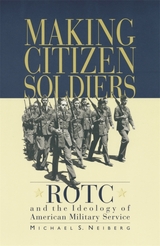 Making Citizen-Soldiers: ROTC and the Ideology of American Military Service
Michael S. Neiberg
Harvard University Press, 2001 This book examines the Reserve Officers Training Corps program as a distinctively American expression of the social, cultural, and political meanings of military service. Since 1950, ROTC has produced nearly two out of three American active duty officers, yet there has been no comprehensive scholarly look at civilian officer education programs in nearly forty years.
While most modern military systems educate and train junior officers at insular academies like West Point, only the United States has relied heavily on the active cooperation of its civilian colleges. Michael Neiberg argues that the creation of officer education programs on civilian campuses emanates from a traditional American belief (which he traces to the colonial period) in the active participation of civilians in military affairs. Although this ideology changed shape through the twentieth century, it never disappeared. During the Cold War military buildup, ROTC came to fill two roles: it provided the military with large numbers of well-educated officers, and it provided the nation with a military comprised of citizen-soldiers. Even during the Vietnam era, officers, university administrators, and most students understood ROTC's dual role. The Vietnam War thus led to reform, not abandonment, of ROTC.
Mining diverse sources, including military and university archives, Making Citizen-Soldiers provides an in-depth look at an important, but often overlooked, connection between the civilian and military spheres.
 Making Civilizations: The World before 600
Hans-Joachim Gehrke
Harvard University Press, 2020 Distinguished historians of the ancient world analyze the earliest developments in human history and the rise of the first major civilizations, from the Middle East to India and China.
In this volume of the six-part History of the World series, Hans-Joachim Gehrke, a noted scholar of ancient Greece, leads a distinguished group of historians in analyzing prehistory, the earliest human settlements, and the rise of the world’s first advanced civilizations.
The Neolithic period—sometimes called the Agrarian Revolution—marked a turning point in human history. People were no longer dependent entirely on hunting animals and gathering plants but instead cultivated crops and reared livestock. This led to a more settled existence, notably along rivers such as the Nile, Tigris, Euphrates, Ganges, and Yangzi. Increased mastery of metals, together with innovations in tools and technologies, led to economic specialization, from intricate crafts to deadlier weapons, which contributed to the growth of village communities as well as trade networks. Family was the fundamental social unit, its relationships and hierarchies modeled on the evolving relationship between ruler and ruled. Religion, whether polytheist or monotheist, played a central role in shaping civilizations from the Persians to the Israelites. The world was construed in terms of a divinely ordained order: the Chinese imperial title Huangdi expressed divinity and heavenly splendor, while Indian emperor Ashoka was heralded as the embodiment of moral law.
From the latest findings about the Neanderthals to the founding of imperial China to the world of Western classical antiquity, Making Civilizations offers an authoritative overview of humanity’s earliest eras.
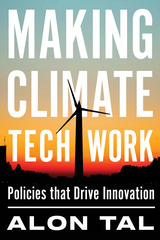 Making Climate Tech Work: Policies that Drive Innovation
Alon Tal
Island Press, 2024 Climate tech is critical for averting planetary chaos. Half the greenhouse gas reductions required to reach “net-zero” climate targets in 2050 will need to come from technologies that have not yet been invented. Without effective government interventions, market incentives alone will not produce a rapid transition to a low-carbon economy. The commercial value of innovative climate technology, especially in its early phases, remains underpriced—far below its social value. The good news is that smart policies can change these dynamics and catalyze the necessary creativity and investment in clean technology, and its deployment. The key question is: which approaches can lead us to future carbon neutrality, and which are likely to fall short?
In Making Climate Tech Work, environmental policy expert Alon Tal demystifies climate innovation programs around the world—no policy background needed. Beginning with a review of government’s general role in technology policy development, Tal assesses each policy alternative, describing eye-opening experiments in diverse countries, presenting a range of case studies, interviewing leading decarbonization experts, and interpreting new empirical data. Discover how Germany incentivized renewables; Denmark became a wind energy superpower; Australia phased out incandescent bulbs; California’s prisons pioneered low-carbon menus; and why carbon taxes have failed around the world—but could be designed for success.
Tal distills the benefits and drawbacks of each policy, along with related ethical questions and public perceptions. He concludes by addressing two commonly overlooked issues in climate policy: disruption of workers’ livelihoods from the clean energy transition; and integrating the Global South into the planet’s new low-carbon economy—as the region that has contributed least to climate change but which must be part of a global solution. Tal not only evaluates which policy strategies effectively reduce emissions but also how they can promote climate tech innovation.
Humanity is ultimately in a race against time and effective climate policies are critical to ensure a sustainable future. Making Climate Tech Work serves as an essential primer for policymakers, academics, activists, and anyone interested in climate solutions.
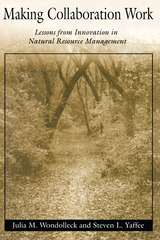 Making Collaboration Work: Lessons From Innovation In Natural Resource Managment
Julia M. Wondolleck and Steven L. Yaffee
Island Press, 2000 Across the United States, diverse groups are turning away from confrontation and toward collaboration in an attempt to tackle some of our nation's most intractable environmental problems. Government agencies, community groups, businesses, and private individuals have begun working together to solve common problems, resolve conflicts, and develop forward-thinking strategies for moving in a more sustainable direction. Making Collaboration Work examines those promising efforts. With a decade of research behind them, the authors offer an invaluable set of lessons on the role of collaboration in natural resource management and how to make it work. The book: - explains why collaboration is an essential component of resource management
- describes barriers that must be understood and overcome
- presents eight themes that characterize successful efforts
- details the specific ways that groups can use those themes to achieve success
- provides advice on how to ensure accountability
Drawing on lessons from nearly two hundred cases from around the country, the authors describe the experience in practical terms and offer specific advice for agencies and individuals interested in pursuing a collaborative approach. The images of success offered can provide ideas to those mired in traditional management styles and empower those seeking new approaches. While many of the examples involve natural resource professionals, the lessons hold true in a variety of public policy settings including public health, social services, and environmental protection, among others. Making Collaboration Work will be an invaluable source of ideas and inspiration for policy makers, managers and staff of government agencies and nongovernmental organizations, and community groups searching for more productive modes of interaction.
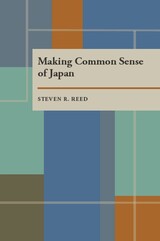 Making Common Sense of Japan
Steven R. Reed
University of Pittsburgh Press, 1993
Common misconceptions about Japan begin with the notion that it is a “small” country (it's actually lager than Great Britain, Germany or Italy) and end with pronouncements that the Japanese think differently and have different values-they do things differently because that's the way they are.
Steven Reed takes on the task of demystifying Japanese culture and behavior. Through examples that are familiar to an American audience and his own personal encounters with the Japanese, he argues that the apparent oddity of Japanese behavior flows quite naturally from certain objective conditions that are different from those in the United States.
Mystical allegations about national character are less useful for understanding a foreign culture than a close look at specific situations and conditions. Two aspects of the Japanese economy have particularly baffled Americans: that Japanese workers have “permanent employment” and that the Japanese government cooperates with big business. Reed explains these phenomena in common sense terms. He shows how they developed historically, why they continue, and why they helped produce economic growth. He concludes that these practices are not as different from what happens in the United States as they may appear.
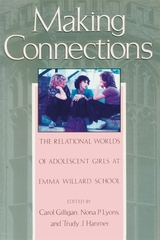 Making Connections: The Relational Worlds of Adolescent Girls at Emma Willard School
Carol Gilligan
Harvard University Press, 1990 Making Connections maps new territory in the field of psychology. The essays in this volume are “a series of exercises en route to a new psychology of adolescence and women…[and] part of a process that they also describe: of changing a tradition by including girls’ voices, of listening to girls and asking again about the meaning of self, relationship, and morality—concepts central to any psychology of human development… Each essay originated with a question that arose or became clarified in the experience of the research. No attempt has been made to unify these essays or to arrive at a central thesis, beyond the common intention to listen for the ways in which girls orchestrate themes of connection and separation and concerns about care and justice in speaking about themselves, about their relationships, and about experiences of conflict…
“When Women’s Studies is joined with the study of girls development it becomes clearer why adolescence is a critical time in girls’ lives—a time when girls are in danger of losing their voices and thus losing connection with others, and also a time when girls, gaining voice and knowledge, are in danger of knowing the unseen and speaking the unspoken and thus losing connection with what is commonly taken to be ‘reality.’ This crisis of connection in girls’ lives at adolescence links the psychology of women with the most basic questions about the nature of relationships and the definition of reality. Girls questions about relationships and about reality, however, also tug at women’s silences.”
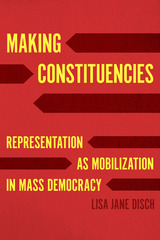 Making Constituencies: Representation as Mobilization in Mass Democracy
Lisa Jane Disch
University of Chicago Press, 2021 Public division is not new; in fact, it is the lifeblood of politics, and political representatives have constructed divisions throughout history to mobilize constituencies.
Since the turn of the twenty-first century, the idea of a divided United States has become commonplace. In the wake of the 2020 election, some commentators warned that the American public was the most divided it has been since the Civil War. Political scientists, political theorists, and public intellectuals have suggested that uninformed, misinformed, and disinformed voters are at the root of this division. Some are simply unwilling to accept facts or science, which makes them easy targets for elite manipulation. It also creates a grass-roots political culture that discourages cross-partisan collaboration in Washington.
Yet, manipulation of voters is not as grave a threat to democracy in America as many scholars and pundits make it out to be. The greater threat comes from a picture that partisans use to rally their supporters: that of an America sorted into opposing camps so deeply rooted that they cannot be shaken loose and remade. Making Constituencies proposes a new theory of representation as mobilization to argue that divisions like these are not inherent in society, but created, and political representatives of all kinds forge and deploy them to cultivate constituencies.
 Making Contact: Uses of Language in Psychotherapy
Leston Havens
Harvard University Press, 1986 Since 1955, moving from early work in psychopharmacology to studies of clinical method and the psychiatric schools, Leston Havens has been working toward a general theory of therapy. It often seems that twentieth-century psychiatry, sect-ridden, is a Tower of Babel, as Havens once characterized it. This book is the distillation of long years of thought and practice, a bold yet modest attempt to delineate an “integrated psychotherapy.”
The boldness of this effort lies in its author’s willingness to recognize the best that each school has to offer, to describe it cogently, and to integrate it into a full response to today’s new kind of patient. Descriptive or medical psychiatry, psychoanalysis, interpersonal or behavioristic psychiatry, empathic or existential therapy-viewed in metaphors, respectively, of perceiving, thinking, managing, feeling-all have useful contributions to make to contemporary methods of treatment. But how? Havens’s modest answer is through appropriate language, and he demonstrates exactly what he means: when to ask questions, when to direct or draw back, when to sympathize.
Practitioners now must deal with less dramatic, but more stubborn, problems of character and situation; lack of purpose, isolation, submissiveness, invasiveness, deep yet vague dissatisfaction. Some kind of human presence must be discovered in the patient, and Havens gives concrete, absorbing examples of ways of “speaking to absence,” of making contact. The emphasis is on verbal technique, but the underlying broad, humane intent is everywhere evident. It is no less than to transform passivity, by means of disciplined therapeutic concern, into a state of being Human.
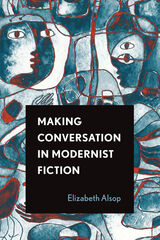 Making Conversation in Modernist Fiction
Elizabeth Alsop
Ohio State University Press, 2019 Making Conversation in Modernist Fiction examines the role of character dialogue in key works of Anglo-American modernism. Through close analysis of texts including The Ambassadors, The Sun Also Rises, “The Dead,” The Sound and the Fury, Absalom, Absalom!, The Waves, Between the Acts, “Melanctha,” and Cane, the book documents the ways in which some of the most canonical British and American modernist authors transformed the conventions traditionally used to render talk in fiction.
If historically dialogue had been treated as a subordinate element in fiction—a tool for developing character or advancing plot—this book demonstrates that writers such as Henry James, Ernest Hemingway, James Joyce, William Faulkner, Virginia Woolf, and Gertrude Stein would increasingly emphasize it as a poetic structure in its own right. In this way, Alsop argues, modernist writers “make” conversation in radically new ways and for a diverse range of expressive and communicative ends. Over the course of five chapters that explore this previously overlooked avenue of modernist innovation, Making Conversation offers readers a radical new paradigm not only for understanding fictional talk but also for interpreting some of the most celebrated examples of early twentieth-century narrative.
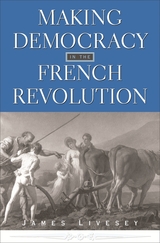 Making Democracy in the French Revolution
James Livesey
Harvard University Press, 2001 This book reasserts the importance of the French Revolution to an understanding of the nature of modern European politics and social life. Scholars currently argue that the French Revolution did not significantly contribute to the development of modern political values. They no longer hold that the study of the Revolution offers any particular insight into the dynamics of historical change. James Livesey contends that contemporary historical study is devalued through this misinterpretation of the French Revolution and offers an alternative approach and a new thesis.
Livesey argues that the European model of democracy was created in the Revolution, a model with very specific commitments that differentiate it from Anglo-American liberal democracy. The fundamental argument in the book is that these democratic values were created by identifiable actors seeking to answer political, economic, and social problems. The book traces the development of this democratic idea within the structures of the French Republic and the manner in which the democratic aspiration moved beyond formal politics to become embedded in institutions of economic and cultural life. This innovative work rewrites the history of French politics between 1795 and 1799.
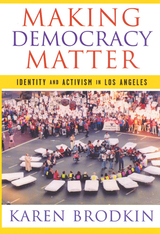 Making Democracy Matter: Identity and Activism in Los Angeles
Brodkin, Karen
Rutgers University Press, 2007 What makes a social movement a movement? Where do the contagious energy, vision, and sense of infinite possibility come from? Students of progressive social movements know a good deal about what works and what doesn't and about the constituencies that are conducive to political activism, but what are the personal and emotional dynamics that turn ordinary people into activists? And, what are the visions and practices of democracy that foster such transformations?
This book seeks to answer these questions through conversations and interviews with a generation of activists who came of political age in Los Angeles during the 1990s. Politically schooled in the city's vibrant immigrant worker and youth-led campaigns against xenophobic and racist voter initiatives, these young activists created a new political cohort with its own signature of democratic practice and vision. Combining analytical depth, engaging oral history, and rich description, this absorbing and accessible book will appeal to all those interested in social movements, racial justice, the political activism of women and men of color, and the labor movement today.
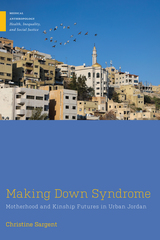 Making Down Syndrome: Motherhood and Kinship Futures in Urban Jordan
Christine Sargent
Rutgers University Press, 2026 Making Down Syndrome: Motherhood and Kinship Futures in Urban Jordan draws on ethnographic research conducted primarily in Jordan’s capital city of Amman to explore how the label and identity of Down syndrome is gaining increasing cohesiveness. Focused on the experiences of mothers, who serve as an entry point for understanding broader family dynamics and choices, the book argues that practices and ideologies of care play a central role in making Down syndrome’s embodied and political realities. They do so through the momentum of kinship futures, or futures imagined through the prism of kinship roles and relations, which shape how families organize and distribute care between and beyond kinship networks and under conditions of economic and political uncertainty. By approaching everyday life in Jordan through the lens of disability, Making Down Syndrome offers new insights into how people navigate structures of family, gender, power, inequality, and precarity, all while trying to maintain hope for and cultivate better futures.
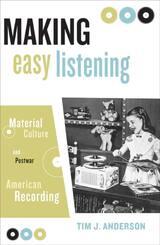 Making Easy Listening: Material Culture and Postwar American Recording
Tim Anderson
University of Minnesota Press, 2006 The period between the Second World War and the mid-1960s saw the American music industry engaged in a fundamental transformation in how music was produced and experienced. Tim Anderson analyzes three sites of this music revolution: the change from a business centered around live performances to one based on selling records, the custom of simultaneously bringing out multiple versions of the same song, and the arrival of in-home high-fidelity stereo systems.
Making Easy Listening presents a social and cultural history of the contentious, diverse, and experimental culture of musical production and enjoyment that aims to understand how recording technologies fit into and influence musicians’, as well as listeners’, lives. With attention to the details of what it means to play a particular record in a distinct cultural context, Anderson connects neglected genres of the musical canon—classical and easy listening music, Broadway musicals, and sound effects records—with the development of sound aesthetics and technical music practices that leave an indelible imprint on individuals. Tracing the countless impacts that this period of innovation exacted on the mass media, Anderson reveals how an examination of this historical era—and recorded music as an object—furthers a deeper understanding of the present-day American music industry.
Tim J. Anderson is assistant professor of communication at Denison University.
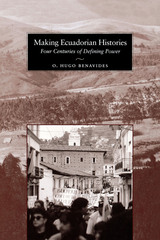 Making Ecuadorian Histories: Four Centuries of Defining Power
By O. Hugo Benavides
University of Texas Press, 2004 In Ecuador, as in all countries, archaeology and history play fundamental roles in defining national identity. Connecting with the prehistoric and historic pasts gives the modern state legitimacy and power. But the state is not the only actor that lays claim to the country's archaeological patrimony, nor is its official history the only version of the story. Indigenous peoples are increasingly drawing on the past to claim their rights and standing in the modern Ecuadorian state, while the press tries to present a "neutral" version of history that will satisfy its various publics. This pathfinding book investigates how archaeological knowledge is used for both maintaining and contesting nation-building and state-hegemony in Ecuador. Specifically, Hugo Benavides analyzes how the pre-Hispanic site of Cochasquí has become a source of competing narratives of Native American, Spanish, and Ecuadorian occupations, which serve the differing needs of the nation-state and different national populations at large. He also analyzes the Indian movement itself and the recent controversy over the final resting place for the traditional monolith of San Biritute. Offering a more nuanced view of the production of history than previous studies, Benavides demonstrates how both official and resistance narratives are constantly reproduced and embodied within the nation-state's dominant discourses.
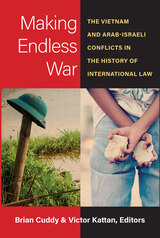 Making Endless War: The Vietnam and Arab-Israeli Conflicts in the History of International Law
Brian Cuddy and Victor Kattan, Editors
University of Michigan Press, 2023 Making Endless War is built on the premise that any attempt to understand how the content and function of the laws of war changed in the second half of the twentieth century should consider two major armed conflicts, fought on opposite edges of Asia, and the legal pathways that link them together across time and space. The Vietnam and Arab-Israeli conflicts have been particularly significant in the shaping and attempted remaking of international law from 1945 right through to the present day. This carefully curated collection of essays by lawyers, historians, philosophers, sociologists, and political geographers of war explores the significance of these two conflicts, including their impact on the politics and culture of the world’s most powerful nation, the United States of America. The volume foregrounds attempts to develop legal rationales for the continued waging of war after 1945 by moving beyond explaining the end of war as a legal institution, and toward understanding the attempted institutionalization of endless war.
Making Ends Meet: Farm Women's Work in Manitoba
Charlotte van de Vorst
University of Manitoba Press, 2002 Based on hundreds of interviews with Manitoba farm men and women, Making Ends Meet reconstructs the common history shared by modern farm women as well as by their mothers and grandmothers. It explores women's changing roles on the farm, from the early days of the Red River settlement to the twentieth-century farm community. The women's own stories reveal their ingenuity and tenacity in "making ends meet" through economies, shared, labour, and generation of new resource income as varied as raising poultry and custom woodworking. These stories prove that the contributions of farm women have been vital in establishing and maintaining the family farm, and are critical to its continued survival.
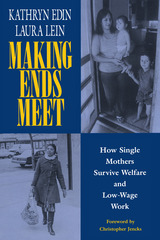 Making Ends Meet: How Single Mothers Survive Welfare and Low-Wage Work
Kathryn Edin
Russell Sage Foundation, 1997 Welfare mothers are popularly viewed as passively dependent on their checks and averse to work. Reformers across the political spectrum advocate moving these women off the welfare rolls and into the labor force as the solution to their problems. Making Ends Meet offers dramatic evidence toward a different conclusion: In the present labor market, unskilled single mothers who hold jobs are frequently worse off than those on welfare, and neither welfare nor low-wage employment alone will support a family at subsistence levels. Kathryn Edin and Laura Lein interviewed nearly four hundred welfare and low-income single mothers from cities in Massachusetts, Texas, Illinois, and South Carolina over a six year period. They learned the reality of these mothers' struggles to provide for their families: where their money comes from, what they spend it on, how they cope with their children's needs, and what hardships they suffer. Edin and Lein's careful budgetary analyses reveal that even a full range of welfare benefits—AFDC payments, food stamps, Medicaid, and housing subsidies—typically meet only three-fifths of a family's needs, and that funds for adequate food, clothing and other necessities are often lacking. Leaving welfare for work offers little hope for improvement, and in many cases threatens even greater hardship. Jobs for unskilled and semi-skilled women provide meager salaries, irregular or uncertain hours, frequent layoffs, and no promise of advancement. Mothers who work not only assume extra child care, medical, and transportation expenses but are also deprived of many of the housing and educational subsidies available to those on welfare. Regardless of whether they are on welfare or employed, virtually all these single mothers need to supplement their income with menial, off-the-books work and intermittent contributions from family, live-in boyfriends, their children's fathers, and local charities. In doing so, they pay a heavy price. Welfare mothers must work covertly to avoid losing benefits, while working mothers are forced to sacrifice even more time with their children. Making Ends Meet demonstrates compellingly why the choice between welfare and work is more complex and risky than is commonly recognized by politicians, the media, or the public. Almost all the welfare-reliant women interviewed by Edin and Lein made repeated efforts to leave welfare for work, only to be forced to return when they lost their jobs, a child became ill, or they could not cover their bills with their wages. Mothers who managed more stable employment usually benefited from a variety of mitigating circumstances such as having a relative willing to watch their children for free, regular child support payments, or very low housing, medical, or commuting costs. With first hand accounts and detailed financial data, Making Ends Meet tells the real story of the challenges, hardships, and survival strategies of America's poorest families. If this country's efforts to improve the self-sufficiency of female-headed families is to succeed, reformers will need to move beyond the myths of welfare dependency and deal with the hard realities of an unrewarding American labor market, the lack of affordable health insurance and child care for single mothers who work, and the true cost of subsistence living. Making Ends Meet is a realistic look at a world that so many would change and so few understand.
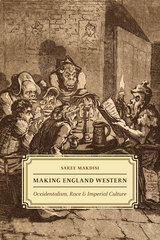 Making England Western: Occidentalism, Race, and Imperial Culture
Saree Makdisi
University of Chicago Press, 2013 The central argument of Edward Said’s Orientalism is that the relationship between Britain and its colonies was primarily oppositional, based on contrasts between conquest abroad and domestic order at home. Saree Makdisi directly challenges that premise in Making England Western, identifying the convergence between the British Empire’s civilizing mission abroad and a parallel mission within England itself, and pointing to Romanticism as one of the key sites of resistance to the imperial culture in Britain after 1815. Makdisi argues that there existed places and populations in both England and the colonies that were thought of in similar terms—for example, there were sites in England that might as well have been Arabia, and English people to whom the idea of the freeborn Englishman did not extend. The boundaries between “us” and “them” began to take form during the Romantic period, when England became a desirable Occidental space, connected with but superior to distant lands. Delving into the works of Wordsworth, Austen, Byron, Dickens, and others to trace an arc of celebration, ambivalence, and criticism influenced by these imperial dynamics, Makdisi demonstrates the extent to which Romanticism offered both hopes for and warnings against future developments in Occidentalism. Revealing that Romanticism provided a way to resist imperial logic about improvement and moral virtue, Making England Western is an exciting contribution to the study of both British literature and colonialism.
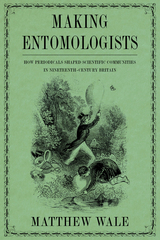 Making Entomologists: How Periodicals Shaped Scientific Communities in Nineteenth-Century Britain
Matthew Wale
University of Pittsburgh Press, 2022 Popular natural history periodicals in the nineteenth century had an incredible democratizing power. By welcoming contributions from correspondents regardless of their background, they posed a significant threat to those who considered themselves to be gatekeepers of elite science, and who in turn used their own periodicals to shape more exclusive communities. Making Entomologists reassesses the landscape of science participation in the nineteenth century, offering a more nuanced analysis of the supposed amateur-professional divide that resonates with the rise of citizen science today. Matthew Wale reveals how an increase in popular natural history periodicals during the nineteenth century was instrumental in shaping not only the life sciences and the field of entomology but also scientific communities that otherwise could not have existed. These publications enabled many actors—from wealthy gentlemen of science to working-class naturalists—to participate more fully within an extended network of fellow practitioners and, crucially, imagine themselves as part of a wider community. Women were also active participants in these groups, although in far smaller numbers than men. Although periodicals of the nineteenth century have received considerable scholarly attention, this study focuses specifically on the journals and magazines devoted to natural history.
|
|
